How to Make a Resume in 2024 | Beginner's Guide

For most job-seekers, a good resume is what stands between a dream job and Choice D. Get your resume right, and you’ll be getting replies from every other company you apply to.
If your resume game is weak, though, you’ll end up sitting around for weeks, maybe even months, before you even get a single response.
So you’re probably wondering how you can write a resume that gets you an interview straight up.
Well, you’ve come to the right place!
In this guide, we’re going to teach you everything you need to know about how to make a resume, including:
- The 8 Essential Steps to Writing a Resume
- 11+ Exclusive Resume Tips to Up Your Resume Game
- 27+ Real-Life Resume Examples for Different Professions
….and more!
So, let’s dive right in.

How to Make a Resume (The Right Way!)
Before we go into detail about how you should make a resume, here’s a summary of the most important steps and tips to keep in mind:
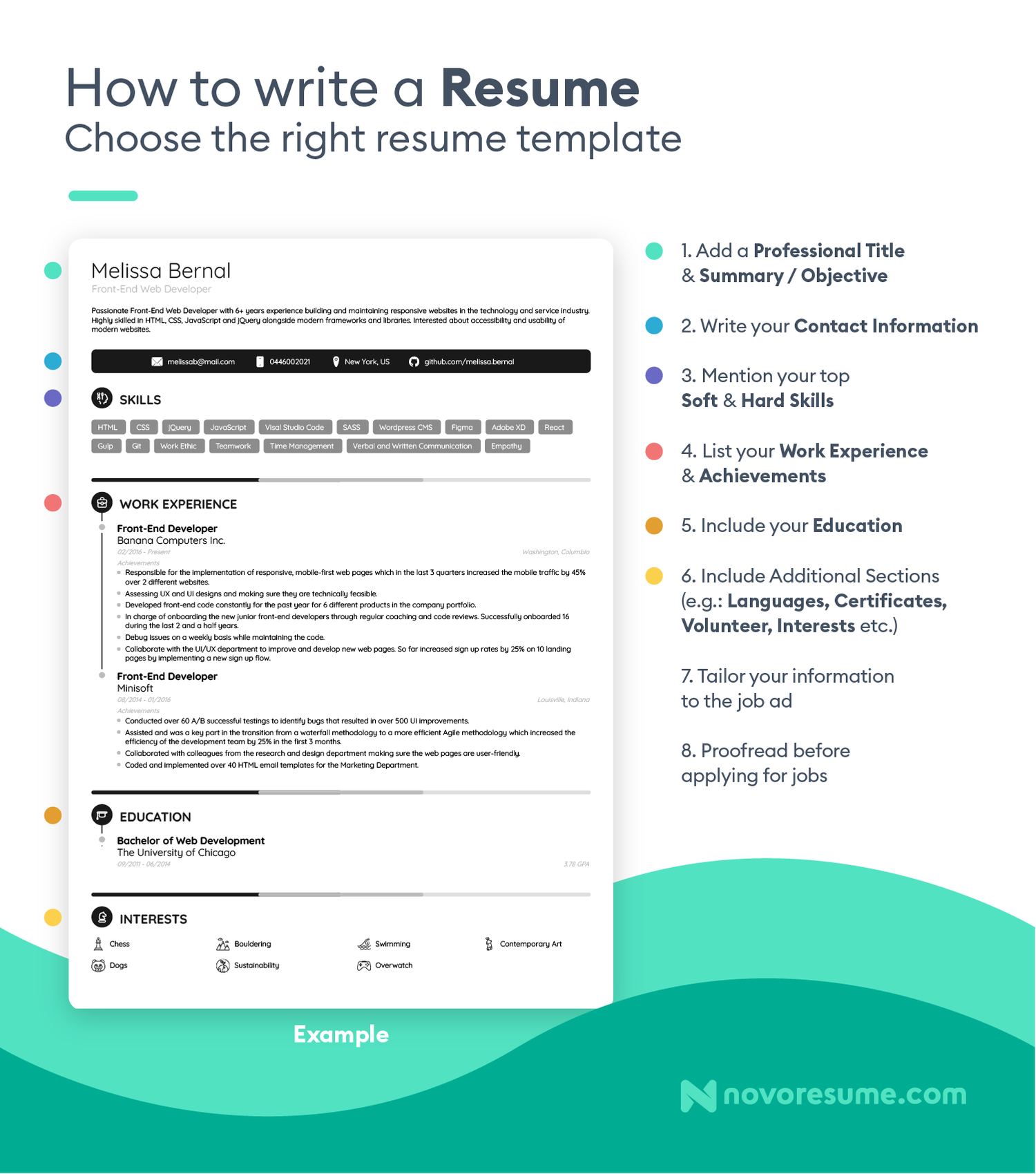
- Choose a resume format carefully. In 99% of cases, we recommend the reverse-chronological format .
- Add the right contact details. Leave your headshot out and make sure to include your job title , a professional email address, and any relevant links. (E.g.: your LinkedIn profile , online portfolio, personal website, etc.).
- Write an impactful resume summary. Unless you’re an entry-level professional, always go for a resume summary. If you do it right, it’s your chance to get the hiring manager to go through the rest of your resume in detail.
- Pay attention to your work experience section. Take your work experience section from OK-ish to exceptional by tailoring it to the job ad, making your achievements quantifiable, and using action verbs and power words.
- Add the right skills for the job. Keep this section relevant by only including the hard and soft skills that are required for the position.
- Keep your education short and to the point. Your most recent and highest degree is more than enough for a strong education section. You only need to add more details here if you’re a recent graduate with barely any work experience.
- Leverage optional resume sections. Optional sections like languages, hobbies, certifications, independent projects, and others can set you apart from other candidates with similar skills and experience.
- Include a cover letter. That’s right, cover letters matter in 2024, and the best way to supplement your resume is by adding an equally well-crafted cover letter to your job application. To make the most of it, check out our detailed guide on how to write a cover letter .
To get the most out of our tips, you can head over to the resume builder and start building your resume on the go as you read this guide.
New to resume-making? Give our ‘7 Resume Tips’ video a watch before diving into the article!
#1. Pick the Right Resume Format
Before you start filling in the contents of your resume, you have to make sure it’s going to look good.
After all, the first thing hiring managers notice is what your resume looks like, and then they start reading it. So, this is your best chance to make a great first impression.
Start by choosing the right resume format.
There are three types of resume formats out there:
- Reverse-chronological. This is by far the most popular resume format worldwide and, as such, it’s the best format for most job-seekers.
- Functional. This resume format focuses more on skills than work experience. It’s a good choice if you’re just getting started with your career and have little to no experience in the field.
- Combination. The combination resume format is a great choice for experienced job-seekers with a very diverse skill set. It’s useful if you’re applying for a role that requires expertise in several different fields and you want to show all that in your resume.
So, which one should you go for?
In 99% of cases, you want to stick to the reverse-chronological resume format . It’s the most popular format and what hiring managers expect to see. So, in the rest of this guide, we’re going to focus on teaching you how to make a reverse-chronological resume.
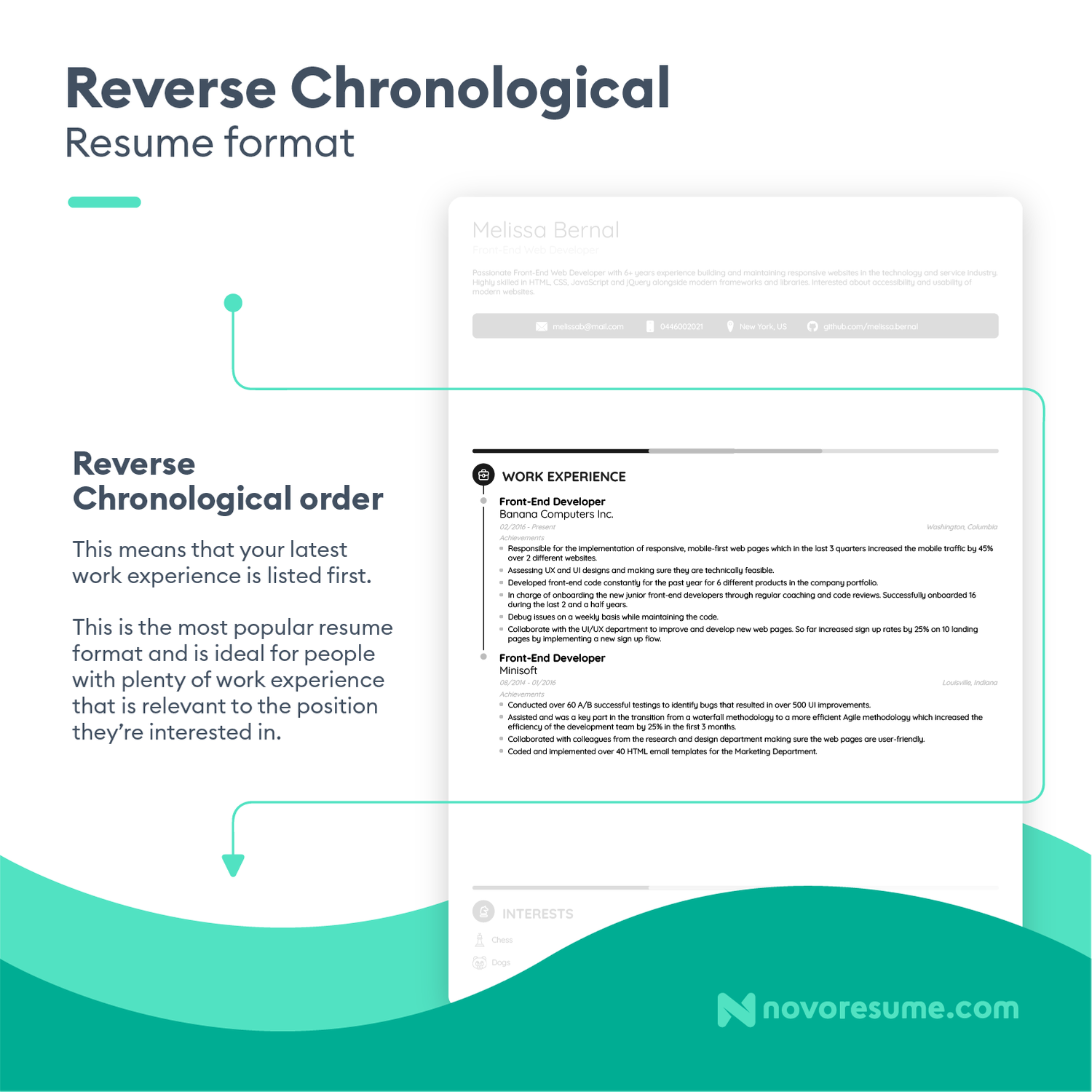
Fix Your Resume’s Layout
With formatting out of the way, let’s talk about your resume’s layout , which determines the overall look of your resume.
Does it look organized or cluttered? Is it too short or too long? Is it boring and easy to ignore, or is it reader-friendly and attention-grabbing?
Here are some of the best practices you should apply:
- Stick to one page. You should only go for a two-page resume if you have decades of experience and you’re sure the extra space will add significant value. Hiring managers in big companies get hundreds of applications per job opening. They’re not going to spend their valuable time reading your life story!
- Add clear section headings. Pick a heading and use it for all the section headers so the hiring manager can easily navigate through your resume.
- Adjust the margins. Without the right amount of white space, your resume will end up looking overcrowded with information. Set your margins to one inch on all sides so your text fits just right on the page.
- Choose a professional font. We’d recommend sticking to a font that’s professional but not overused. For example, Ubuntu, Roboto, or Overpass. Avoid Times New Roman, and never use Comic Sans.
- Set the correct font size. As a rule of thumb, go for 11-12 pt for normal text and 14-16 pt for section titles.
- Use a PDF file. Always save your resume as a PDF file, unless the employer specifically requests otherwise. Word files are popular, but there’s a good chance they’ll mess up your resume’s formatting.
Another thing you need to consider in terms of your resume’s layout is whether you’re going for a traditional-looking resume template or something a bit more modern :
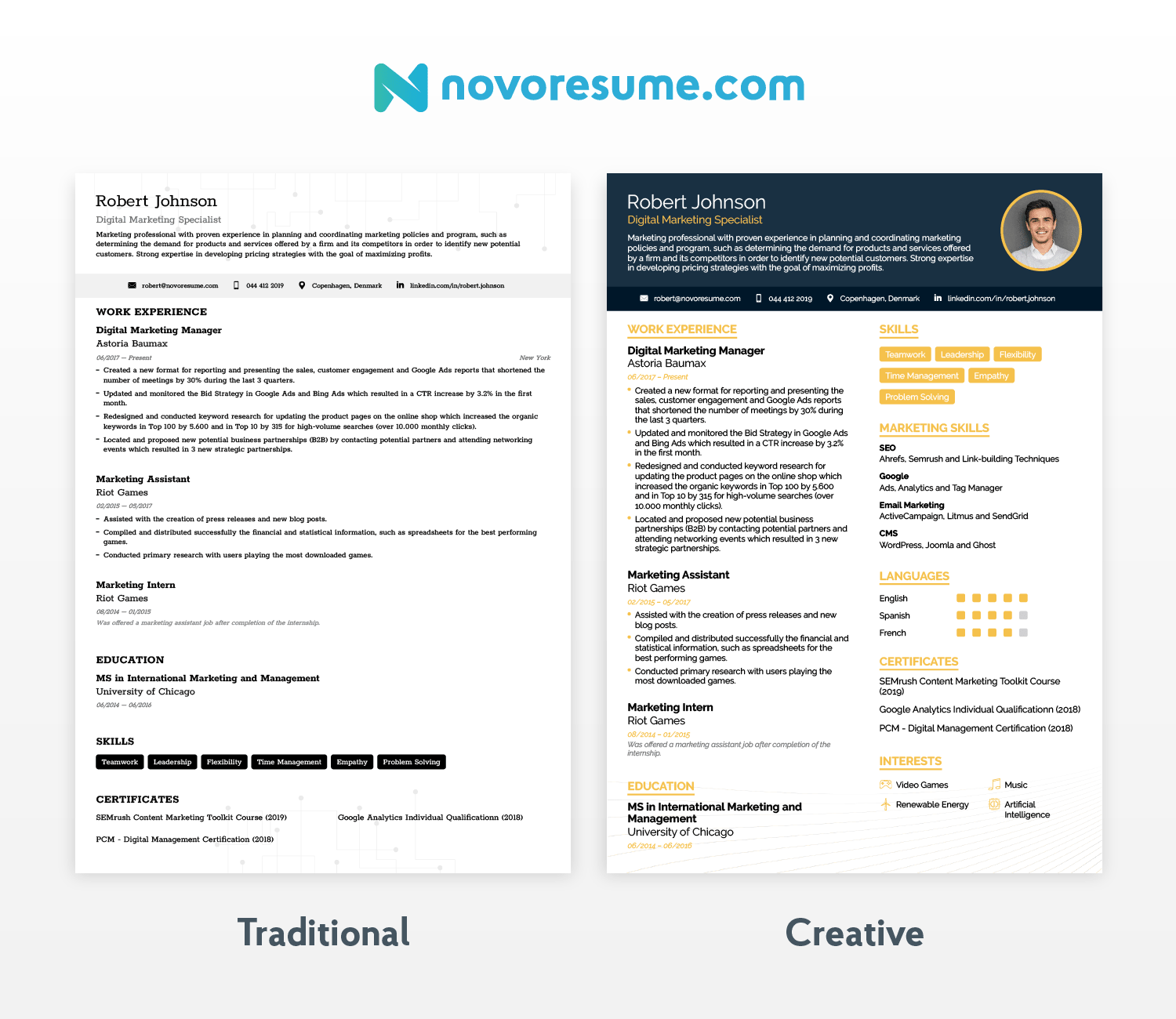
If you’re pursuing a career in a more traditional industry, like law , banking , or finance , you might want to stick to the first.
But if you’re applying to a tech company where imagination and innovation are valued, you can pick a more creative resume template .
Want to Save Time? Use a (Free) Resume Template
Anyone who’s ever tried creating a resume from scratch knows how boring the formatting can be.
Before you can even start filling in the contents, you need to tweak the margins, adjust font sizes, and make sure everything fits into one page while still looking good.
What if you could skip past all that and still create a compelling resume?
Try one of our free resume templates . They’re pre-formatted, so all you have to do is fill in the contents.
They’re also created in collaboration with recruiters from around the globe, ensuring that the templates are visually appealing and ATS-friendly!
See for yourself how one of our templates compares to a resume created in a standard text editor:

#2. Add Your Contact Information
Now that we’ve got all the formatting out of the way, let’s get into what your resume is all about— the information you put on it .
The first thing you want to do when filling out the contents of your resume is to add your contact information .
This section is pretty straightforward but crucial. Your contact details belong at the top of your resume in a designated resume header , so the hiring manager can easily find them.
Even if everything else about your resume is perfect, that all flops if you misspell your email address or have a typo in your phone number. If the hiring manager can’t contact you, it’s a missed opportunity.
So, double-check, and even triple-check your contact information section and make sure everything is factually correct and up-to-date.
Must-Have Information
- Full name. Your first and last name should stand out at the top of your resume.
- Email address. Stick to an address that’s professional and easy to spell, like a combination of your first and last name. (E.g.: [email protected])
- Phone number. Add a reliable number where the hiring manager can easily reach you.
- Location. Add your city and state/country. If you plan to relocate for the job or want a remote position, specify it on your resume.
Optional Information
- Job title. Add your professional title underneath. Write it down word for word, whether it’s “Digital Marketing Specialist” or “Junior Data Scientist.” Just don’t make up job titles like “Marketing Wizzard” or “Data Manipulator.” They’re not quirky; they’re just unprofessional.
- LinkedIn profile . We recommend that you include a link to your updated LinkedIn profile since over 77% of hiring managers use the platform when evaluating a candidate.
- Relevant links. Include links to personal websites or any social media profiles that are relevant to your field. For example, a developer could include a Github profile, while a graphic designer could link their Behance or Driblle account, and so on.
- Date of birth. Unless this is specifically required in the job ad, the hiring manager doesn’t need to know how old you are. It’s not important for their decision-making, and at worst, it might lead to age-based discrimination.
- Unprofessional email address. Your quirky, old high school email address doesn’t belong on your resume. Instead of [email protected] , go for a [email protected] type of address.
- Headshot. (USA, UK or Ireland) Depending on the country where you’re applying, it might even be illegal to include a picture of yourself on your resume . While it’s the norm to include a picture in most of Europe and Asia, always check the regulations for each specific country or industry you’re applying to.
All clear? Good! Now, let’s look at what a great example of a resume's contact information section looks like:
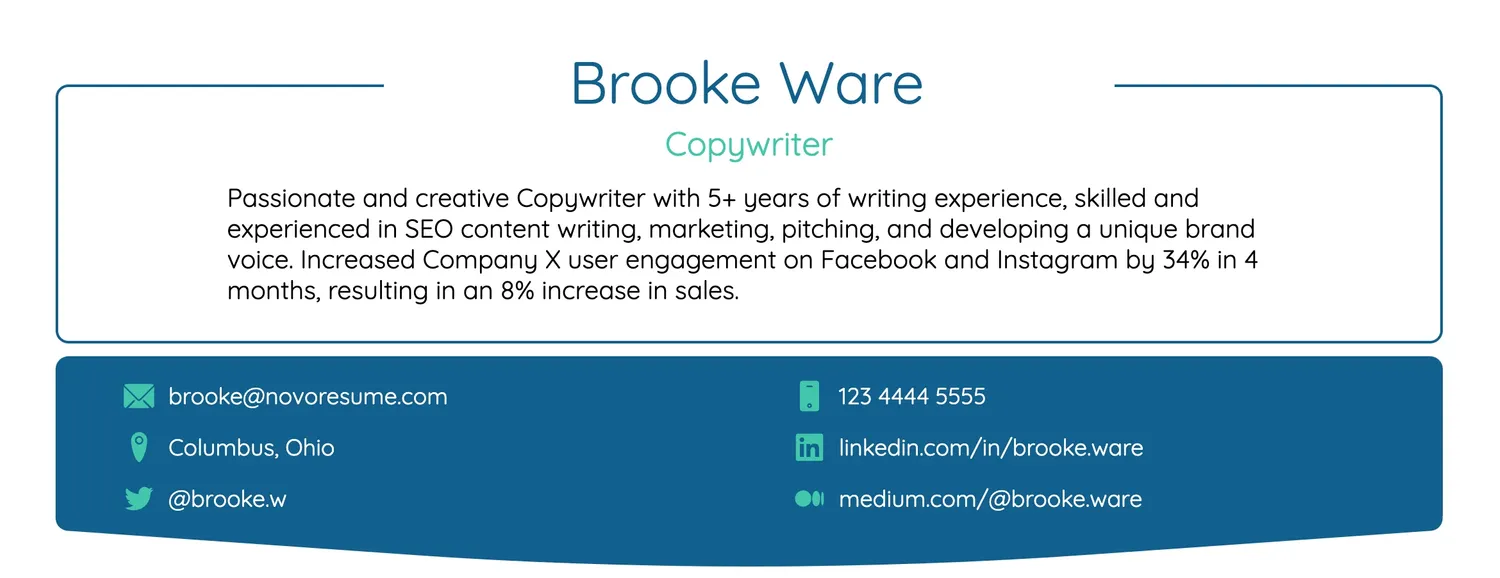
#3. Write a Resume Headline (Summary or Objective)
It's no secret that recruiters spend an average of less than seven seconds on a resume .
When you receive hundreds, if not thousands, of applications daily, it's physically impossible to spend too much time on each.
So, what the hiring managers do to go through resumes more effectively is to skim through each resume and read it in depth only if it piques their interest.
This is where the resume headline comes in.
Placed right next to (or underneath) your contact information, this brief paragraph is the first thing the hiring manager is going to read on your resume.
Now, depending on how far along in your career you are, your resume headline can be either a resume summary or a resume objective.

So, how do you choose between a resume summary and a resume objective? Here’s all you need to know:
Resume Summary
A resume summary, as the name suggests, is a two to three-sentence summary of your career so far. If done right, it shows that you’re a qualified candidate at a glance and gets the hiring manager to give you a chance.
Here’s what your resume summary should include:
- Your job title and years of experience.
- A couple of your greatest professional achievements or core responsibilities.
- Your most relevant skills for the job.
Here’s an example of a well-written resume summary:
Experienced Java Developer with 5 years of experience in building scalable and efficient applications. Contributed to a major project that enhanced application performance by 25%. Strong background in Spring Framework and microservices. Aiming to apply robust coding skills to develop innovative software solutions at XYZ Tech Solutions.
Unless you’re a recent graduate or amid a career change, we recommend you stick to a resume summary. Otherwise, a resume objective might be a better option for you.
Resume Objective
A resume objective is supposed to express your professional goals and aspirations, academic background, and any relevant skills you may have for the job.
It communicates your motivation for getting into a new field, so it’s the go-to headline for recent graduates and those going through a career change. As with a resume summary, a resume objective should be brief—around two to four sentences long.
So, here’s what it would look like if you’re a student:
Hard-working recent graduate with a B.A. in Graphic Design from New York State University seeking new opportunities. 3+ years of practical experience working with Adobe Illustrator and Photoshop, creating illustrations and UX/UI design projects. Looking to grow as a designer and perfect my art at XYZ Design Studio.
Or, on the other hand, if you’re going through a career change, it might look more like this:
IT project manager with 5+ years of experience in software development. Managed a team of developers to create products for several industries, such as FinTech and HR tech. Looking to leverage my experience in managing outsourced products as a Product Owner at Company XYZ.
#4. Prioritize Your Work Experience
The most important part of your resume is your work experience.
This is where you get to sell yourself and show off your previous accomplishments and responsibilities.
If you manage to master this section, you’ll know most of what’s there to know about how to make a resume.
There are plenty of good practices for writing your work experience . But before we dive into all the nits and grits, let's start with the basics.
The standard format for each work experience entry is as follows:
- Job title/position. Your job title goes on top of each work experience entry. When the hiring manager looks at your resume, you want them to know, at a glance, that you have relevant work experience for the job.
- Company name/location/description. Mention the name of the employer and the general location, such as the city and state/country where you worked. In some cases, you may also want to briefly describe the company, like when the organization isn’t particularly well-known.
- Dates employed. Add the approximate timeframe of your employment at each company. You don’t need to give exact dates since the standard format for this is mm/yyyy.
- Achievements and responsibilities. This is the core of each work experience entry. Depending on your field, you want to list either your achievements or responsibilities. List them in bullet points instead of paragraphs, so they’ll be easier to read.
Here’s a real-life example:
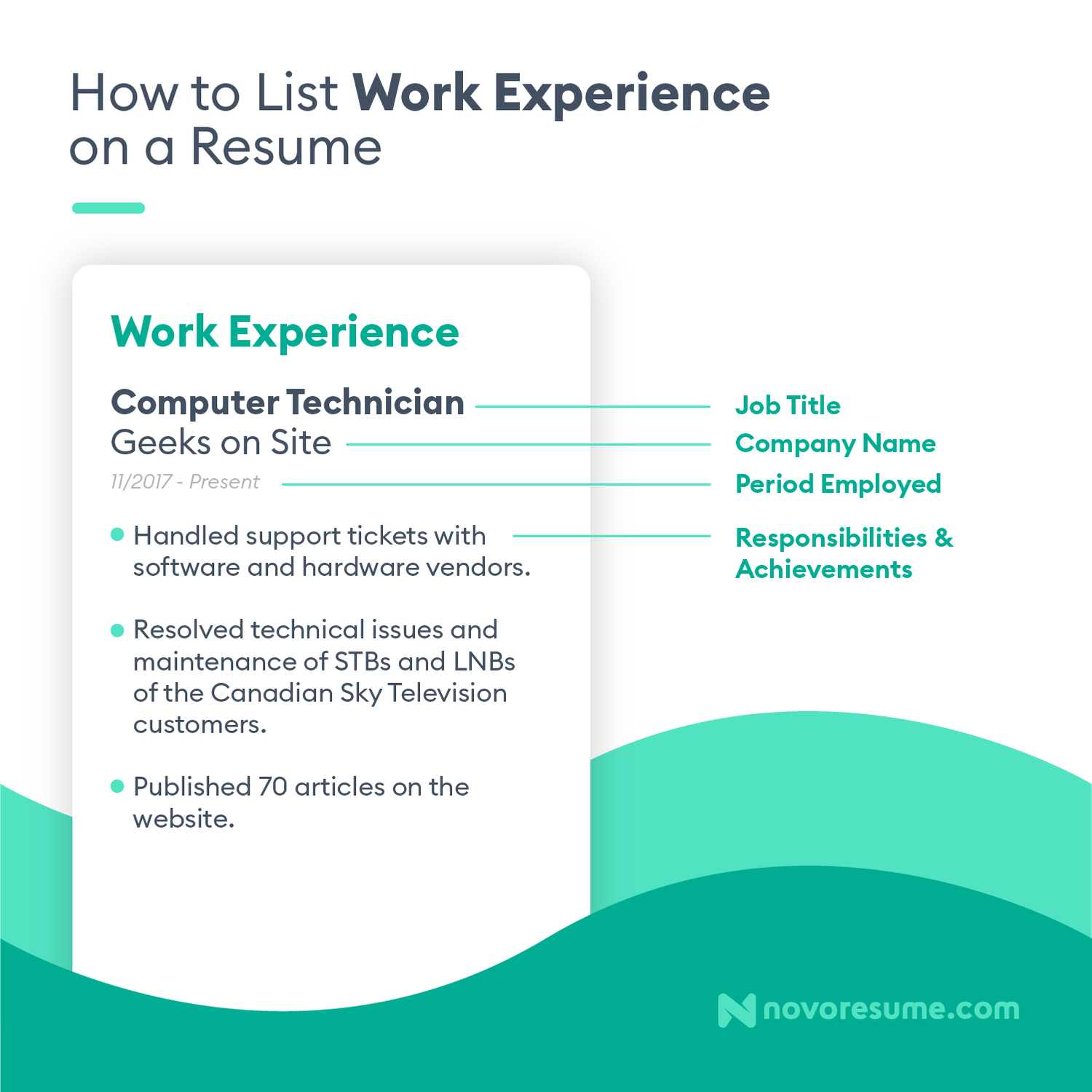
Your work experience entries should always be listed in reverse chronological order , starting with your most recent job and working your way back into the past.
Now that you know how to list your experience, we’re going to show you how to write about it in a way that makes you stand out from the competition, starting with:
Are you a student with no work experience? We’ve got you covered. Check out our guide to writing a resume with no experience here.
Focus on Achievements Whenever Possible
One of the most common resume mistakes is only listing responsibilities in your work experience section.
Here’s the thing—in most cases, the hiring manager knows exactly what your job responsibilities are.
For example, if you’re a sales manager, your responsibilities would be:
- Reach out to potential clients over the phone or email.
- Maintain relationships with existing company clients and upsell relevant products.
- Tracking and reporting on leads in CRM.
Coincidentally, this is also the same list of responsibilities for every sales manager out there. So, 90% of all other resumes probably mention the same thing.
To stand out from the competition, you want to focus on writing achievements in your resume instead. These can be how you helped your previous company grow, reach quarterly quotas, and so on.
Let’s compare how responsibilities hold up next to achievements for the same job:
- Exceeded sales team KPIs by 30%+ for 3 months straight.
- Generated over $24,000 in sales in 1 month.
- Generated leads through cold-calling
- Managed existing company clients
Keep in mind, though, that in some fields, there just aren’t that many achievements you can mention. Let’s say you’re a warehouse worker .
Your day-to-day responsibilities probably include:
- Loading, unloading, and setting up equipment daily.
- Packaging finished products and getting them ready for shipping.
- Assisting in opening and closing the warehouse.
In fields like this, it’s pretty hard to distinguish yourself through achievements, so it’s okay to stick to responsibilities instead. You can still make them shine by following the rest of our advice about listing your work experience.
Keep in mind, though, that in some fields, there aren’t that many achievements you can mention. Let’s say you work in a warehouse. Your day-to-day responsibilities probably involve:
- Loading, unloading and setting up equipment on a daily basis.
- Package finished product and get it ready for shipping.
- Assist in opening and closing the warehouse.
In such fields, it’s pretty hard to distinguish yourself, so it’s totally OK to stick to responsibilities instead.
Tailor Your Resume to the Job
Tailoring is what sets an amazing resume apart from an okay one.
Hiring managers don’t need to know about every single job you’ve ever worked at or every single skill that you have.
They only want to know about your jobs, experiences, or skills that are relevant to the role you’re applying for.
For example, if you’re applying for a job doing Google Ads, you don’t need to talk about your SEO internship from eight years ago.
By focusing your resume on whatever is important for the specific role, you’re a lot more likely to stand out and catch the hiring manager’s attention.
Let’s take a look at an example of a job ad:
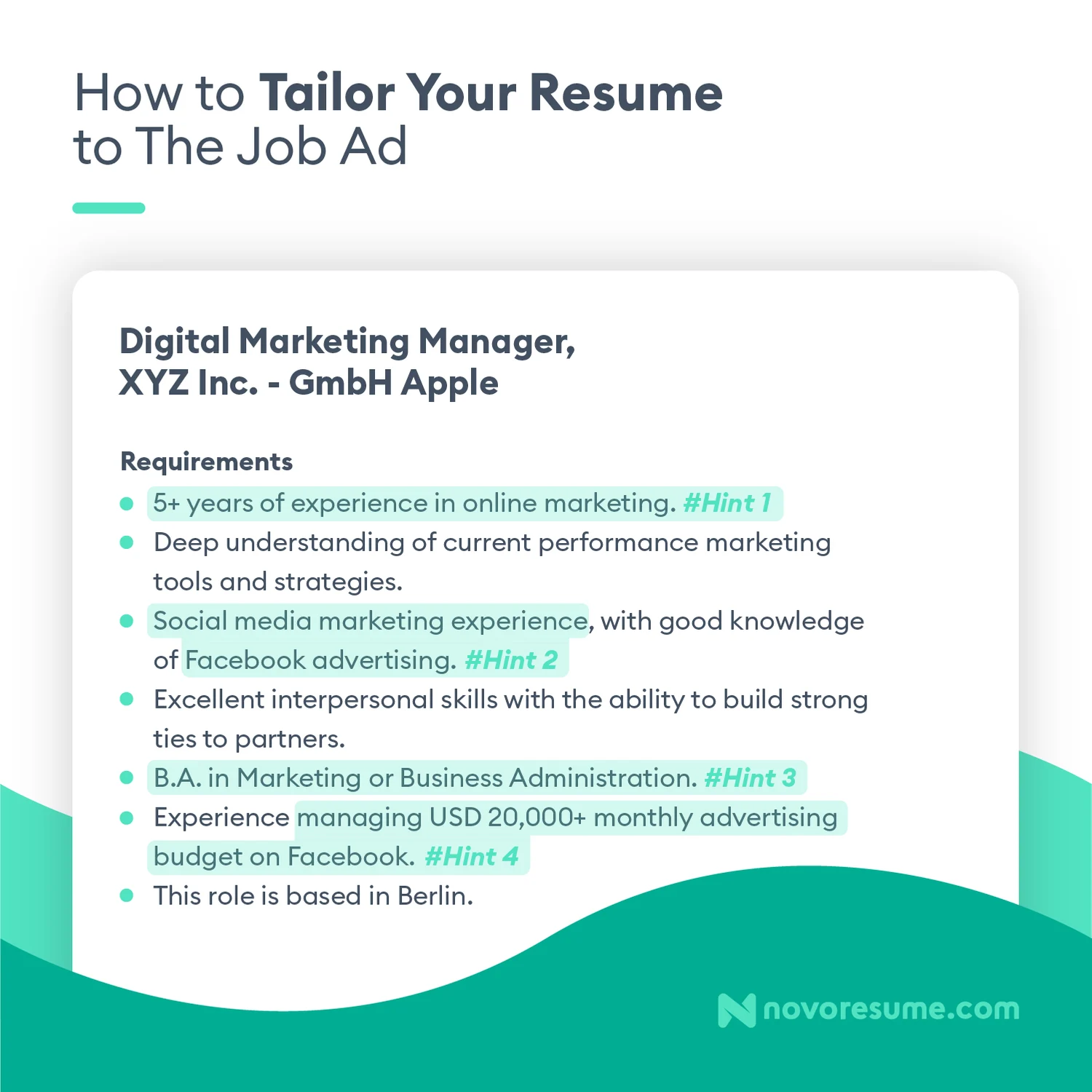
As you can see, we’ve highlighted the most important requirements.
To tailor your resume accordingly, you just need to mention how you meet each of these requirements in your resume.
You can highlight your relevant achievements and qualifications in different parts of your resume, such as:
- In your resume summary, where you should recap your years of experience.
- Throughout your work experience section, where you should list achievements and responsibilities that reflect your social media marketing experience.
- In your education section, where you can let the hiring manager know you have the degree that they’re looking for.
Include the Right Amount of Work Experience
If you’ve got over a decade’s worth of work experience, you’re probably wondering whether all of it belongs on your resume. In most cases, you’d end up writing a novel if you listed everything you’ve ever done, and that’s not how long a resume should be .
If you’re new to the job market, on the other hand, you probably don’t have any experience, and you’re wondering what you could even add to this section.
So, here’s how much information your resume should include, depending on your level of experience:
- No experience. If you’re looking for your first job , you won’t have any work experience to fill this section with. So, you can either keep it empty and focus on all the other sections or fill it up with any experience gained in student organizations, extracurricular activities, volunteering, and other projects.
- Entry-level. List all your work experience so far. While some of it won’t be relevant, it can still show the hiring manager that you do have some actual work experience.
- Mid-level. Only mention relevant work experience to the position you’re applying for. There’s no need to waste space on jobs that aren’t related to what you’re after.
- Senior-level. List up to 15 years of relevant work experience, tops. If your most recent experience is as a marketing executive , the hiring manager doesn’t care how you started your career as a junior marketing specialist 23 years ago.
Consider Applicant Tracking System (ATS) Software
Did you know that over 70% of resumes don’t even make it to the hiring manager ?
Most companies these days use ATS to evaluate hundreds of resumes instantaneously and automatically filter out the ones that don’t meet their criteria.
For example, if a resume doesn’t mention a specific skill or isn’t formatted correctly, the ATS will automatically reject it.
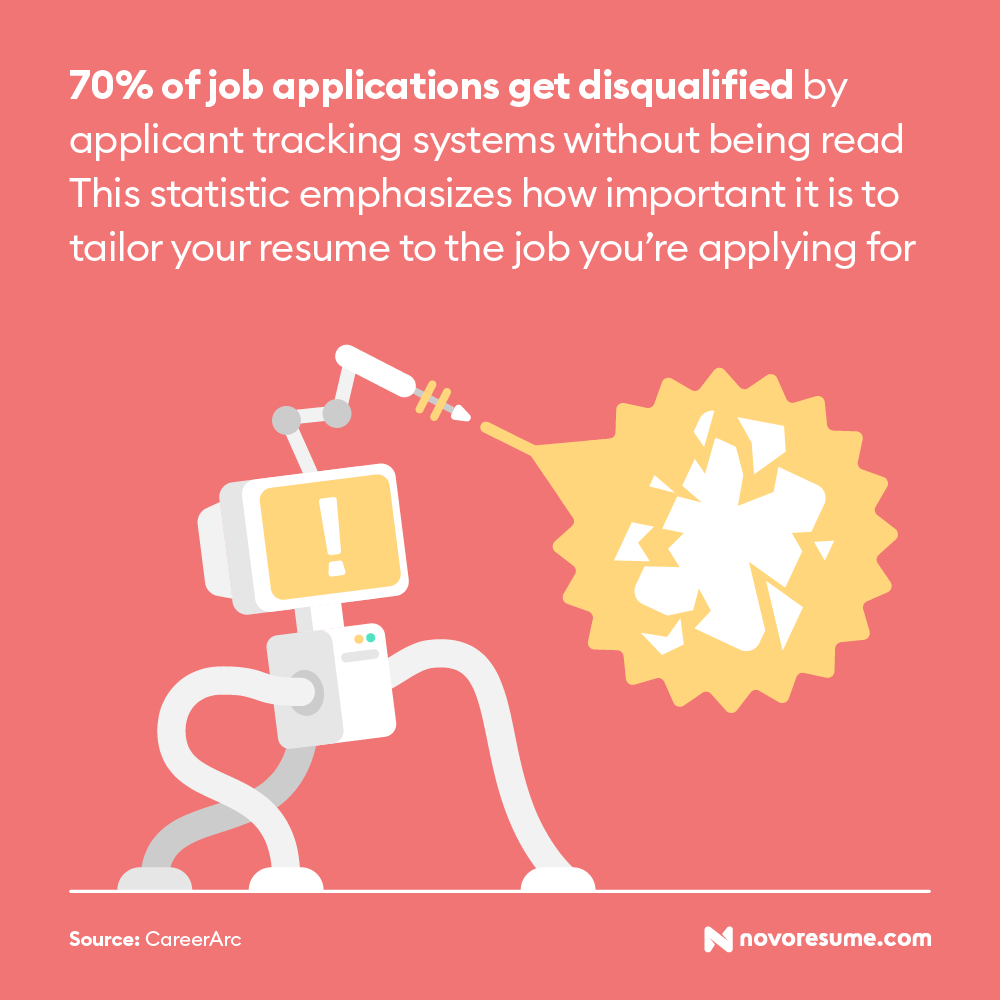
Fortunately, there are some easy ways to make an ATS-friendly resume .
Here are a couple of tips to help you get past those pesky robots:
- Stick to one page. Sometimes employers set a limit on how long a resume should be. This means that if your resume is longer than one page, it might get automatically disqualified.
- Incorporate keywords. Tailoring your resume to the job helps a ton with beating the ATS. Just carefully read the job description to find hints for what the ATS will be looking for. Then, whenever you find keywords related to your responsibilities and achievements, make sure to include them in your work experience section.
- Use an active voice. Passive voice is too vague and unclear, so make sure to use active voice as much as possible when describing your previous jobs. (E.g.: “Managed a team of ten people,” instead of “ A team of ten people was managed by me.” )
- Leverage powerful action words. Instead of starting each of your sentences with “was responsible for," make your work experience impactful by using words that can grab attention. Saying that you “spearheaded” or “facilitated” something sounds a lot more impressive than “helped.”
Want to make sure your resume formatting passes the ATS test? Choose one of our tried and tested ATS-friendly resume templates , and you’ll be good to go!
#5. List Your Education
The next section on your resume is dedicated to your academic qualifications. Let’s start with the basics!
Here’s how you should format the education section on your resume :
- Program Name. Your major and degree type should be listed. (E.g.: “B.A. in Business Administration” )
- University Name. Add the name of the institution. (E.g.: “New York State University” )
- Dates Attended. Use a mm/yyyy format for the dates you attended. (E.g.: “08/2008 - 06/2012” )
- Location. If your university is less well-known, you can also add the location. (E.g.: “Stockholm, Sweden” )
- GPA. Use the appropriate grading system for the country you’re applying to work in. (E.g.: In the USA, it would be “3.9 GPA” )
- Honors. Add any honors and distinctions you’ve been given. (E.g.: Cum Laude, Magna Cum Laude, Summa Cum Laude )
- Achievements. You can mention interesting papers you’ve written, projects you’ve done, or relevant coursework you’ve excelled in.
- Minor. “Minor in Psychology”
Pretty simple, right? Now let’s see what an education section looks like in practice:
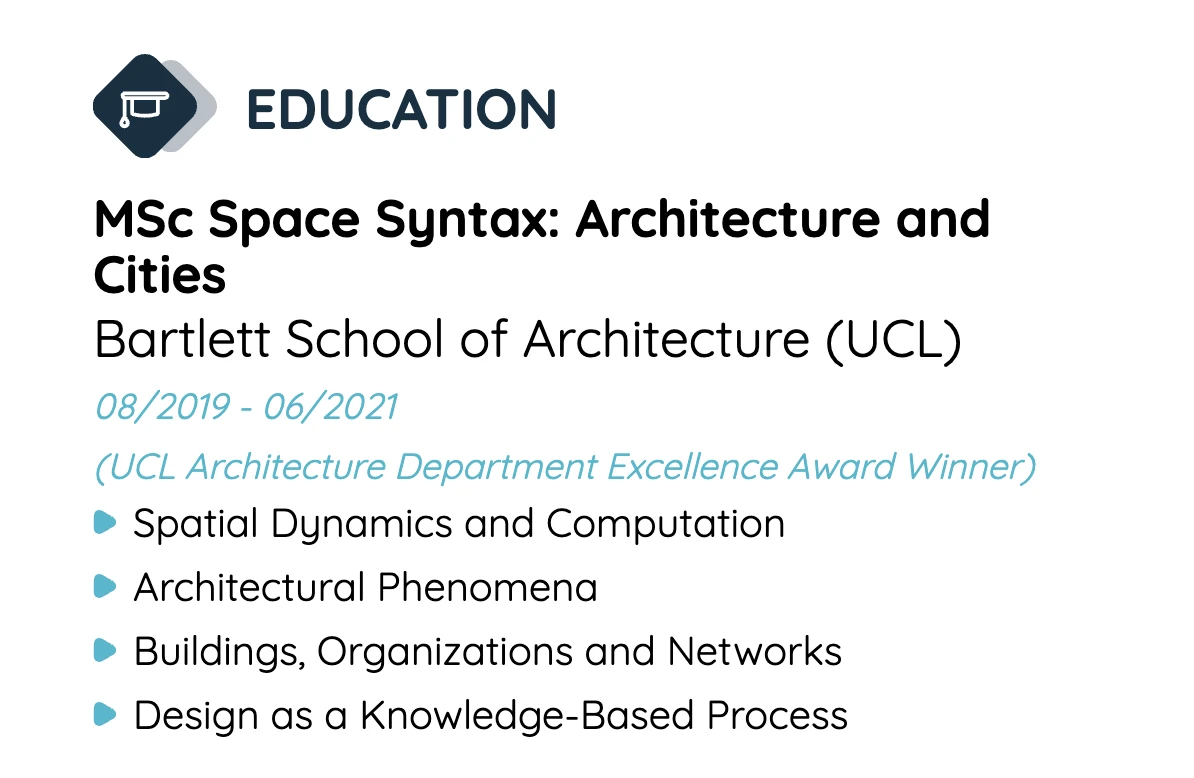
This example includes all the necessary information, plus an eye-catching award and relevant classes this candidate has taken.
Resume Education Tips
Now that you know how to list your education on your resume, let’s take this section to the next level.
Just follow these expert tips:
- If you’re making a resume as a student and don’t have any work experience yet, you can list your education section at the beginning of the page instead of work experience.
- You can add your expected graduation date if you’re still pursuing your degree.
- If you already have relevant work experience, just keep this section short and sweet. Recent graduates can expand on their education more and add optional information like projects, classes, academic achievements, etc.
- Always list your degrees in reverse chronological order, starting with your highest degree on top. Your highest and most recent degree is usually enough, so if you have a Master’s degree that’s relevant to the job, there’s no need to mention your earlier degrees.
- Don’t add your high school degree to your resume if you already have a university degree. It doesn’t have as much weight, and you can use the space for something else.
- Only mention your GPA if you had an impressive academic career. Anything below a 3.5 GPA doesn’t need to be on your resume.
Are you in the process of applying for college? Check out our guide to writing a college application resume to wow that admissions officer!
#6. Emphasize Your Know-How in the Skills Section
After your work experience, your skills are the first thing the hiring manager is going to look for. In fact, together, work experience and skills make up 90% of the hiring decision .
So, this is the place where you want to mention all the know-how that makes you the perfect candidate for the job.
There are two types of skills you can include when writing your resume:
- Hard Skills. These are measurable abilities. What you can list here can be anything from coding in Python to knowing how to cook Thai cuisine.
- Soft Skills. Also known as personal skills, these are a mix of communication skills , personal traits, career attributes, and more. They can include leadership, critical thinking, and time management , just to name a few.
Your resume should always cover both hard skills and soft skills . Here’s an example in action:
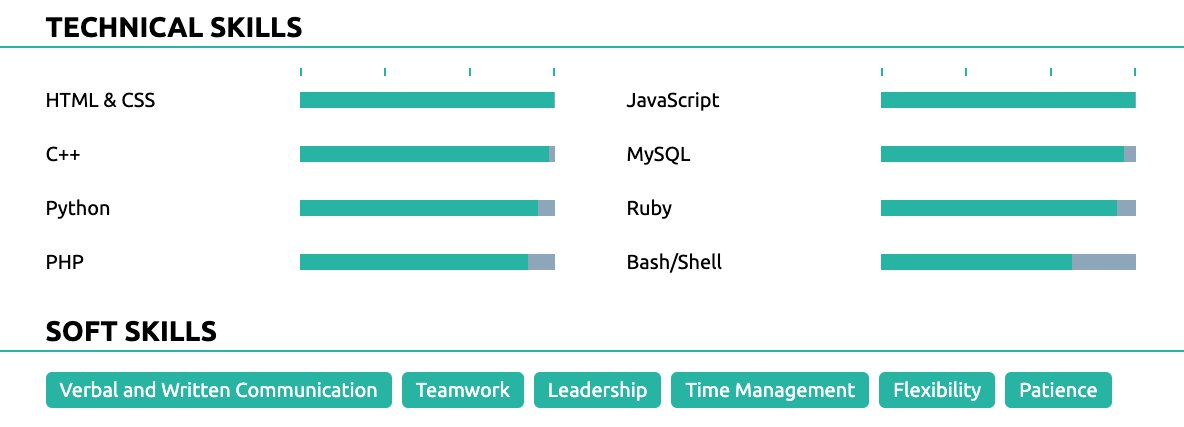
Now, let’s discuss how you should list your most important skills on your resume.
There are a few essential steps you need to follow:
Always List Hard and Soft Skills Separately
Your resume should be easy and neat to navigate. The hiring manager shouldn’t have to waste time looking for a specific skill because you didn’t separate it into the appropriate subsection.
So, just create separate categories for your hard and soft skills.
Depending on your field, you could customize the name of your “hard skills” subsection to something like “technical skills," “marketing skills," or something else related to your field.
Let’s look at an example of what skills look like on a project manager’s resume :
Methodologies & Tools
- Agile Methodology
- SCRUM Framework
- Waterfall Project Management
- Microsoft Project
- Critical Path Method (CPM)
- Earned Value Management (EVM)
- Risk Management
Soft Skills
- Team Management
- Conflict Resolution
- Negotiation
Tailor Your Skills to the Job
You might have some awesome skills, but the hiring manager only needs to know about the ones that are relevant to the job.
For example, if you’re applying for a job as an accountant, your gourmet chef skills shouldn’t be on your resume.
Look at the job ad and list at least two to three essential skills you have that are required for the role. Remember—there’s no need to list every skill you have here; just keep it relevant.
Qualifications:
- Bachelor’s degree or higher in Graphic Design or a related field.
- Tech-savvy, with some background in CMS systems such as WordPress.
- Thrives in a stressful environment and juggles multiple tasks and deadlines.
- Strong organizational and time management skills.
- Excellent communication skills.
- Self-reliant, with the ability to manage their own work.
- A can-do attitude and an outside-the-box thinker.
- Proficient in Adobe Photoshop, InDesign, Illustrator, Keynote, and Pages.
- Basic understanding of Office software such as Microsoft Word, Excel, PowerPoint, and Outlook.
So, the must-have hard skills here are Photoshop, InDesign, Illustrator, Keynote, and Pages. Other good computer skills to have are WordPress or similar CMS systems.
While you can also mention Word, Excel, PowerPoint, and Outlook, it’s pretty much assumed that you know how to use them since they’re required for most office jobs.
List Hard Skills with Experience Levels
For each hard skill you list on your resume, you should also mention your proficiency level. This tells employers what they can expect from you and how much training you might need.
- Beginner. You have some experience with the skill, whether it’s from some entry-level practice or classroom education.
- Intermediate. You’ve used the skill in a work environment with good understanding.
- Advanced. You’re the go-to person for this skill in your office. You can coach other employees, and you understand the skill at a high level.
- Expert. You’ve applied this skill to more than a handful of different projects and organizations. You’re the go-to person for advice about the skill, not just in your office but even amongst some of the best professionals in your field.
Just make sure to never lie about your actual skill level. Even if you get the job, once you need those skills you exaggerated, it will be pretty awkward for both you and your employer.
Include Transferable Skills
These are the types of skills that are useful for almost any job out there.
Transferable skills can be both soft skills (e.g.: teamwork, creativity, problem-solving skills, and others) and hard skills (MS Office Suite, HTML, writing, etc.)
Whatever job you’re applying to, chances are you have transferable skills from your experience that can come in handy one way or another. So, feel free to include them, even if they’re not specifically required for the position.
Not sure which skills to mention on your resume for your specific field? Check out our list of 101+ essential skills for inspiration!
#7. Leverage Optional Resume Sections
The sections we’ve covered so far are must-haves for any resume. They’re the bread-and-butter for any job application, and if you get them right, you’ll land any job you apply to.
But if you have some leftover space, there are a few optional sections you can choose from to give your resume a boost!
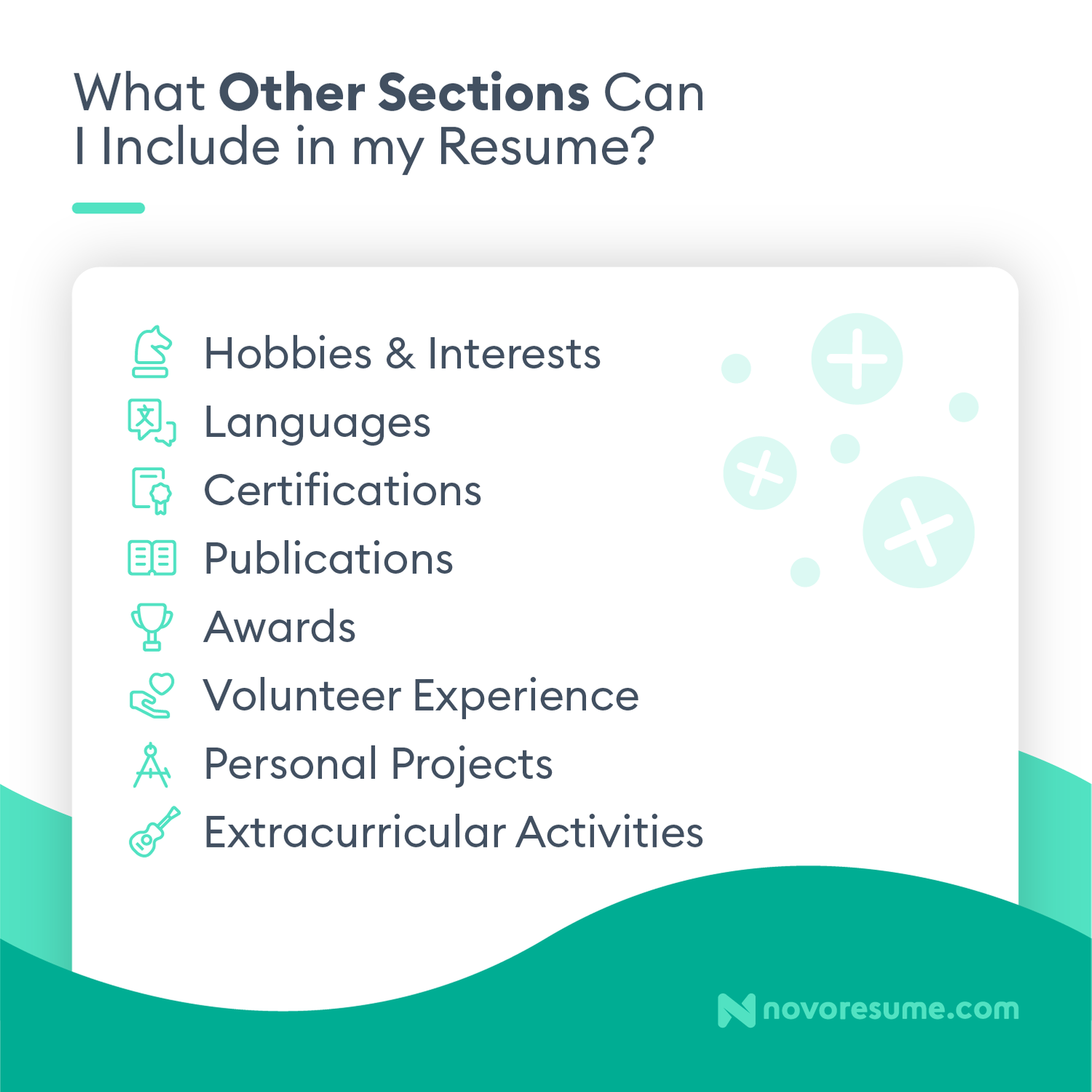
Are you bi-lingual? Or even better – multi-lingual? You should always mention that on your resume!
Even if the position doesn’t require you to know a specific language, it can still come in handy at some point. At the end of the day, it’s always better to know more languages than less.
To list languages in your resume , just write them down and assign them the appropriate level:
- Intermediate
You can also use the Common European Framework of Reference for Languages (CEFRL) or the American Council on the Teaching of Foreign Languages (ACTFL) proficiency scales.
As a given, you should never lie about your language skills. You never know—your interviewer might turn out to be fluent in the language or even be a native speaker!
Hobbies and Interests
If you want to spice up your resume, hobbies and interests could be just what you need.
While this section isn’t a game-changer, it can help the hiring manager see who you are as an individual.
For example, if you listed “teamwork” as one of your skills, hobbies like team sports can back up your claim.
And who knows? Maybe you and your interviewer have some hobbies or interests in common!
Volunteering Experience
If you’re the type of person who devotes their free time to helping others while expecting nothing in return, chances are that you’re the type of employee who’s in it for more than just the money.
Seeing volunteer experience on your resume tells hiring managers that you’re a loyal employee who’s after something meaningful.
Several studies show that listing your volunteer experience can boost your chances of getting hired, especially if you have little to no work experience.
Certifications
Hiring managers love candidates who invest in themselves, and that’s exactly what they see when you list certifications on your resume .
If you value continuous learning and strive to expand your skill set, that’s always a plus.
Certifications can also show employers how much expertise you have.
For example, if you’re a Microsoft Cloud Engineer and you specialize in Microsoft Technologies, you should definitely include all essential certifications on your resume, such as the Azure Solutions Architect Expert one.
Awards and Recognitions
There’s no harm in showing off a little on your resume. After all, you want to be a candidate that shines above the rest.
So, if you’ve received any awards or recognitions that make you stand out in your field, make sure to add them.
For example, if you’ve been recognized for your contributions to data science or received a hard-to-come-by scholarship , mention it in your resume. Just keep your entries here relevant to the field you’re applying to.
Publications
Whether you’re a freelance writer or a distinguished academic, publications are always impressive.
If you have any published works (online or in an academic journal), you can add them to your resume. Just make sure to include a link so the hiring manager knows where to check your work!
Are you looking for a career in academia? Check out our guide to writing the perfect academic CV to get started!
Working on side projects can show off your passion for your field. Whether they’re university class projects or part-time entrepreneurial endeavors, they’re relevant.
For example, if you worked on a mock software product as part of a university competition, it shows you went through every step of product creation, from ideation to creating a marketing strategy.
This project also shows off your organizational skills , and if you mention it in your resume, you stand a better chance of landing the job you had your sights set on.
But projects can also be personal, not academic. For example, you might manage an Etsy store where you sell hand-made arts and crafts to customers online. This is a great opportunity to highlight your creativity, management, and customer service skills .
Overall, hiring managers love employees who do cool work in their free time, so projects are always a great section to add to your resume.
Looking to kickstart your career? Check out our guide on how to get an internship for useful tips and real-life examples!
Extracurricular Activities
Every college freshman knows that extracurricular experience can make a difference in their application.
Especially if you don’t have a lot of experience outside of school, extracurricular activities are a great way to show potential employers your skills and give them insight into you as a person. Different clubs and after-school projects can help you gain real-life skills and considerably increase your chances of landing your first job after college.
For example, joining a student government organization can hone your leadership skills and teach you how to work as part of a team.
For example, if you’re part of a student government or public speaking club, these activities can help you hone your leadership and presentation skills.
11+ Expert Resume Tips
You’ve got the gist of how to make a resume. Now, it’s time to make it really stand out from the crowd!
Follow these exclusive resume tips to take your resume game to the next level:
- Match the professional title underneath your name to the job title of the position you’re applying for. Hiring managers often hire for several roles at once, so giving them this cue about what role you’re after helps things go smoother.
- Mention any promotions from your previous jobs. Use the work experience entries for them to focus on the achievements that helped you earn them.
- Describe your achievements using Laszlo Bock’s formula : accomplished X as measured by Y by doing Z . This way, your work experience can go the extra mile and show the hiring manager what you can bring to the table.
- Always list your achievements and responsibilities in concise bullet points. This makes your resume more reader-friendly, and it’s more likely that the hiring manager will see your impressive achievements at a glance.
- Don’t use personal pronouns like “I” or “me,” and don’t refer to yourself by name. Stick to a slightly altered third person, like “managed data integrity at XYZ Inc.” instead of “he managed data integrity at XYZ Inc.”
- Name your resume sections correctly, or it might get rejected by the ATS. Swapping out quirky names like “career history” or “expertise” for “work experience” and "skills" makes it easier for the hiring manager to find what they’re looking for, too.
- Prioritize important keywords instead of adding all of them. Make sure the relevant skills, qualifications, and experiences you add all make sense in context, too. Your goal is to get past the ATS and impress the hiring manager.
- Focus on transferable skills if you don’t have a lot of relevant work experience. Any extracurricular activities or personal projects can help you stand out here.
- Add a strategic pop of color to headings, bullet points, or key elements you want to highlight. It can help your resume stand out, but don’t overdo it—you want the information to be more impressive than the color palette.
- Don’t include the line “references available upon request.” Hiring managers already know they can request a list of references from you, so there’s no need to waste valuable space on it.
- Make sure your resume is optimized for mobile viewing. Most hiring managers use their mobile phones as often as desktop computers, so save your resume to a PDF file and make sure your formatting stays intact across any device.
- Rename the resume file you plan to send so it includes your name and the name of the position you’re applying for. It’s a small detail that can turn into a crucial mistake if you forget it.
- Read your resume out loud when you’re done. This is a great way to catch awkward phrases or spelling mistakes you might have missed otherwise.
- Use a tool like DocSend to track your resume. You’ll get a notification any time someone opens your resume, and you can see how long they spend reading it.
FREE Resume Checklist
Are you already done with your resume? Let’s see how it holds up!
Go through our checklist for perfecting your resume and see where you stand!
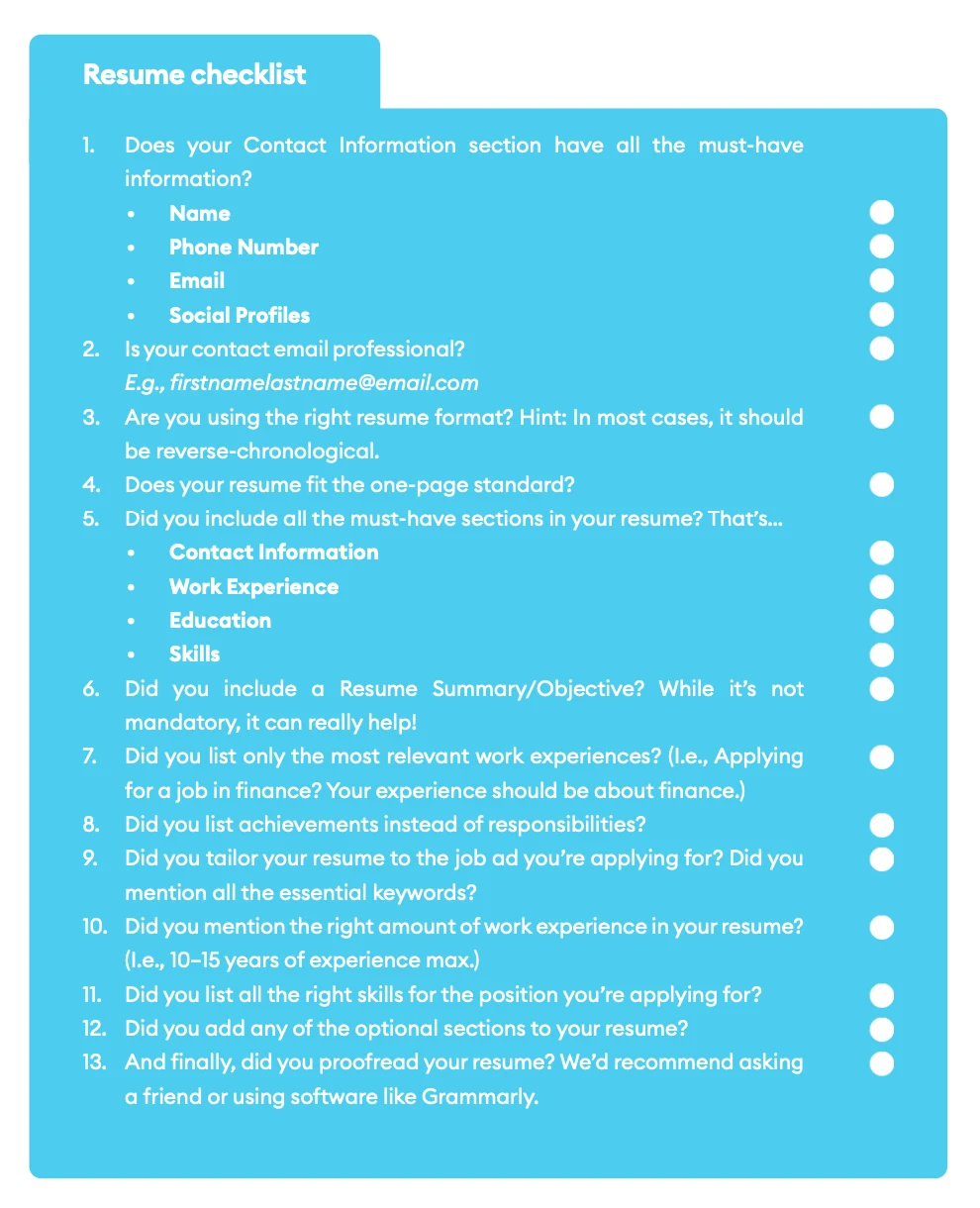
If you missed some points, just go through your resume one more time and perfect it.
And if you ☑’d everything—congrats! You’ve learned all there is to know about writing a resume, and you’re good to go with your job search.
Need to write a CV instead of a resume? Check out our step-by-step guide on how to write a CV with dozens of examples!
9 Resume Templates for Different Industries
Looking to create an effective resume without dealing with the formatting hassle? Just choose one of the templates below.
#1. Traditional Resume Template
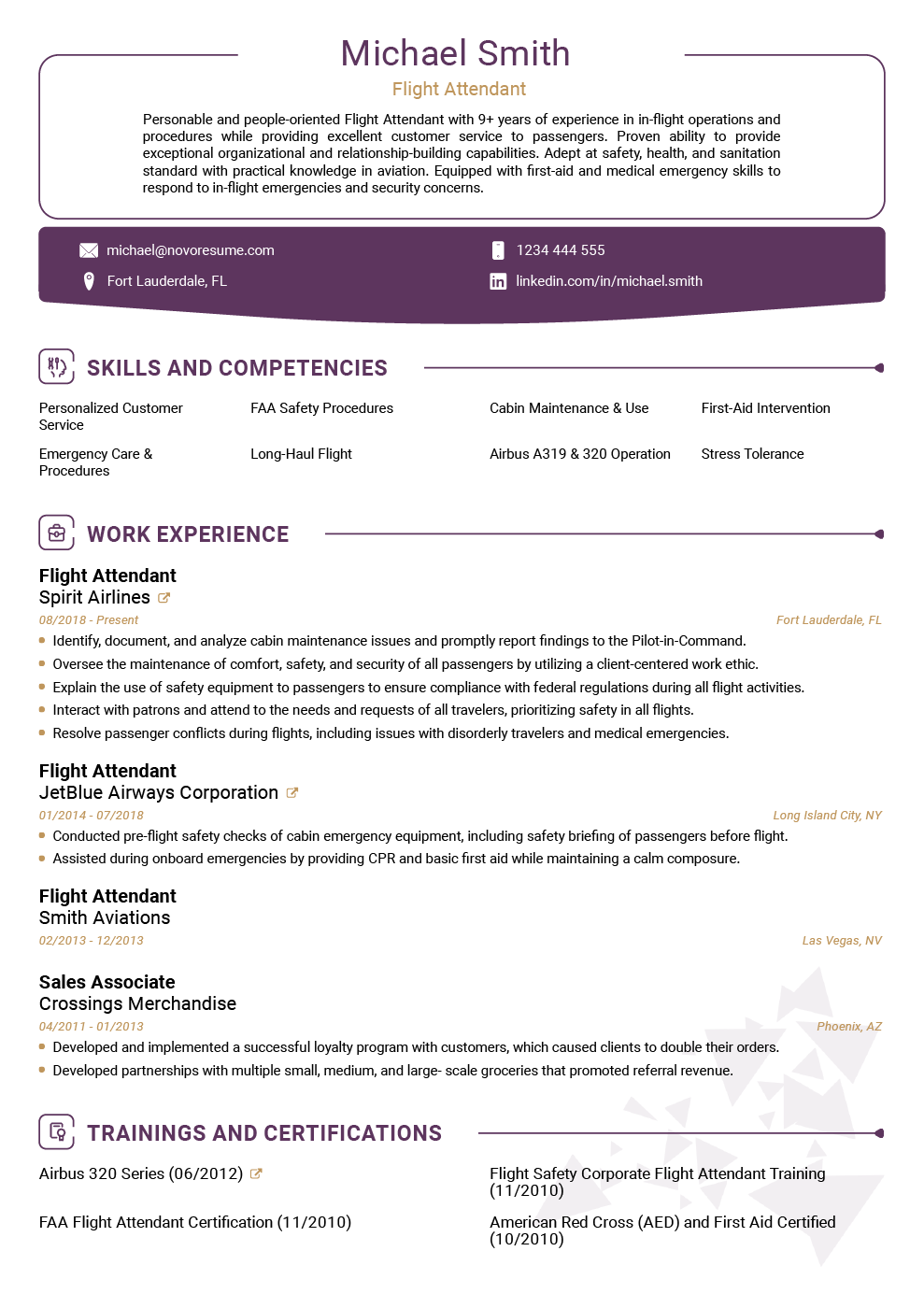
Good for traditional industries like finance, banking, law, and manufacturing.
#2. Modern Resume Template
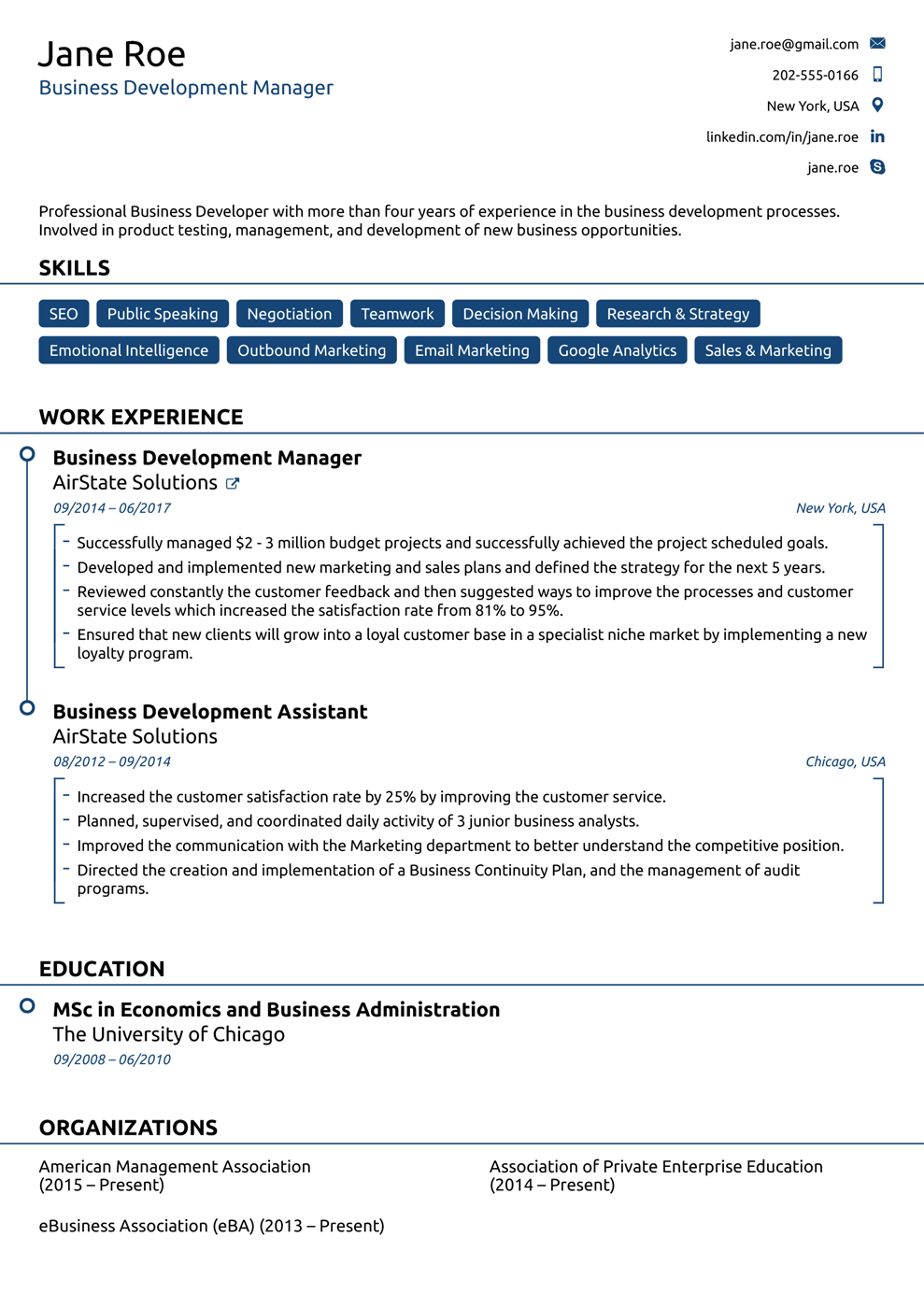
Good for both contemporary and forward-looking industries, including entrepreneurship, medical technology, and engineering.
#3. Creative Resume Template
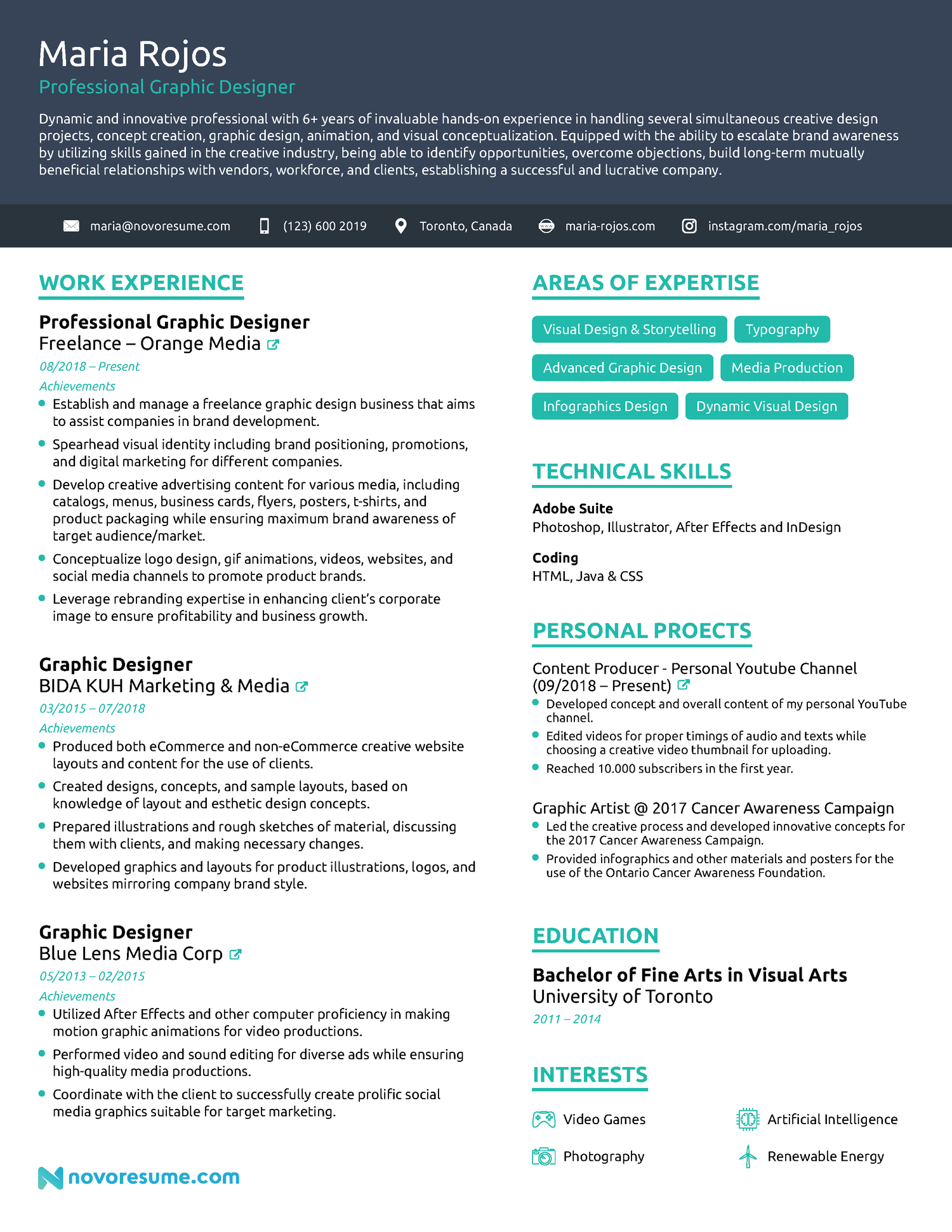
Good for creative industries, including entertainment, design, and architecture.
#4. Minimalistic Resume Template
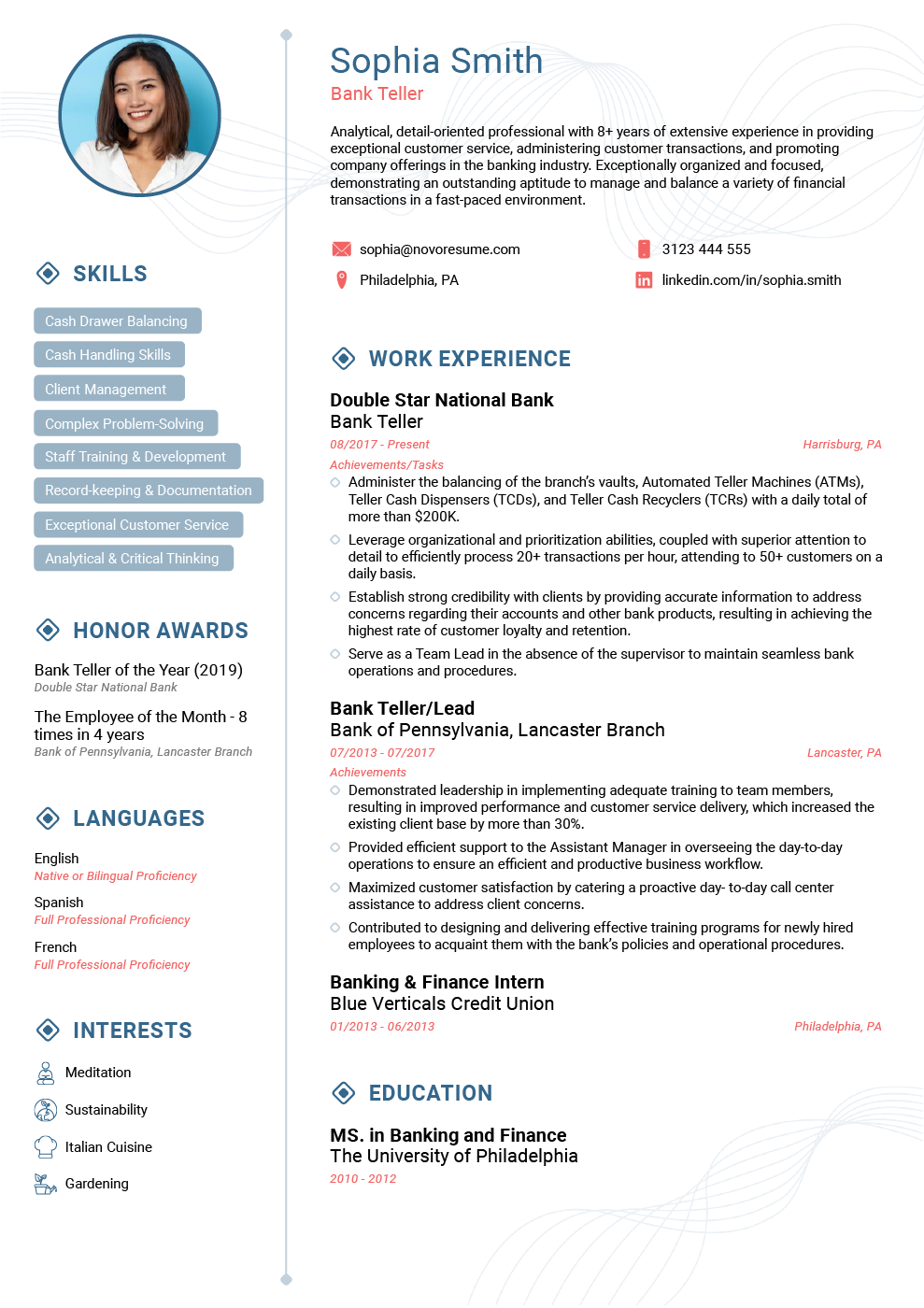
Good for experienced professionals in basically any industry who want to let their achievements do the talking.
#5. IT Resume Template
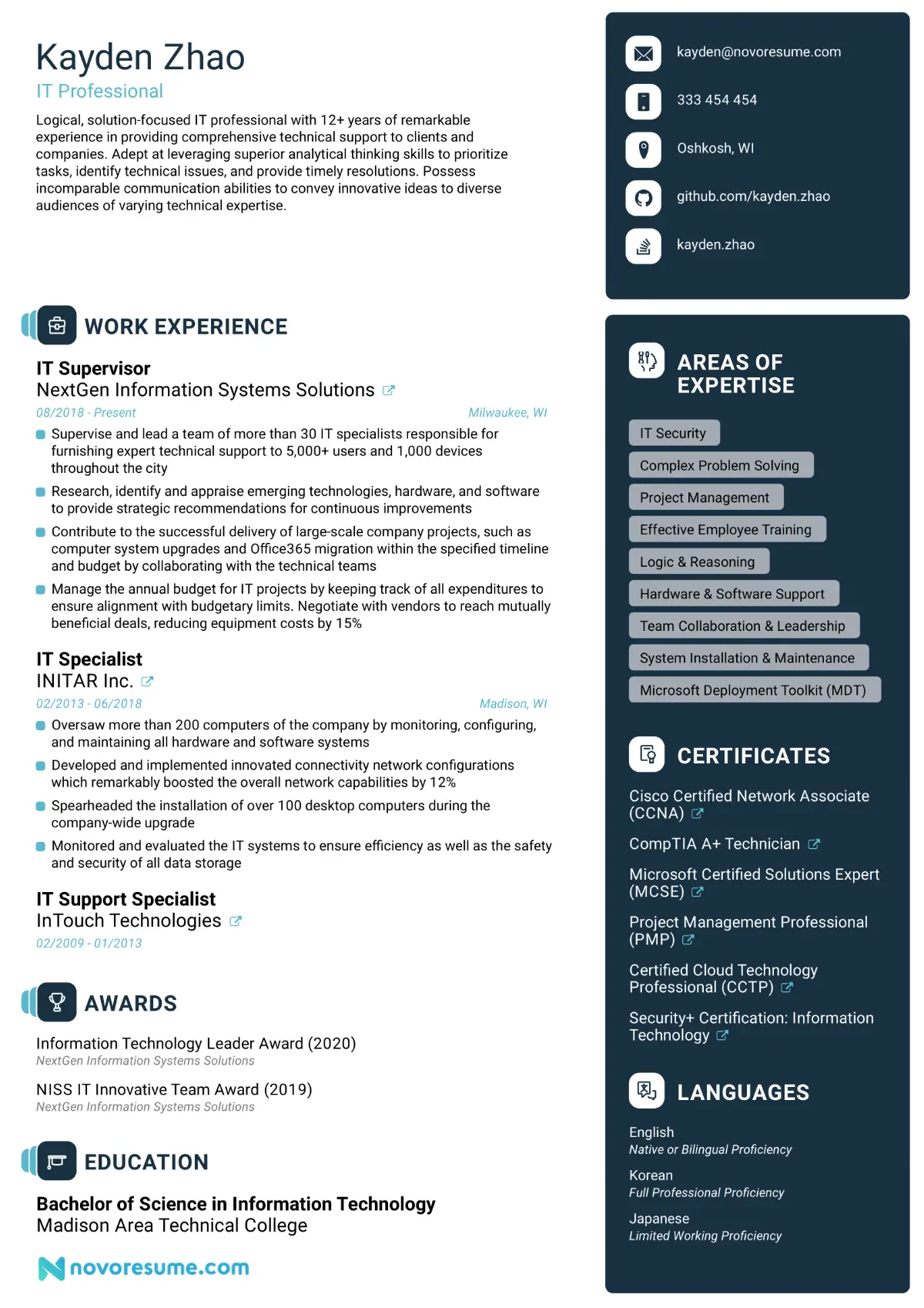
Good for any IT-related profession like software development, cyber security, and DevOps engineering.
#6. Tech Resume Template
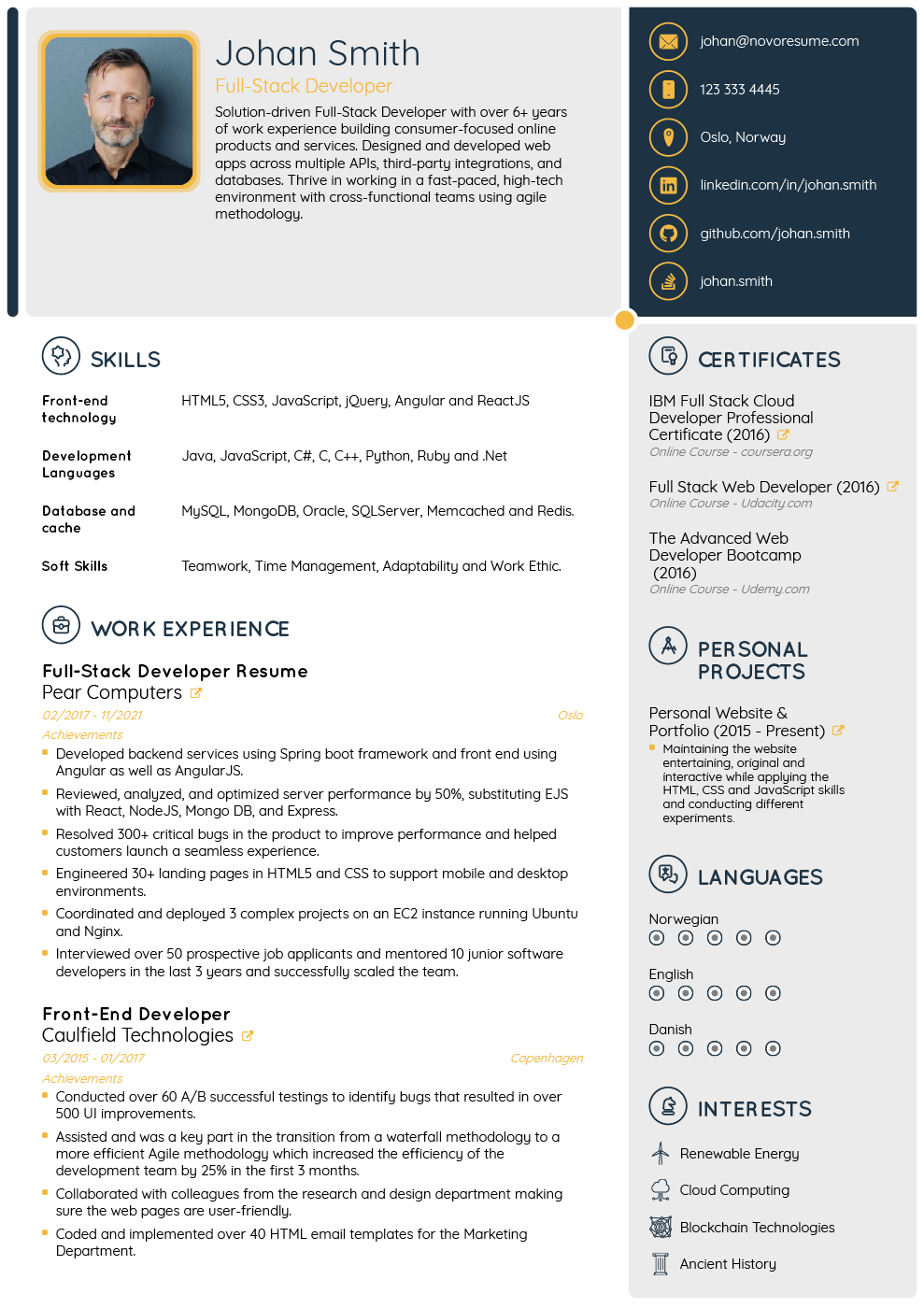
Good for the tech industry and everything it encompasses.
#7. College Resume Template
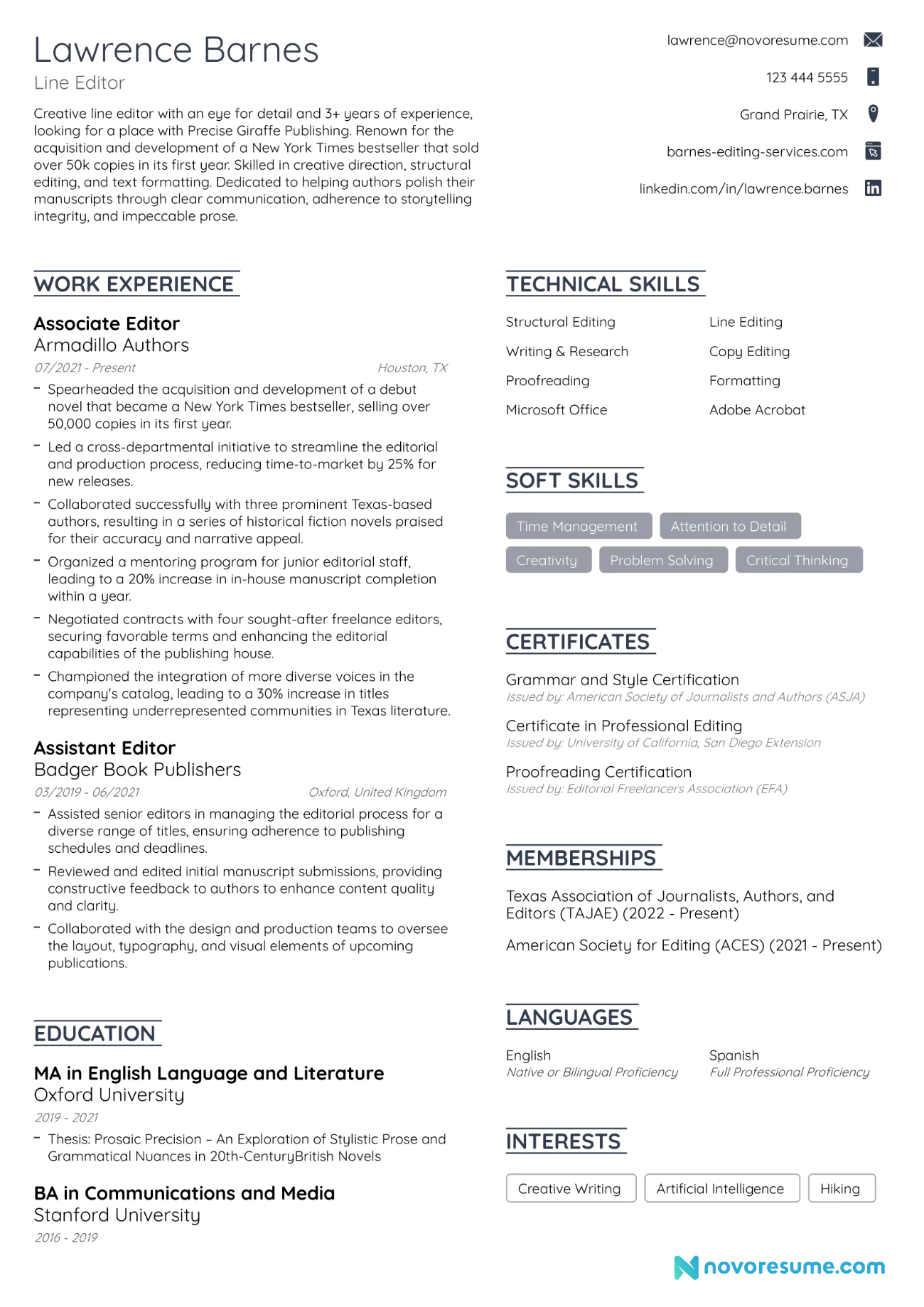
Good for college students and recent graduates alike.
#8. General Resume Template
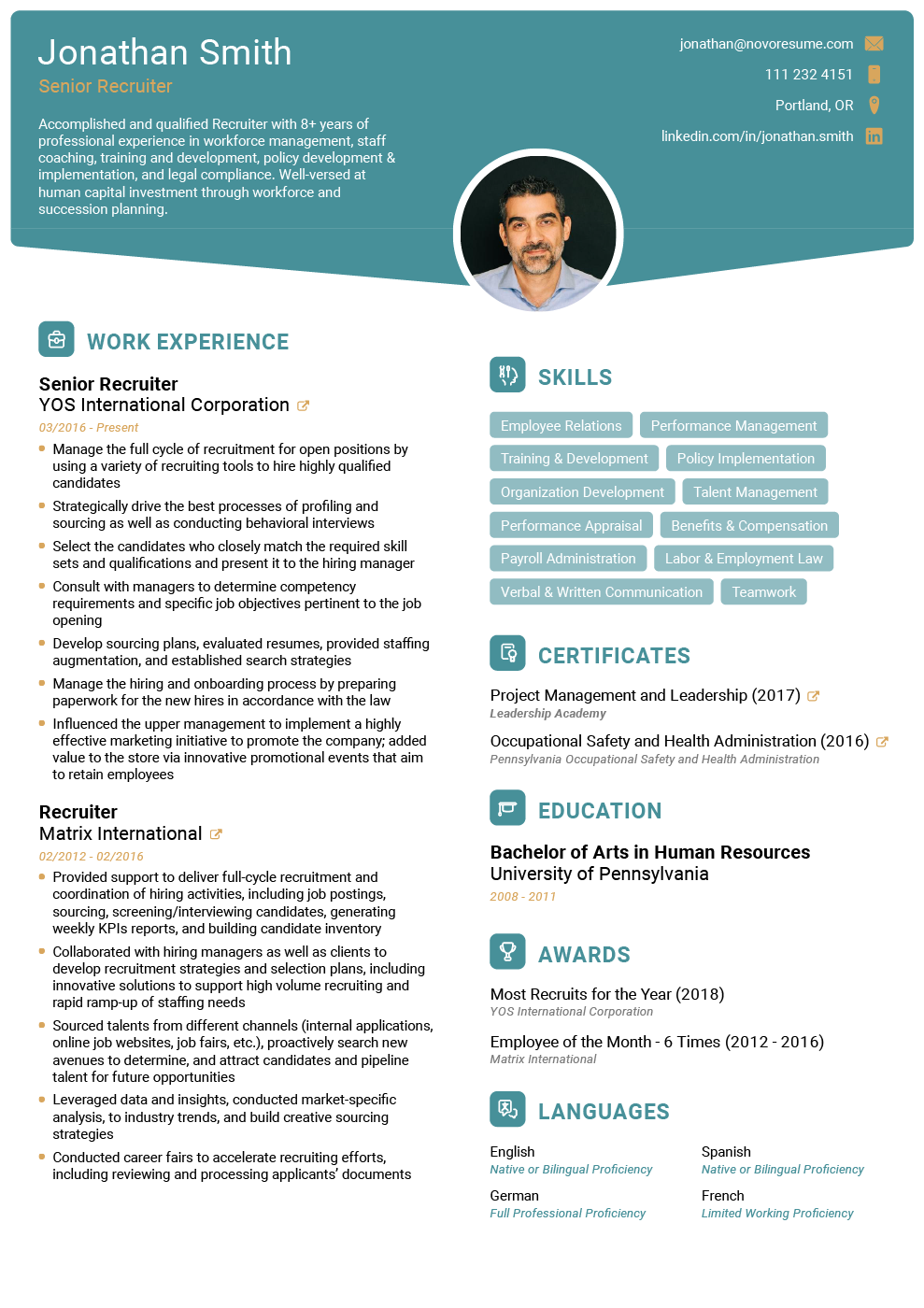
Good for multiple industries, including HR, education, and customer service.
#9. Executive Resume Template
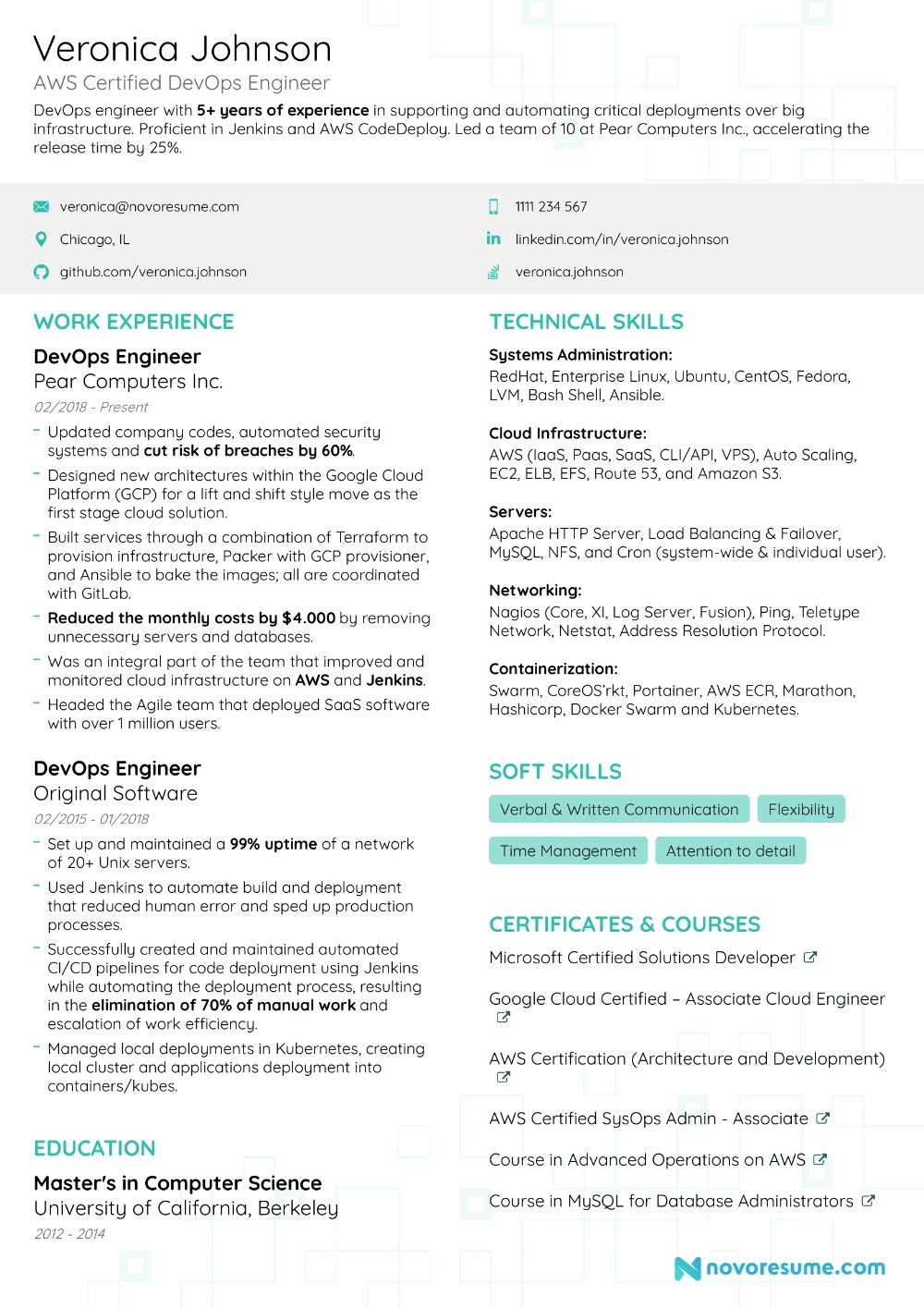
Good for senior professionals across different industries, including hospitality, marketing, and logistics.
17+ Resumes for Different Jobs
Knowing how to write a resume is one thing, but making a resume that stands out is something entirely different. Without inspiration, even top career experts might stumble on a roadblock or two.
Check out the following effective resume examples for specific jobs to get a better sense of what a good resume looks like:
#1. Nurse Practitioner Resume Example
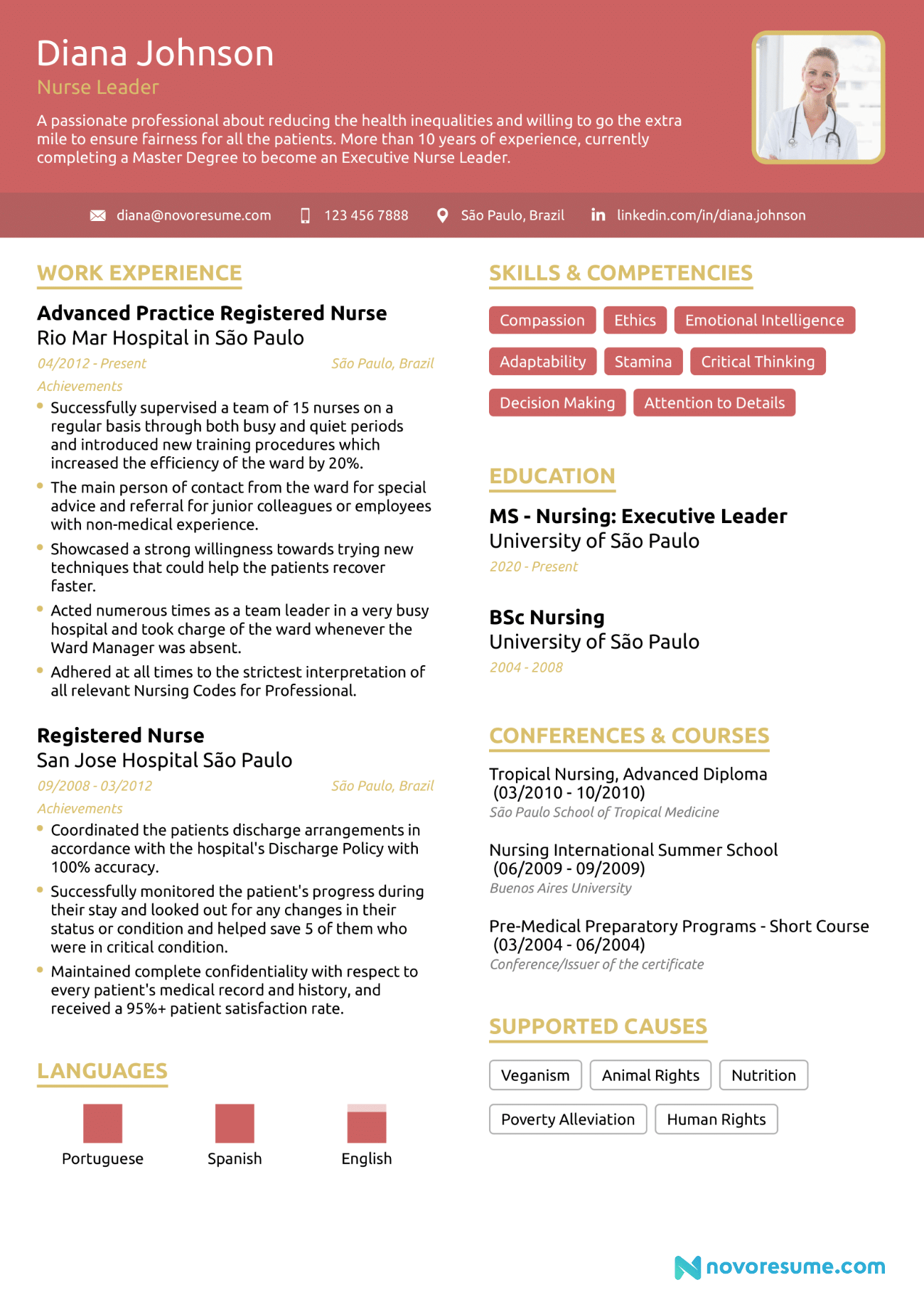
Check out our full guide to writing a nurse resume here.
#2. Data Scientist Resume Example
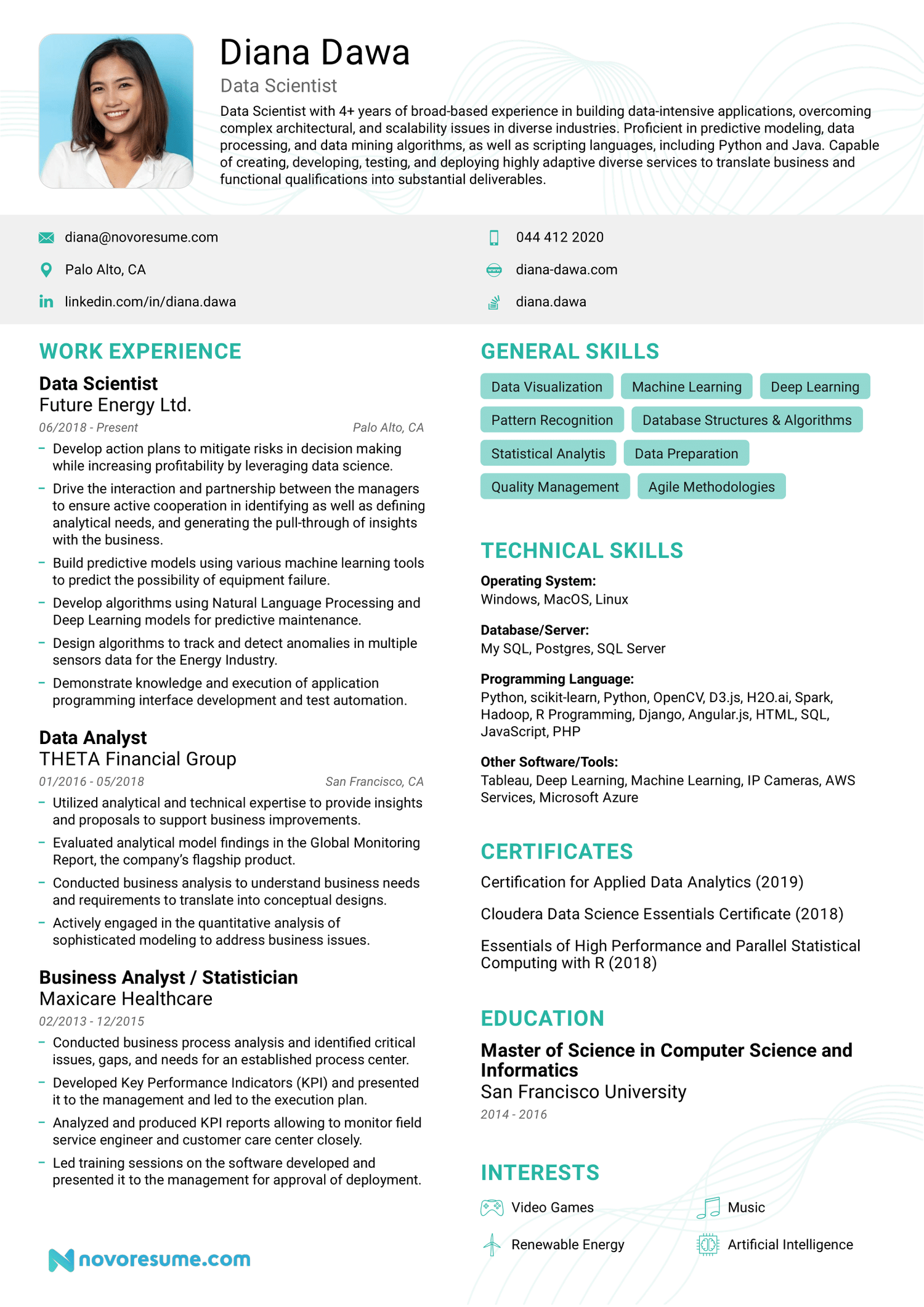
Check out our full guide to writing a data scientist resume here.
#3. Business Analyst Resume Example
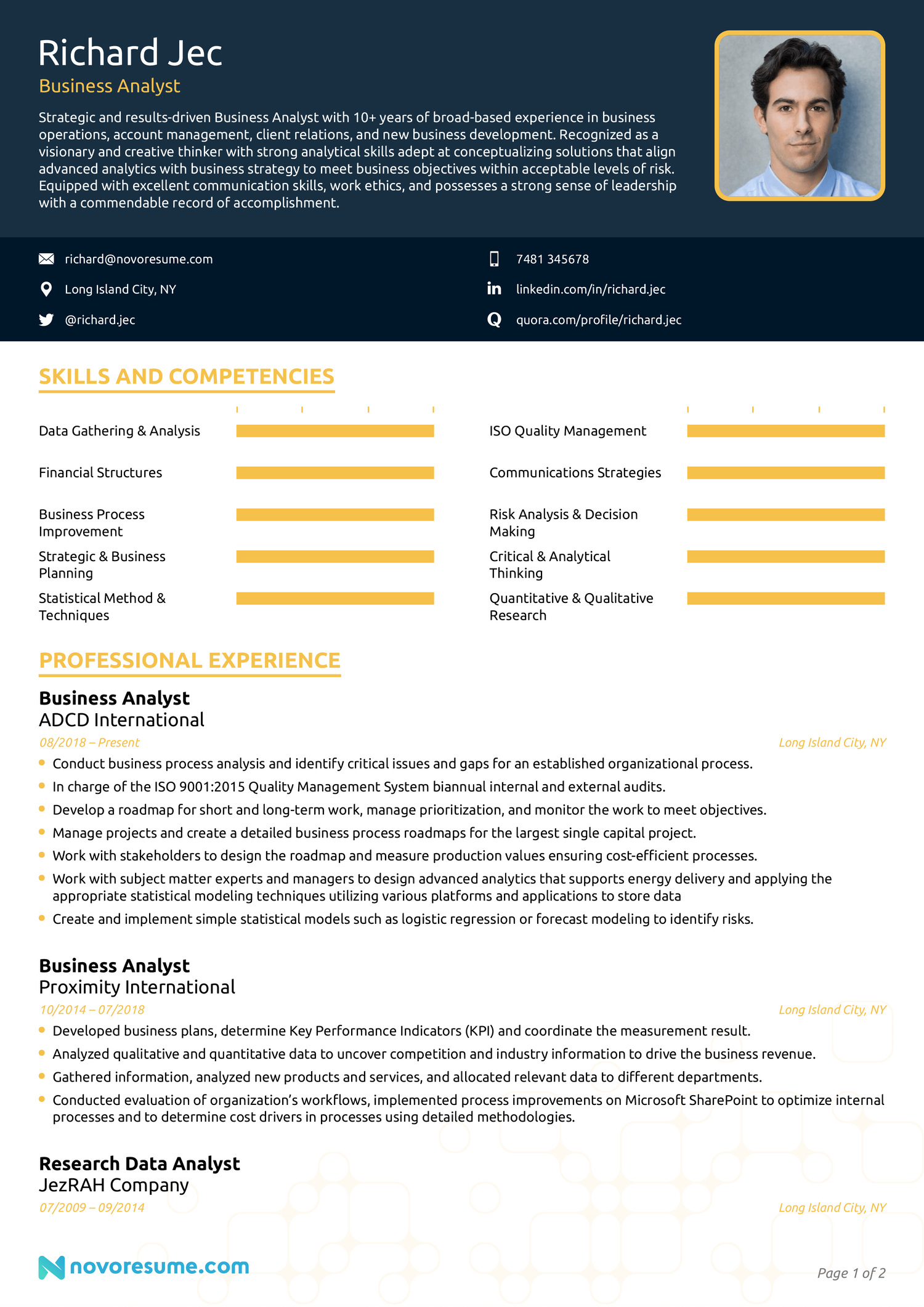
Check out our full guide to writing a business analyst resume here.
#4. Digital Marketing Resume Example
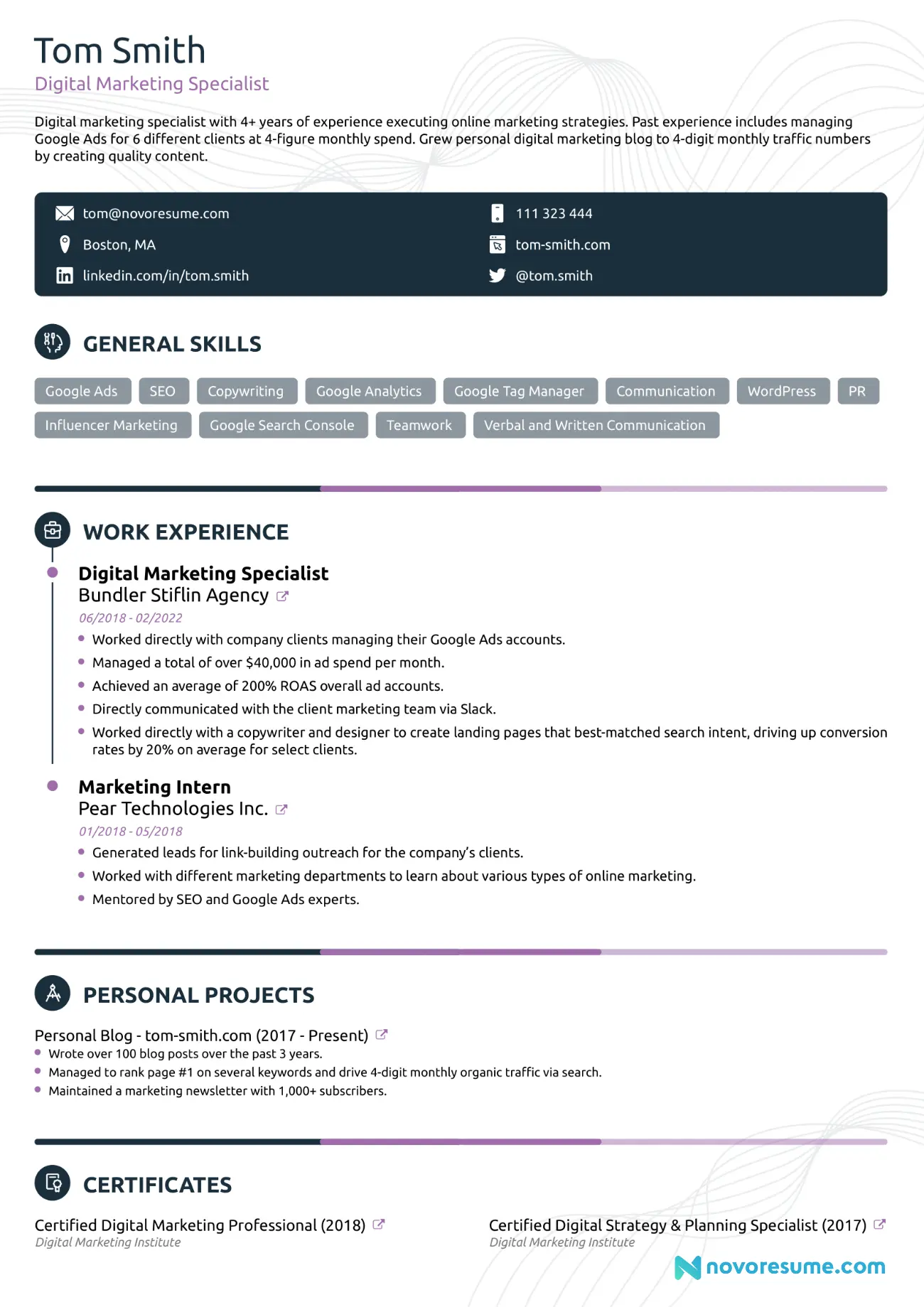
Check out our full guide to writing a digital marketing resume here.
#5. Software Engineer Resume Example
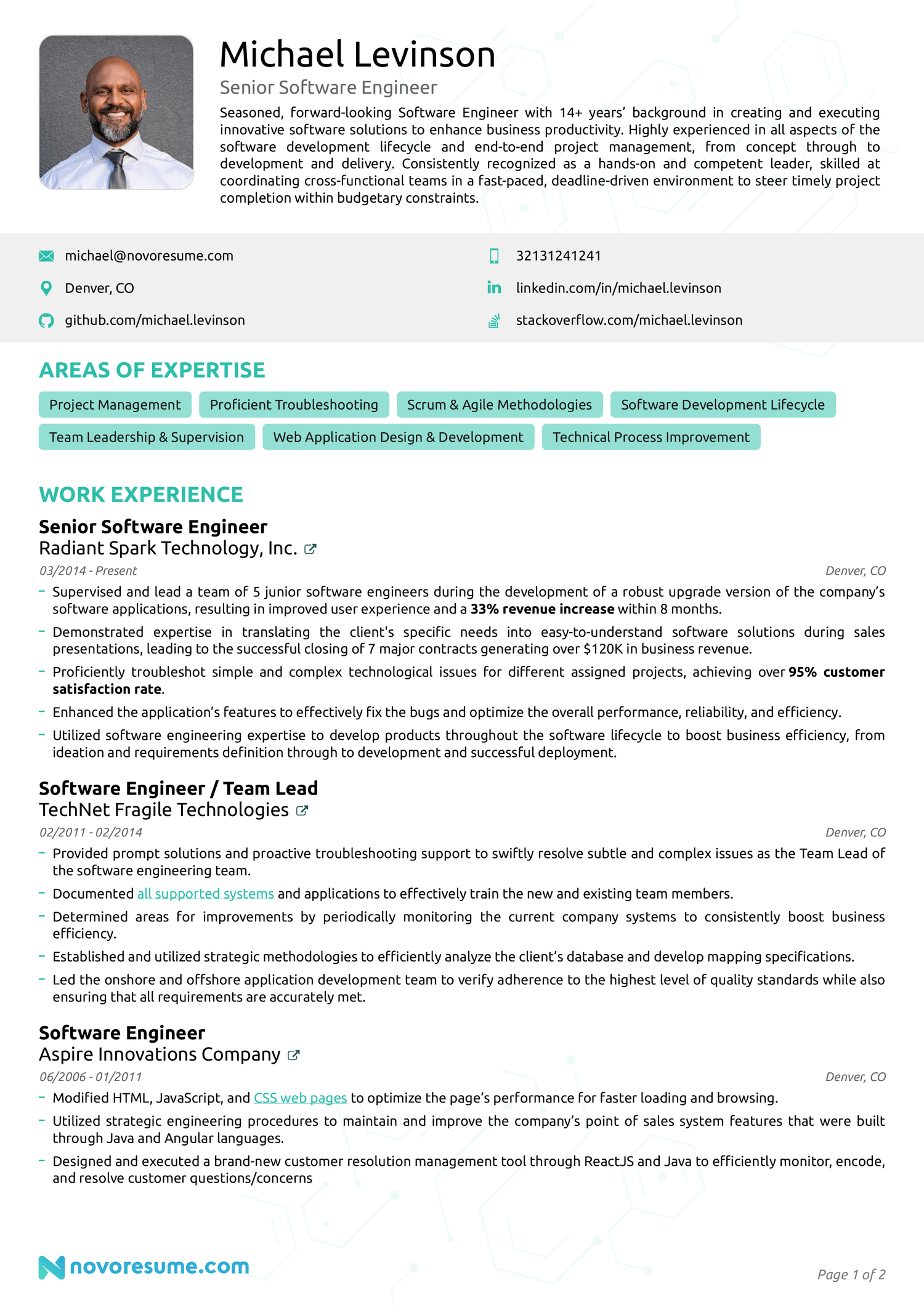
Check out our full guide to writing a software engineer resume here.
#6. Construction Project Manager Resume Example
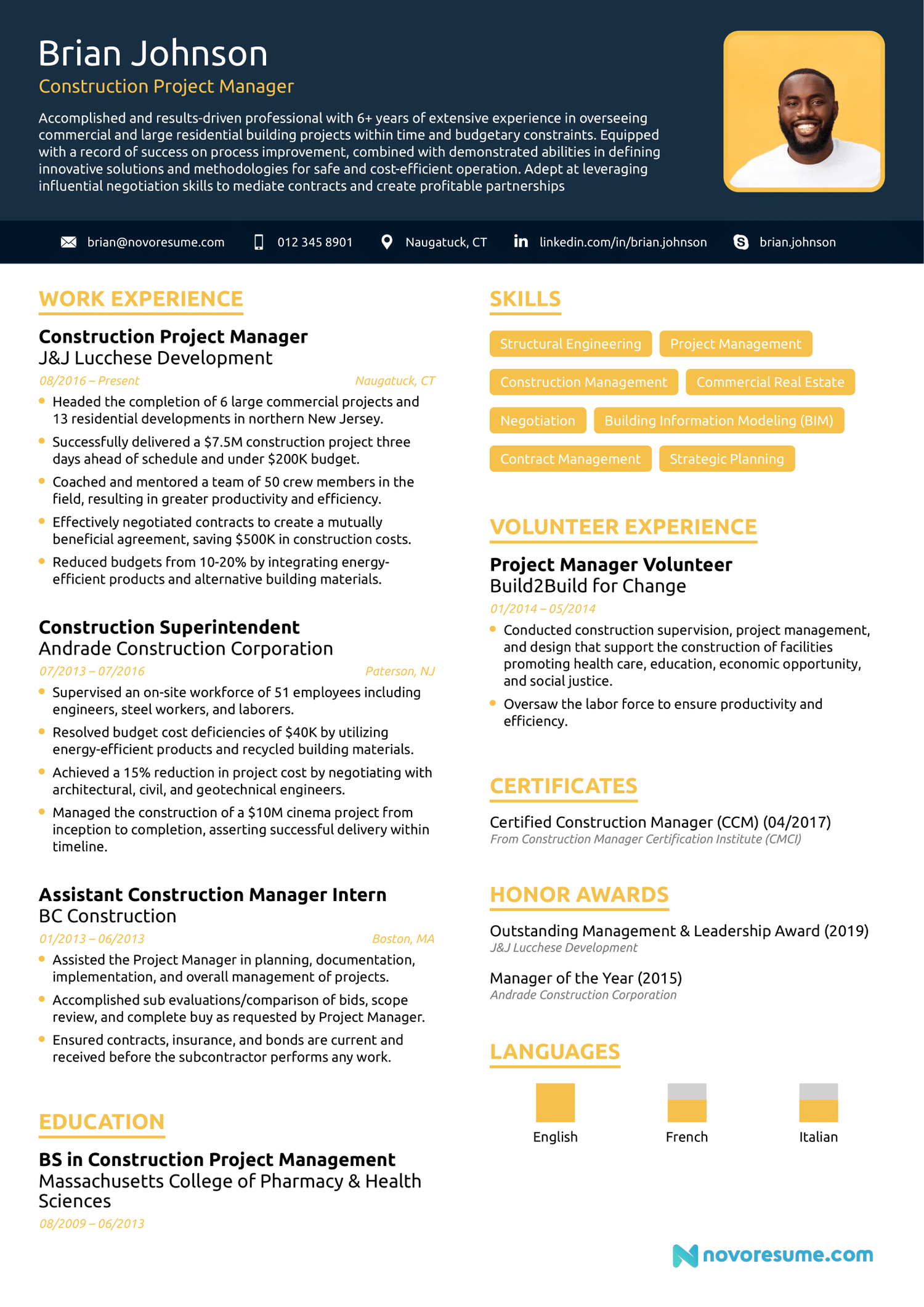
Check out our full guide to writing a construction project manager resume here.
#7. Customer Service Resume Example
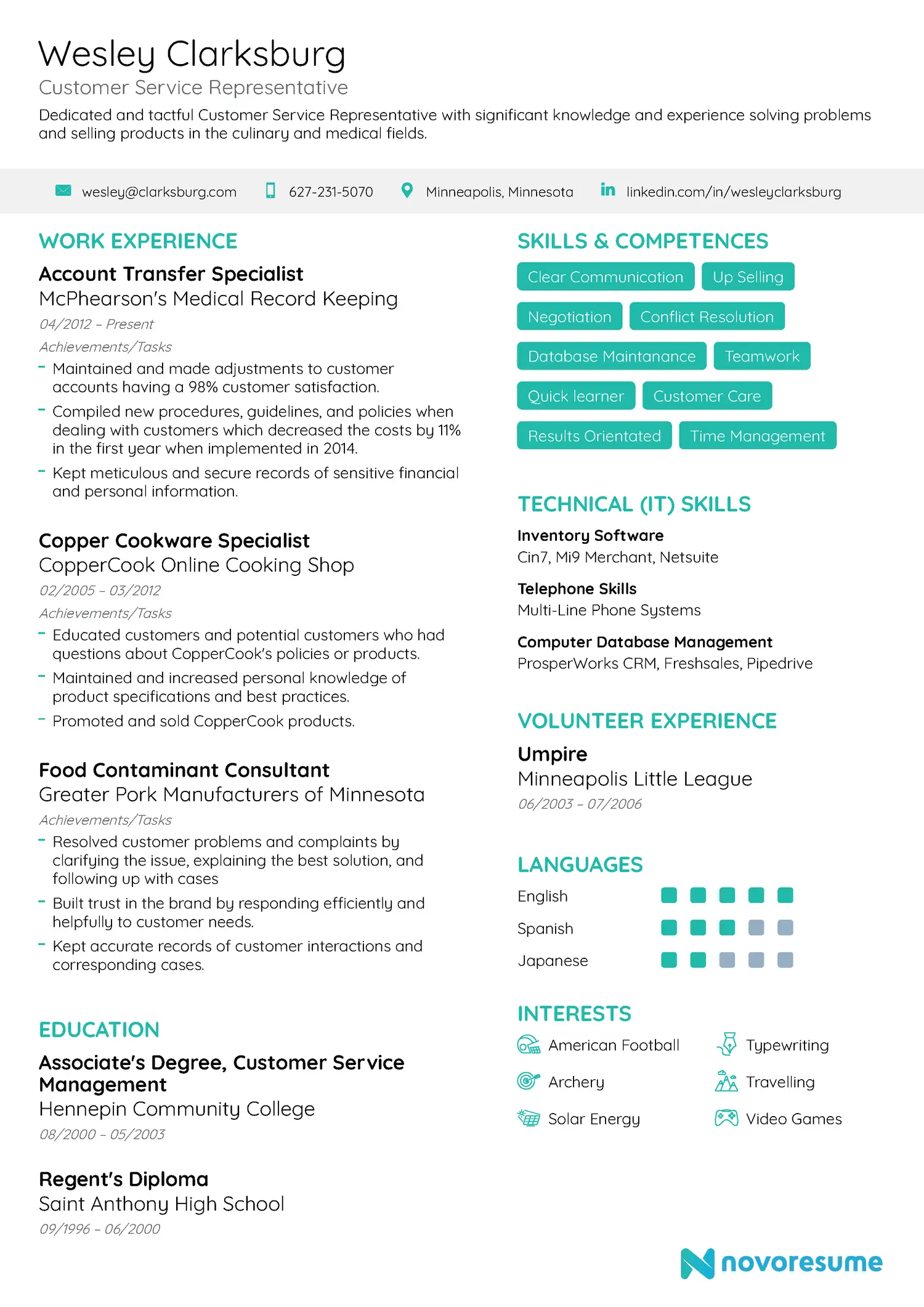
Check out our full guide to writing a customer service resume here.
#8. High School Resume Example
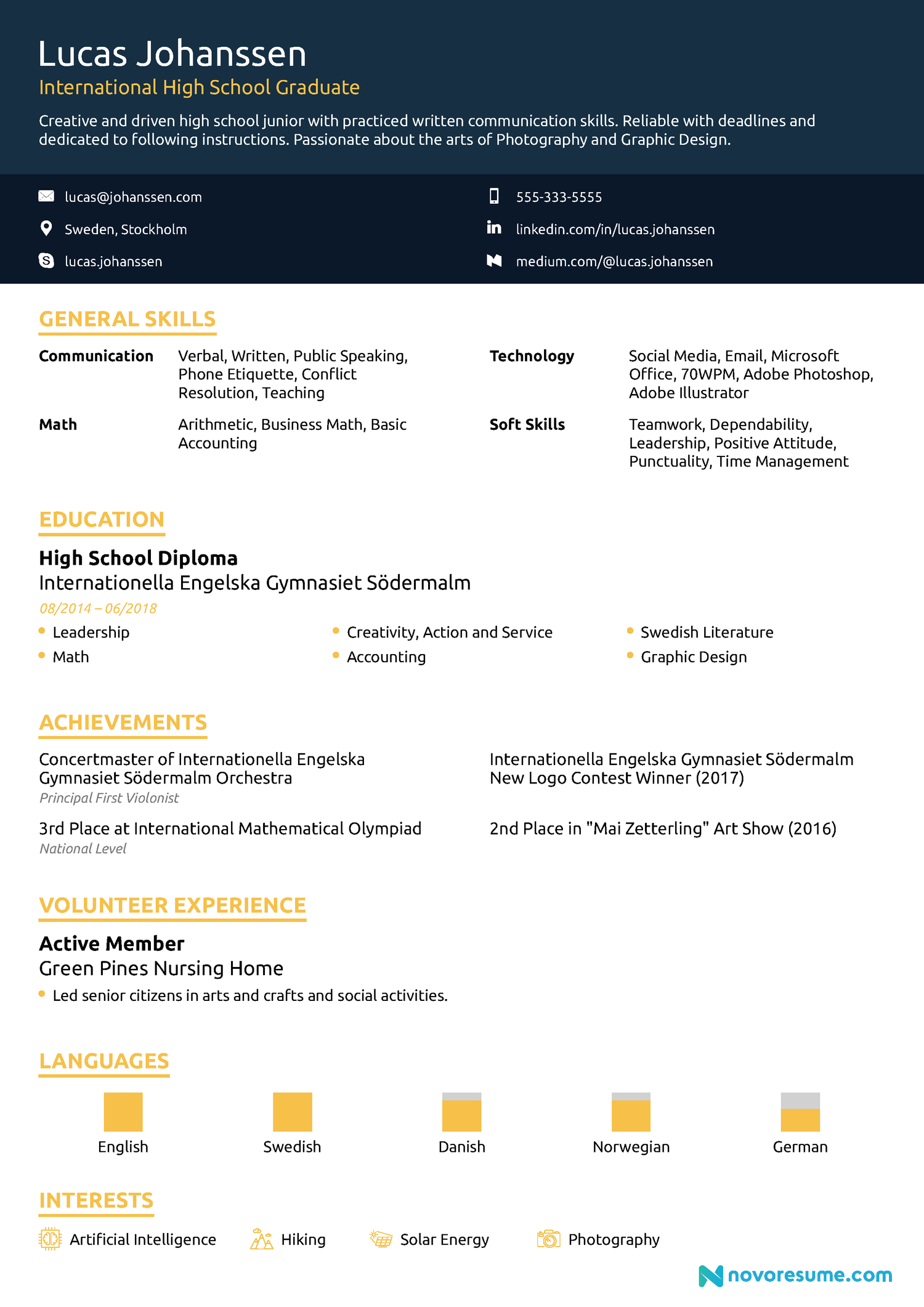
Check out our full guide to writing a high school resume here.
#9. Student Resume Example
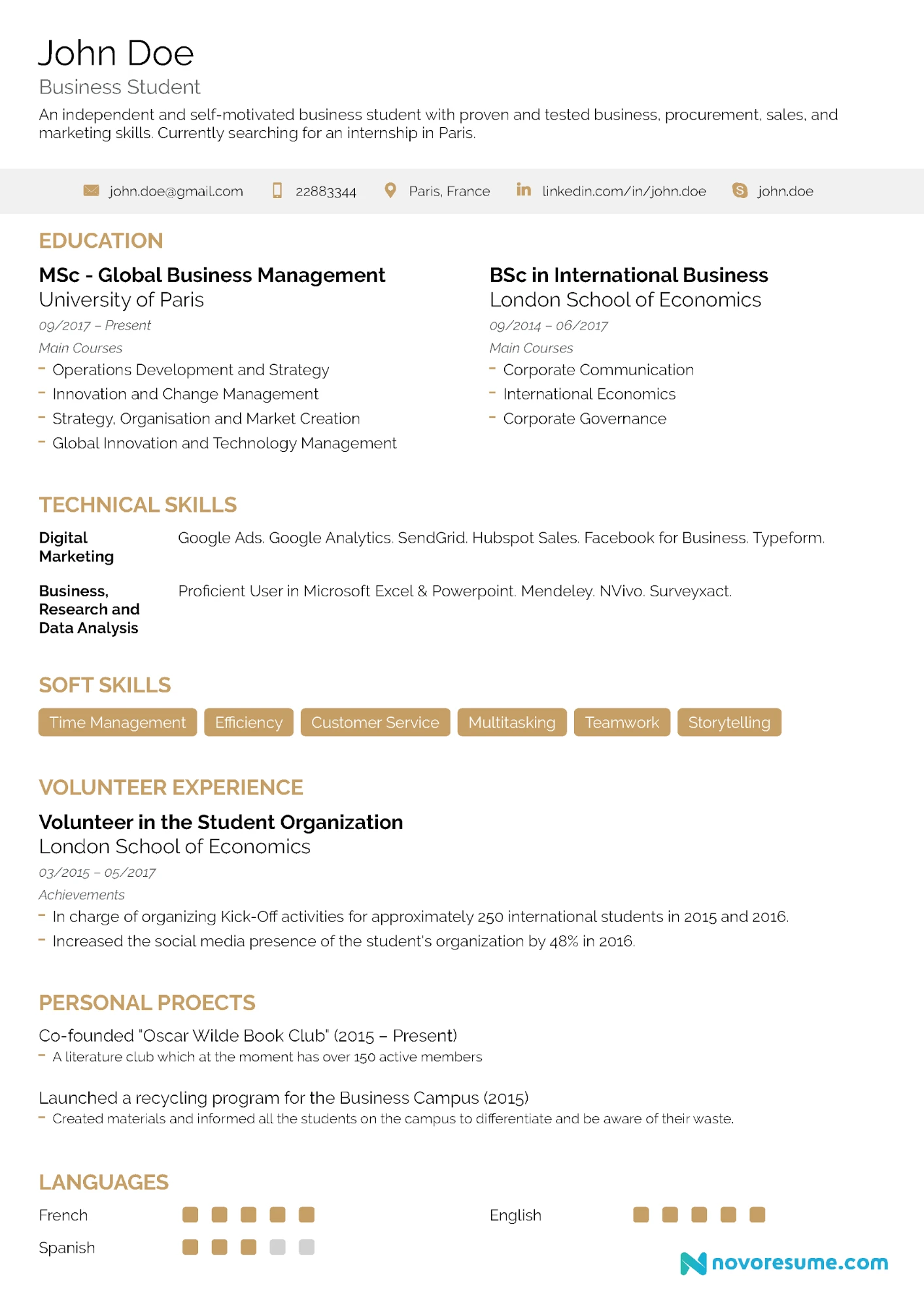
Check out our full guide to writing a student resume here.
#10. Server Resume Example
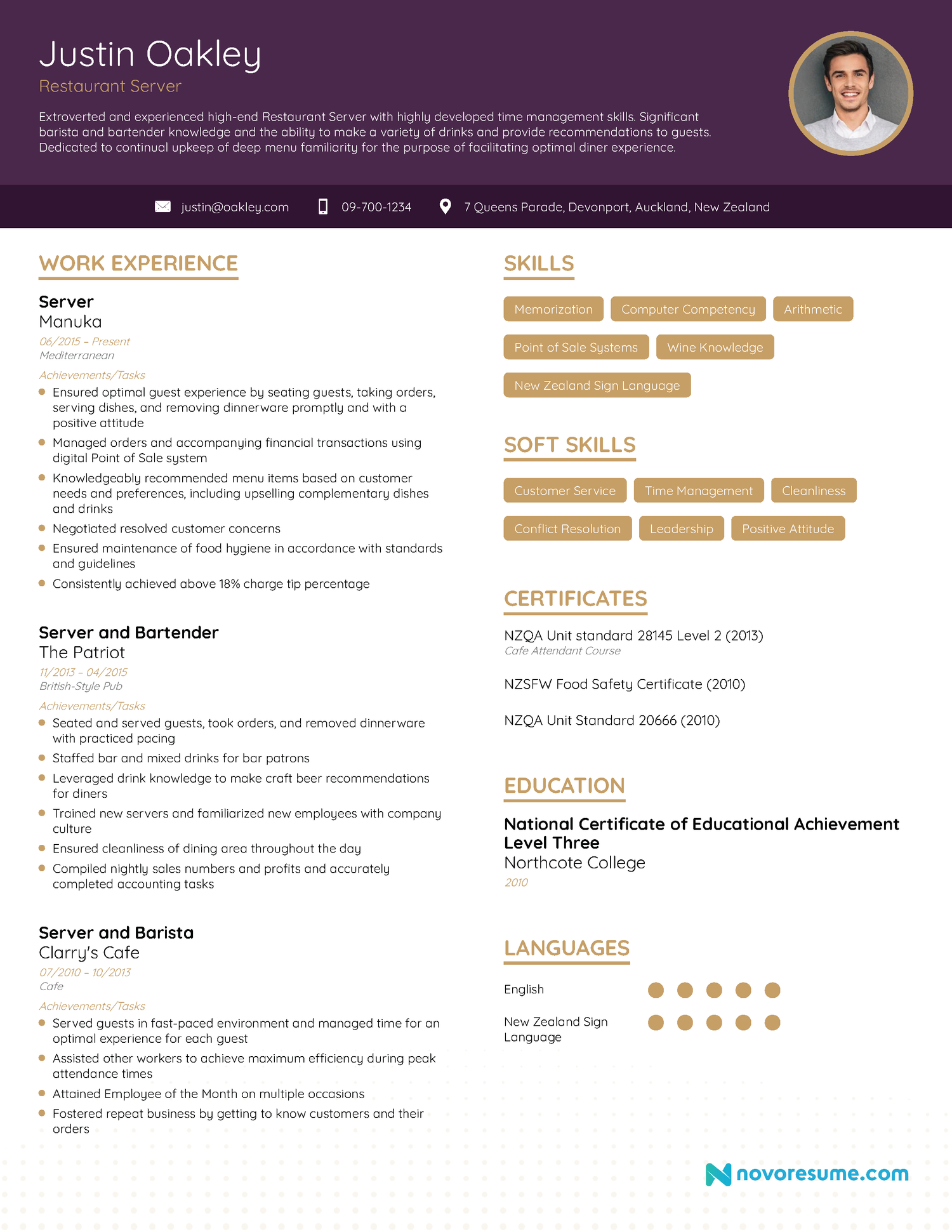
Check out our full guide to writing a server resume here.
#11. Actor Resume Example
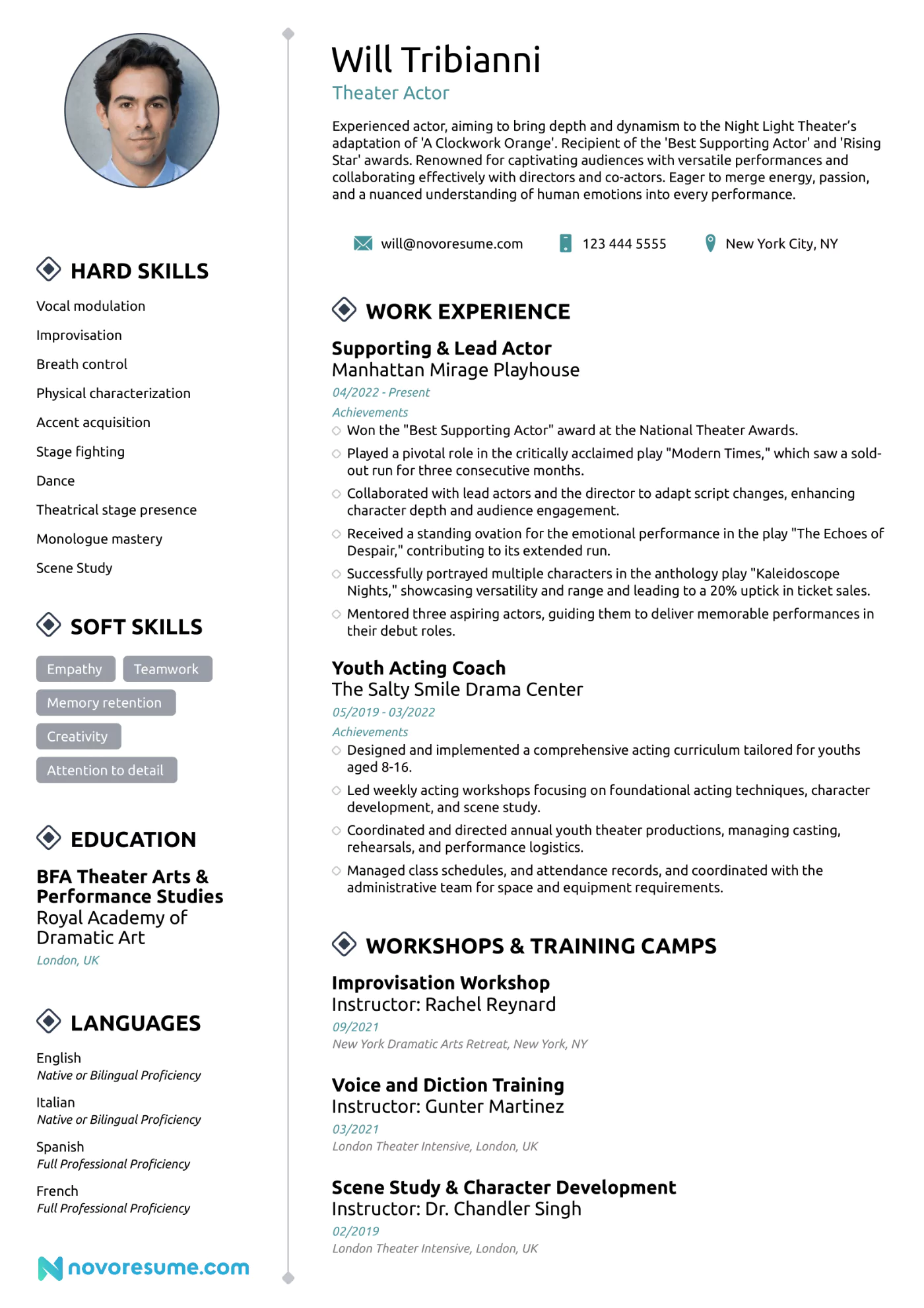
Check out our full guide to writing an actor resume here.
#12. Web Developer Resume Example
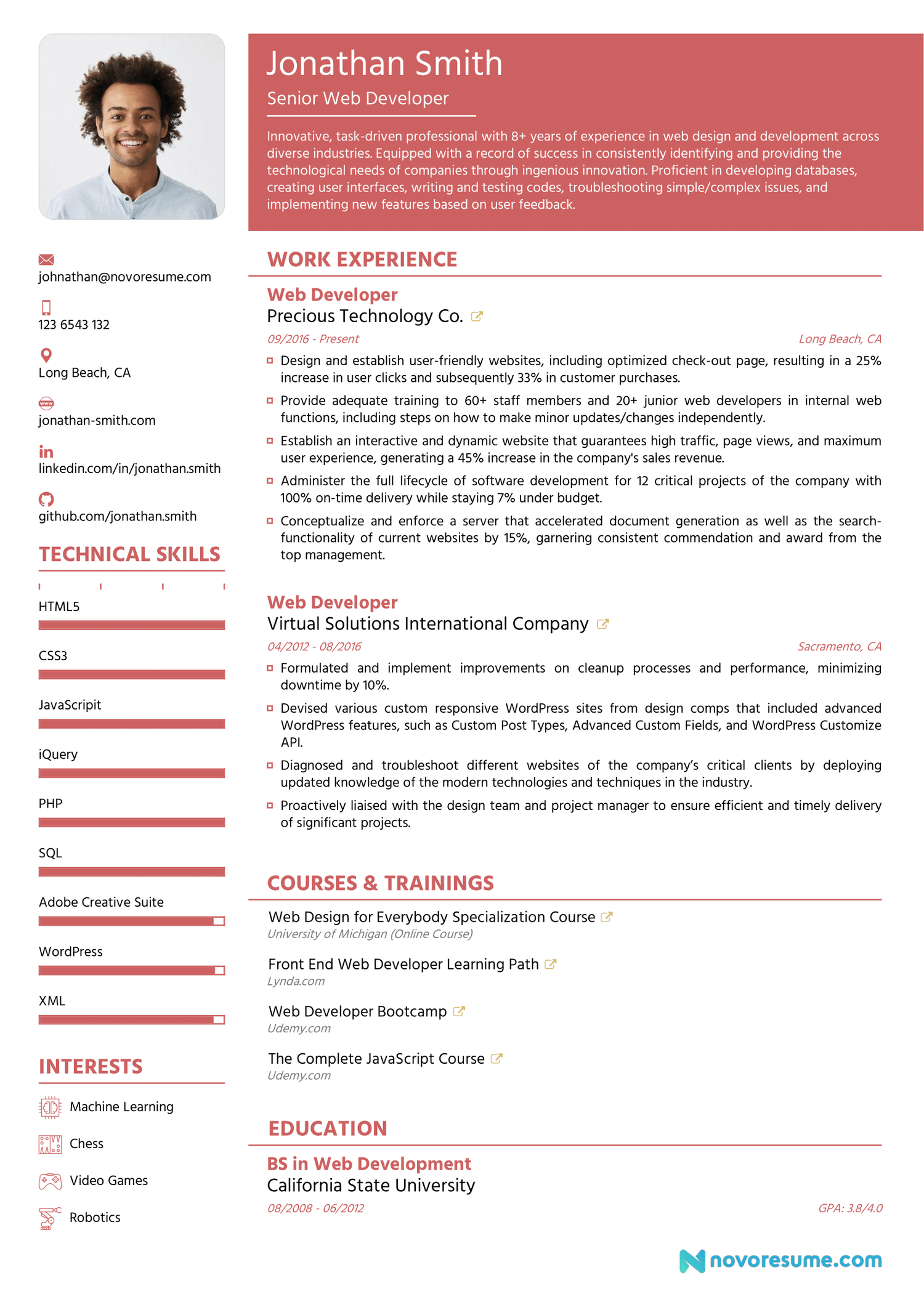
Check out our full guide to writing a web developer resume here.
#13. Engineering Resume Example
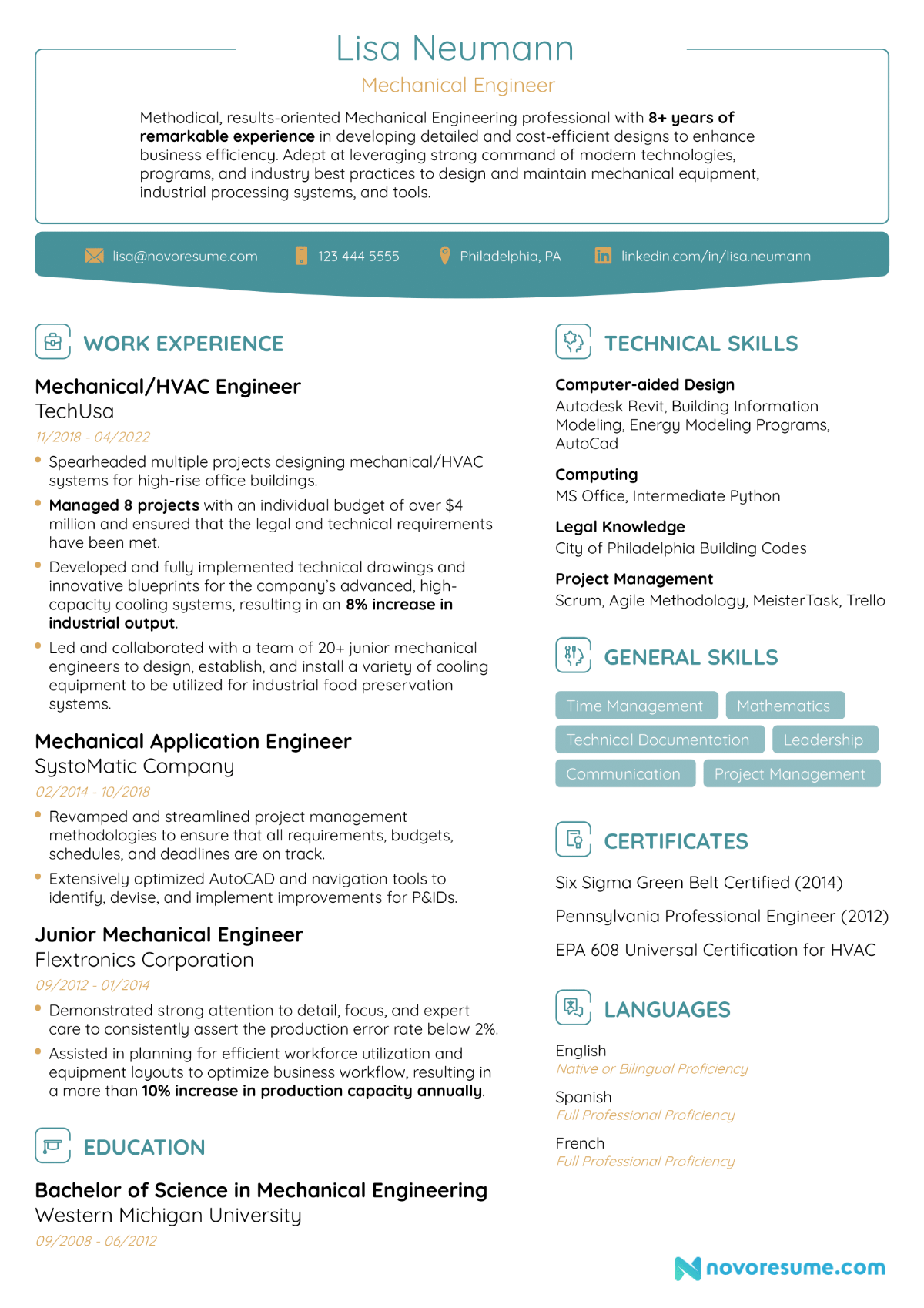
Check out our full guide to writing an engineering resume here.
#14. Computer Science Resume Example
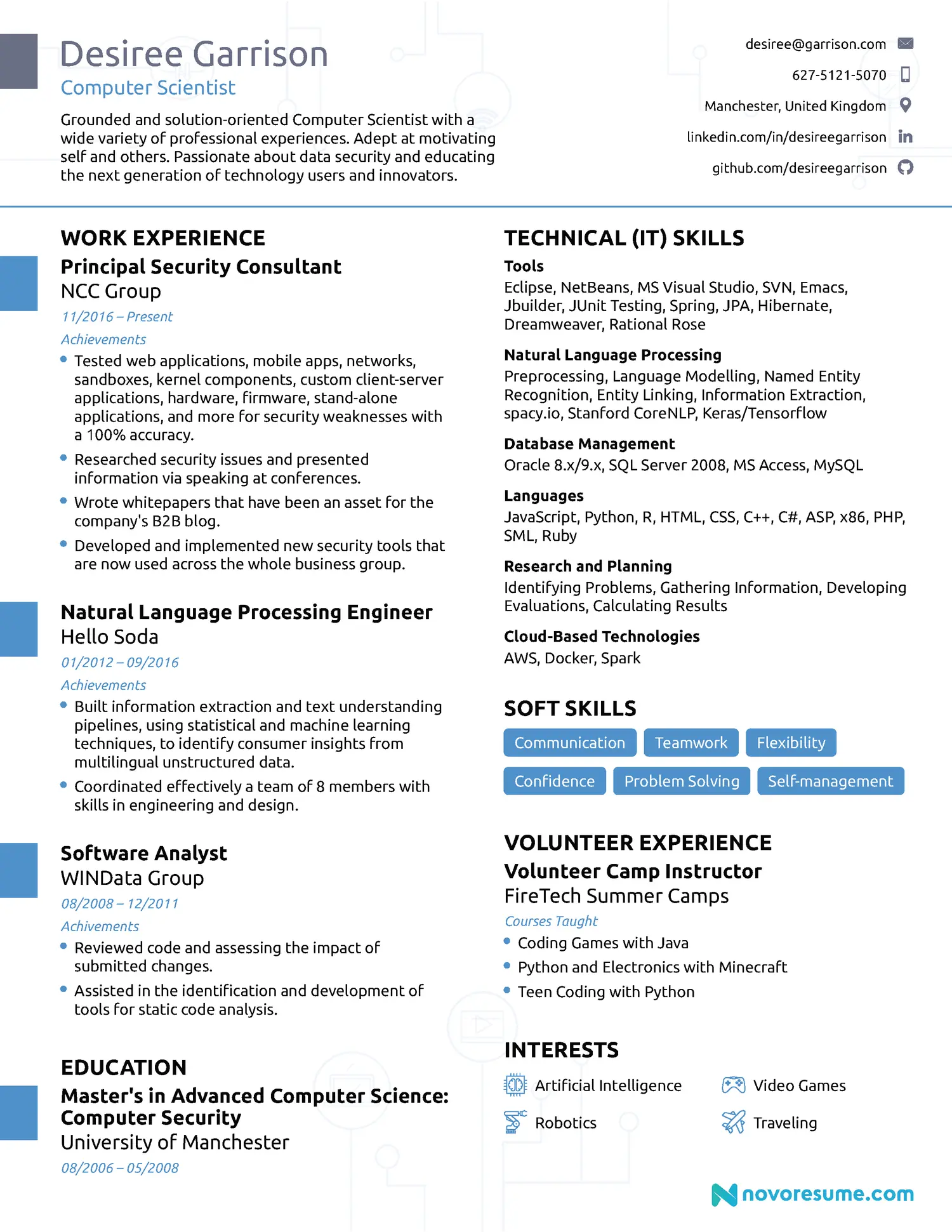
Check out our full guide to writing a computer science resume here.
#15. Architect Resume Example
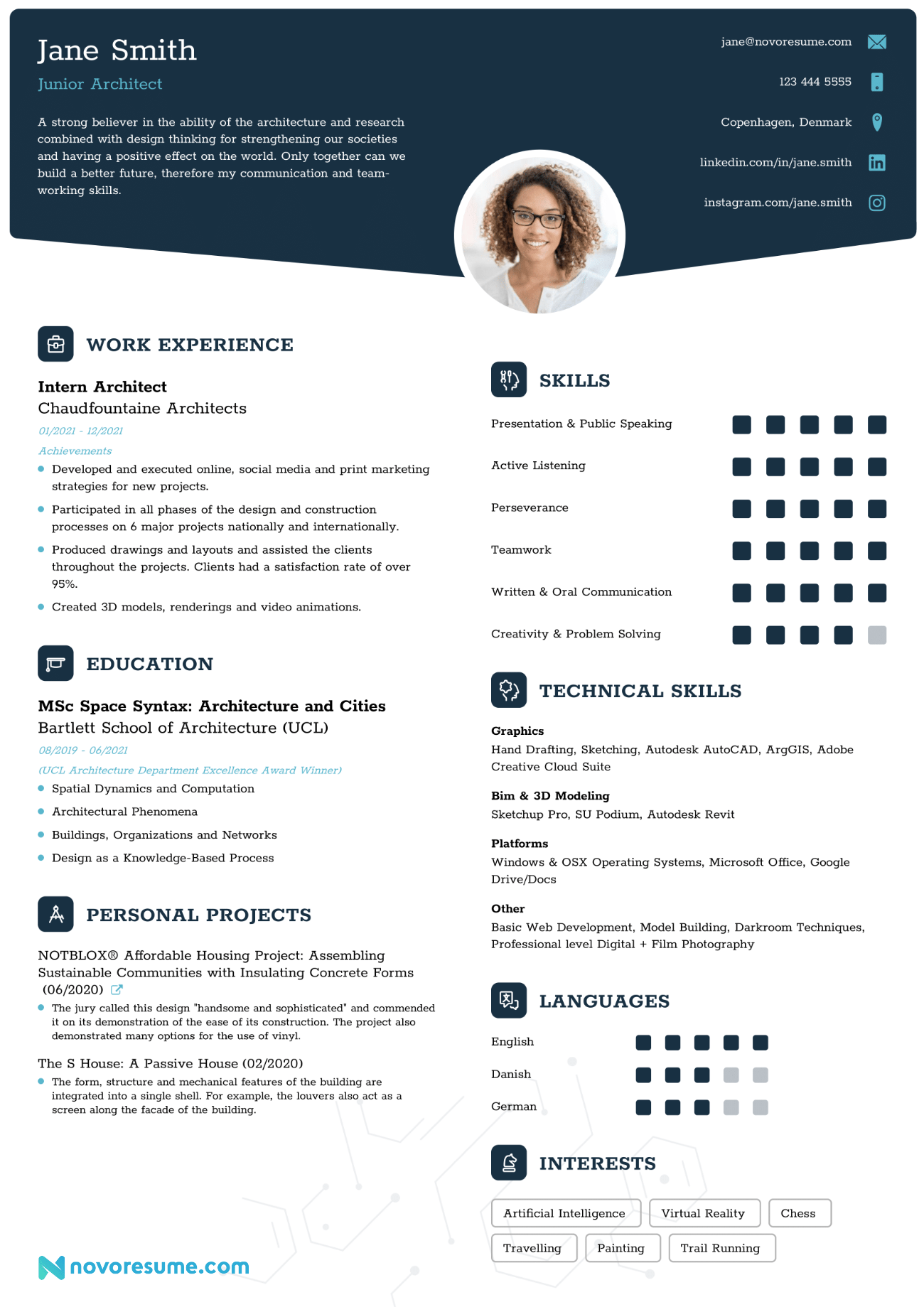
Check out our full guide to writing a data analyst resume here.
#17. Remote Job Resume Example
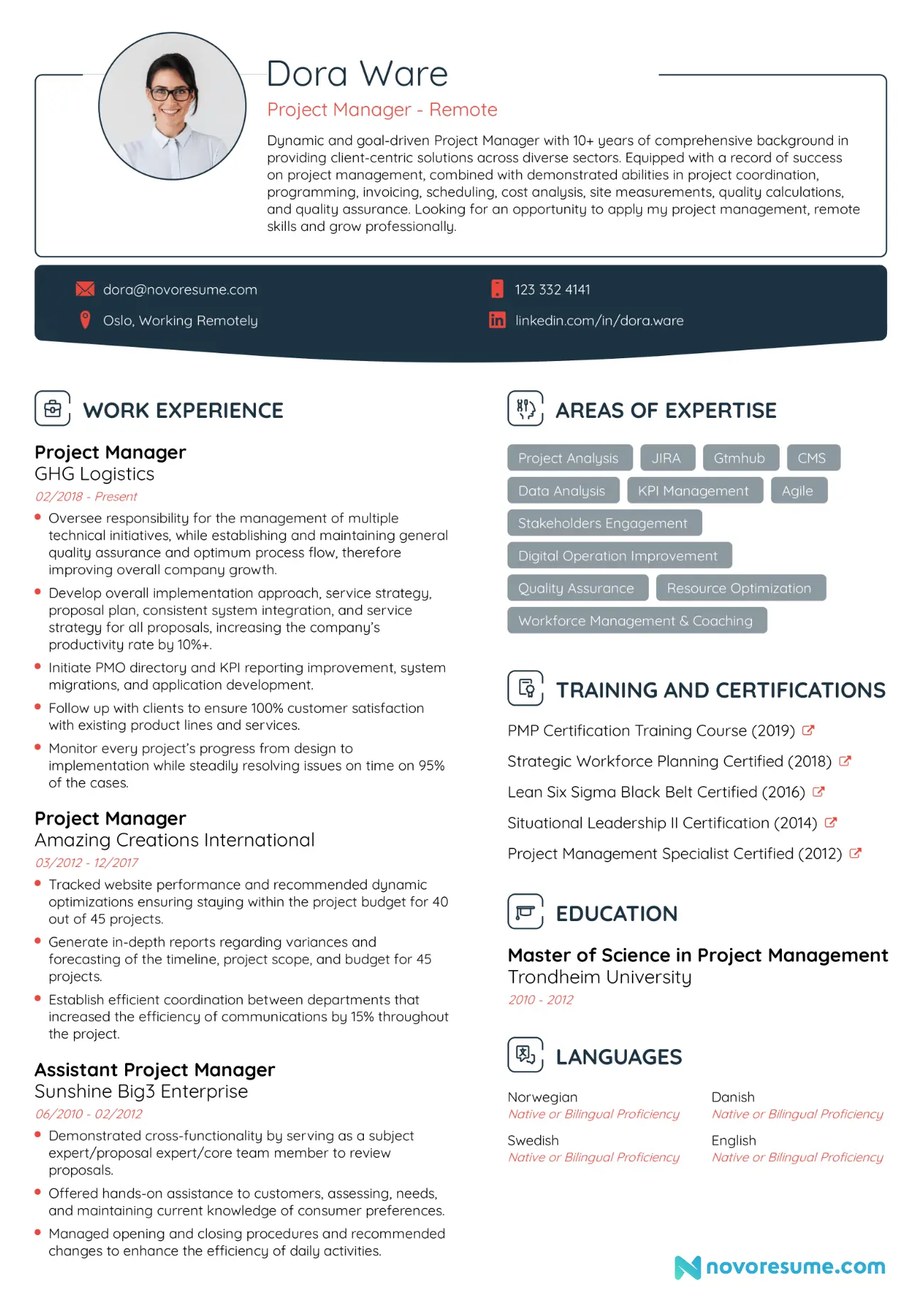
Check out our full guide to writing a remote job resume here.
#18. Sales Associate Resume Example
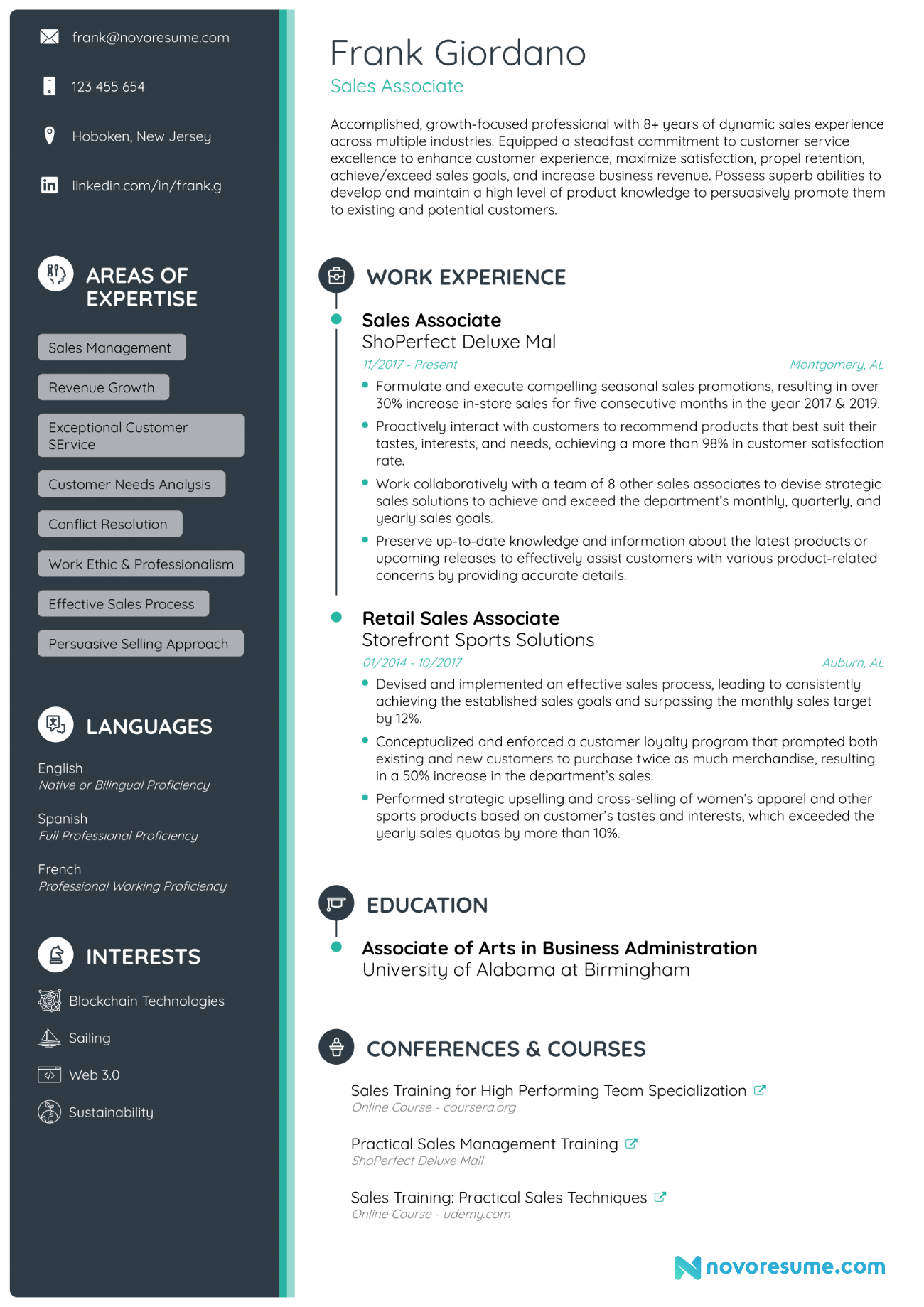
Check out our full guide to writing a sales associate resume here.
#19. Receptionist Resume Example
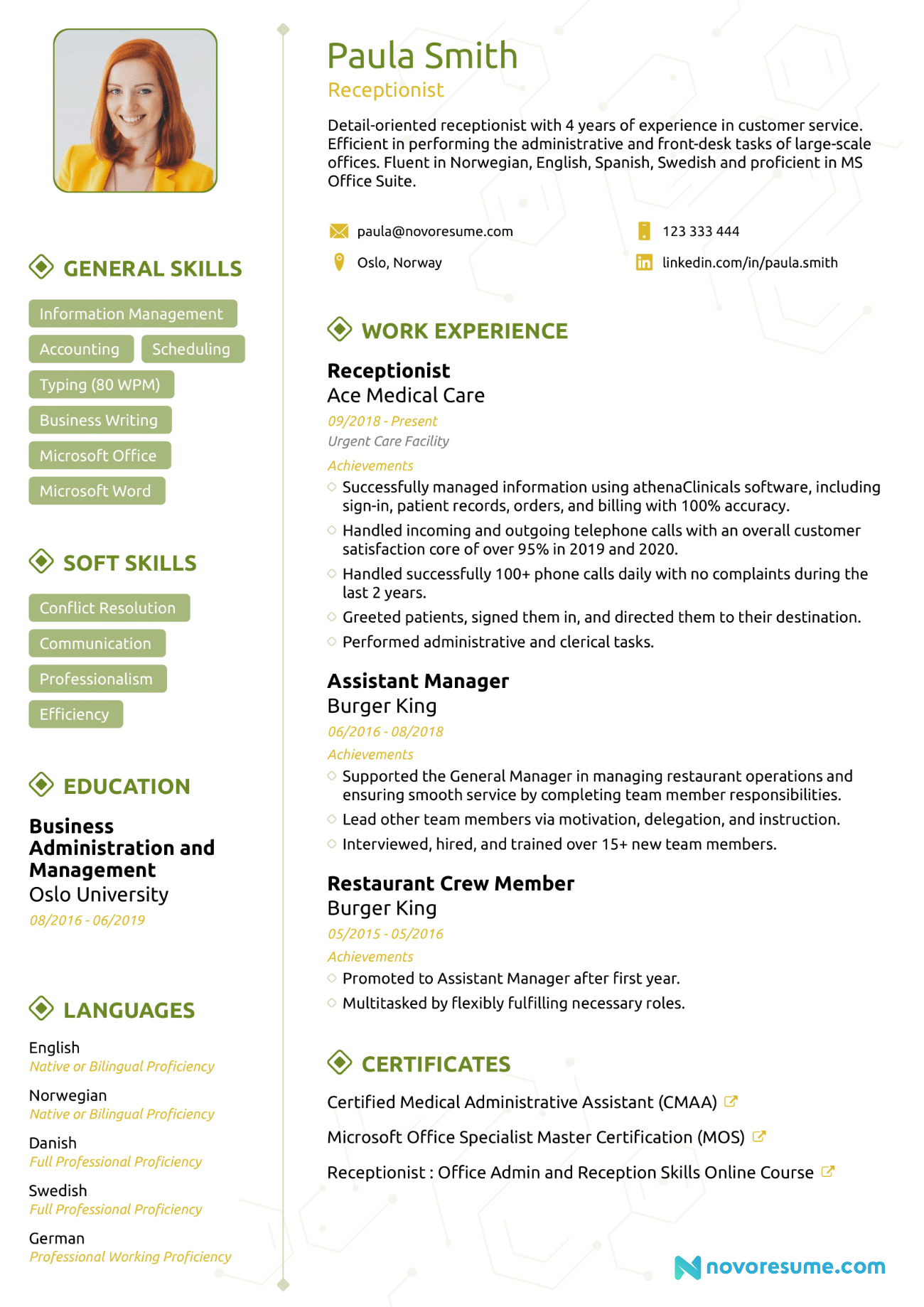
Check out our full guide to writing a receptionist resume here.
Want to see more examples? Check out our compilation of 80+ resume examples for different fields .
- Administrative Assistant Resume
- Bartender Resume
- DevOps Engineer Resume
- Executive Assistant Resume
- Flight Attendant Resume
- Graphic Designer Resume
- Paralegal Resume
- Pharmacist Resume
- Recruiter Resume
- Supervisor Resume
Next Steps After Your Resume
Now that we’ve covered everything you need to know about how to make a resume, it’s time to talk about the rest of your job application.
After all, your resume is only the first step in your job search. To land the job you deserve, you also need to write a captivating cover letter and ace that upcoming interview. Here’s how:
#1. How to Write a Convincing Cover Letter
The companion piece to every resume is the cover letter.
Most job-seekers flinch when they hear that they have to write a cover letter. What do you even mention in a cover letter, anyway? If you were good at writing cover letters, you’d be applying for a job as a writer !
In reality, though, writing a cover letter is very simple once you know its purpose.
Think of your cover letter as a direct message to the hiring manager. It’s your chance to briefly explain why you’re such an awesome fit for the position. And with a few cover letter tips to point you in the right direction, you’ll write the perfect cover letter for your job application.
Just follow this structure:
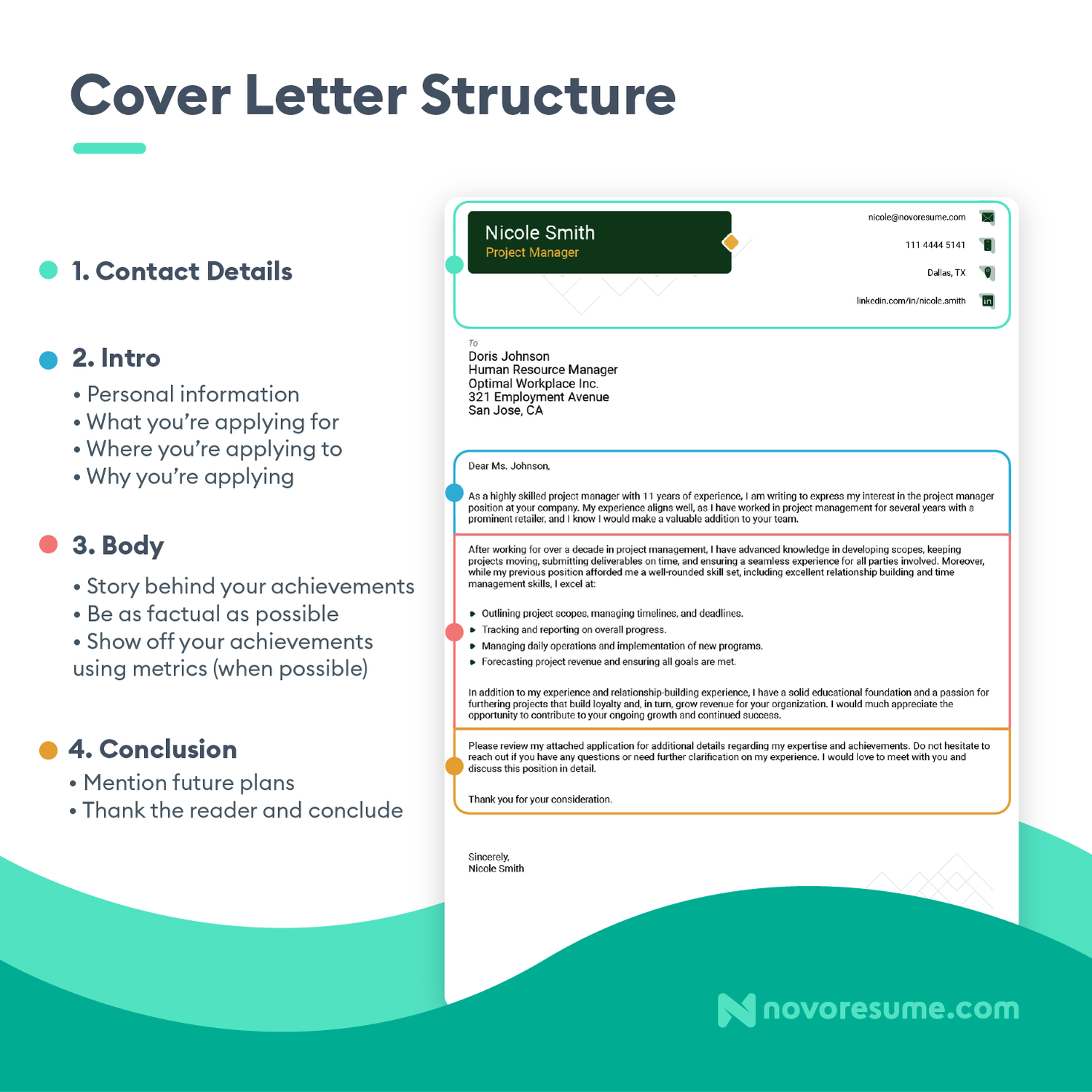
- Add the contact details. Include the same contact information as on your resume, plus additional contact details for the hiring manager, including their name, job title, the company’s name, and location.
- Introduce yourself. Start your cover letter by mentioning who you are, what your work experience is, and why you’re interested in the position. Mention a standout achievement or two, relevant skills, and what you’d like to do for the company you’re applying for.
- Explain why you’d excel at the job. Find the requirements in the job ad that you meet, and elaborate on how you fulfill the most important ones. Research the company so you know what you like about it, and mention it in your cover letter. Make sure to convey your enthusiasm for the job and confidence that you’ll be a great fit for their team.
- Wrap it up politely. Conclude your cover letter by recapping your key selling points and thanking the hiring manager for their time. Then add a call to action, such as “Please don’t hesitate to reach out to me at the provided phone number so that we can discuss my application in greater detail.” Then, add a closing line and follow it with your full name.
Sounds easy, right? Here’s a real-life example to drive the point home:
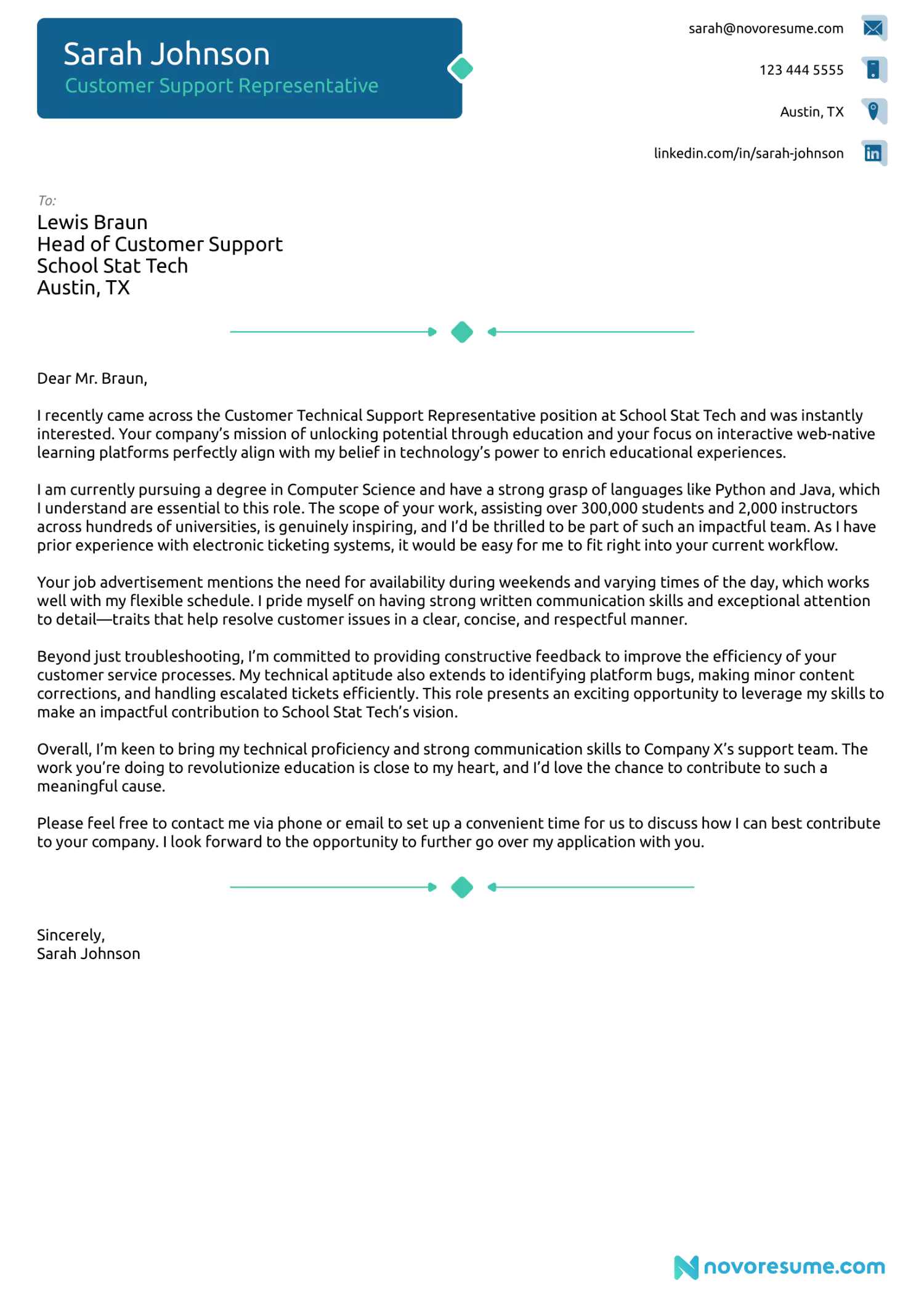
Do you need more help perfecting your cover letter? Learn what the most common cover letter mistakes are and check out cover letter examples for all professions here.
#2. How to Ace Your Next Interview
Once you’ve perfected both your resume and cover letter, there’s only one thing left.
It’s time for the final step—the dreaded job interview.
Whether you’re an extrovert or an introvert, you probably hate the interviewing process. No matter how experienced you are, it can be nerve-wracking. Sitting there while someone’s prodding into your past experiences and judging you isn’t fun.
But did you know that most interviewers ask the same questions?
That’s right—all you have to do is learn how to answer some of the most common interview questions, and you’ll be an interview away from landing your dream job!
Just check out our complete guide to the 35+ Job Interview Questions and Answers and learn how to ace your next interview.
FAQs on How to Make a Resume
Do you still have some questions about making a resume? Check out the answers to the most frequently asked questions below!
#1. What does a good resume look like in 2024?
For your resume to look good in 2024, make sure it’s organized and clean and isn’t longer than one page.
Be sure to include information that adds value to your application—leave out the focus on your relevant work experience and skills that you can back up, and list as many achievements as possible.
If you’re using a resume template, choose one based on your industry. Conservative industries like law, banking, and business require more traditional resume templates. But if you’re going for an industry like design, architecture, or marketing, you can go for a creative resume template .
Remote work is also big in 2024, so if that’s what you’re after, tailor your resume to match the job you want.
#2. How do you make a resume in Word?
The best way to create a resume in Word is to use a pre-designed Microsoft Word template. To access them, you should:
- Open MS Word
- Click “file” from the menu bar
- Select “new”
- Type “resume templates” in the search bar
That said, Word resume templates are generic, hard to personalize, and overall not very stylish.
Want a resume that looks good and is extremely easy to make? Check out resume templates to get started!
#3. How do I write a resume for my first job?
If you’re writing your first-ever resume for an entry-level position, the hiring manager won’t expect you to have any work experience.
However, you can make up for your lack of experience with your skills and academic achievements.
For example, you can take advantage of extracurricular activities, internships, volunteering experiences, and other non-professional experiences. You can use them to highlight the skills you’ve gained and what you’ve achieved so far.
So, your first job resume should have a resume objective, emphasize your education, and replace your work experience with any internships, volunteering, independent projects, or other experiences.
#4. How to make a resume on Google Docs?
You can make a resume on Google Docs by choosing one of their templates and filling it in on the go.
All you have to do is go to your Google Drive’s template gallery, choose your preferred template, fill in your information, and your Google Docs resume is ready to go!
That said, Google Docs templates aren’t the most user-friendly choice. You don’t have much flexibility with the layout and formatting isn’t that easy. For example, you tweak a section to the slightest, and the whole resume becomes a mess.
If you want an easier option, check out our resume builder !
#5. What kind of resume do employers prefer?
Typically, employers prefer one-page-long resumes that follow the reverse chronological format.
Hiring managers receive hundreds of resumes every day, so they don't have the time to read three-page resumes. Try one of our one-page resume templates so you don’t go over the recommended resume length.
Meanwhile, the reverse-chronological format is the most popular because it draws attention to your most recent jobs and professional achievements, which is the #1 most important thing hiring managers look at when evaluating a resume.
#6. How many jobs should you put on your resume?
You should only include relevant job positions on your resume.
This means that your work experience section should be tailored to the job you are applying for. If you’ve worked five different jobs and they can all add value to your current application, then you should include all five.
If, on the other hand, you’re applying for, say, a customer service position and some of your past jobs don’t have anything to do with customer service, you should skip them.
#7. Should I put my address on my resume?
You can put your location (city, state, or country) on your resume, but you don’t need to put your entire physical address.
Putting a physical address on a resume was the norm back when companies would contact you via mail. In today’s world, everyone communicates via email, which is why adding a correct and professional email address to your contact information section is far more important than putting your physical address.
So, just include your location or-–if you’re a remote worker—specify you prefer to work remotely by writing “working remotely from [location].”
#8. What information should I leave out of my resume?
As a general rule, you shouldn’t include your birthday or your headshot on your resume. This norm varies from country to country but it applies to the USA, Canada, and UK.
If you have plenty of achievements to list under your work experience, then you can leave your basic work responsibilities out of your resume.
In your education section, you should only include your highest and most recent degree. So, if you hold a Ph.D., you can list that and your Master’s degree and leave your Bachelor’s degree and high school diploma out.
Finally, leave out any skills that aren’t relevant to the job you’re applying for.
#9. Is a resume a CV?
Depending on where you are, a CV (Curriculum Vitae) and a resume might be completely different things.
In most of the world, though, including Europe and Asia, they are used interchangeably for the same document. Both CVs and resumes are one to two pages long, and list skills and experiences relevant to the position you’re applying for.
Sometimes more detailed resumes that go over one page are referred to as CVs. These are typically only used by senior professionals, executives, CEOs, etc.
In the USA, however, a CV is a completely different document. Typically, CVs are detailed and comprehensive documents that highlight your entire academic and professional history. They’re often used for academic, scientific, or research positions, which is why this type of CV can also be referred to as an academic CV.
You can create your CV using one of our CV templates !
#10. Should I write my own resume?
Yes, you should always write your own resume.
Your resume is your opportunity to show the hiring manager your communication, writing, and presentation skills . Employers also evaluate you based on how effectively you can convey information about yourself, and there’s no one that can represent you better than yourself.
Writing your own resume lets you introduce yourself authentically. You have the best understanding of your skills and experiences, and you can personalize them to make your resume stand out.
And, as a bonus, the experience of writing your resume yourself can be reflective and insightful, so it might help you understand your professional journey and career goals better.
#11. Can a resume be two pages?
Generally, we strongly recommend that your resume stick to one page.
Hiring managers go through hundreds of resumes every day, and keeping your resume to one page increases the odds that they’ll see your qualifications faster.
In some cases, like when you have a lot of relevant experience, your resume can go over two pages. But this exception is reserved for senior professionals with over a decade of relevant experience and tons of skills and achievements that simply can’t fit on one page.
#12. Is a simple resume okay?
Absolutely, a simple resume is often more than okay—it's preferable.
Before your resume even gets to the hiring manager, a complicated layout could get it rejected by the applicant tracking system (ATS). A simple resume template can help get your application straight to the hiring manager.
A clean layout can also make sure that your resume is easily readable and looks professional. This can focus the hiring manager's attention on your work experience and skills without excessive clutter or flashy colors to distract them.
Key Takeaways
And that’s a wrap!
If you’ve followed all of our advice until now, congrats! You’re probably an expert on how to make a resume.
To recap, let’s go through some of the most important lessons we’ve learned so far...
- Use the right resume builder to make the process as smooth as possible. You don’t want to mess around with formatting for hours before even starting to work on your resume!
- Focus on your achievements over responsibilities. This can help you stand out from all the other applicants, especially if you back your claims up with data.
- Include all the must-have sections, like the resume summary, work experience, education, and skills. Then leverage optional sections if you have leftover space.
- Tailor your resume for the job you’re applying for. Everything listed on your resume should be relevant to the specific job you’re applying for, and you should write a new resume for every new job application.
- Take the time to perfect your cover letter. It’s just as important as your resume, so make sure you pay as much attention to it!

To provide a safer experience, the best content and great communication, we use cookies. Learn how we use them for non-authenticated users.
- For Individuals
- For Businesses
- For Universities
- For Governments
- Online Degrees
- Join for Free

How to Write a Resume (Project-Centered Course)

Instructor: Holly Justice
Financial aid available
223,993 already enrolled

(3,828 reviews)

Details to know

Add to your LinkedIn profile
2 assignments
See how employees at top companies are mastering in-demand skills

Earn a career certificate
Add this credential to your LinkedIn profile, resume, or CV
Share it on social media and in your performance review

There are 7 modules in this course
What you’ll achieve:
In this project-centered course*, you will craft an essential cornerstone of the modern-day job or internship search: the resume. You’ll review resume best practices and explore current trends with guidance from a professional career counselor and recruiter, and you’ll exchange structured feedback with your peers as you work to polish your own resume. When you complete the course, you’ll have an eye-catching resume that lets your professional strengths shine. What you’ll need to get started: This course is designed primarily for young professionals or college students who are writing their first resume or looking to give an old resume a fresh and polished professional look. All job seekers will benefit from the course material and project, however, regardless of their career stage or professional background. All you will need is word processing software that allows you to create a resume on a computer- there are free tools available. *About Project-Centered Courses: Project-centered courses are designed to help you complete a personally meaningful real-world project, with your instructor and a community of like-minded supportive learners with similar goals providing guidance and suggestions along the way. By actively applying new concepts as you learn, you’ll master the course content more efficiently; you’ll also get a head start on using the skills you gain to make positive changes in your life and career. When you complete the course, you’ll have a finished project that you’ll be proud to use and share.
Introduction to the Course & Resumes
Define course goals. Introduction about purpose of a resume, and when it might be used, and criteria for the peer-review rubric.
What's included
1 video 2 readings 1 assignment 1 discussion prompt
1 video • Total 2 minutes
- Video Lecture: Introduction • 2 minutes • Preview module
2 readings • Total 20 minutes
- About the Instructor • 10 minutes
- Resume Rubric • 10 minutes
1 assignment • Total 14 minutes
- Resume Rubric True & False • 14 minutes
1 discussion prompt • Total 10 minutes
- Module 1: Knowing the Rubric • 10 minutes
The Foundation of your Resume: A Self-Inventory
A top-to-bottom look at the typical sections of a resume. Different sections you might have on a resume, definition of transferable skills and how to pull those out of past experiences.
1 video 1 reading 1 discussion prompt
1 video • Total 6 minutes
- Video Lecture: Module 2 • 6 minutes • Preview module
1 reading • Total 10 minutes
- Differences of Resumes Internationally • 10 minutes
- Module 2: Transferable Skills • 10 minutes
Writing Content for your Resume
How to write an action-statement, what makes a strong verb, how to maximize use of numbers and other characters, and common pitfalls of writing the content.
1 video 1 assignment 1 peer review
1 video • Total 12 minutes
- Video Lecture 3: Creating Content • 12 minutes • Preview module
1 assignment • Total 30 minutes
- Practicing Bullet Points • 30 minutes
1 peer review • Total 60 minutes
- Get Feedback on your Resume Content • 60 minutes
Piecing it all Together: Organization, Structure, Format
How to organize the sections on the document, foundations of strong structure and clear formatting.
1 video • Total 10 minutes
- Video Lecture 4: Piecing it all Together • 10 minutes • Preview module
Know your Industry
Different types of jobs are going to look for different headings, or different orders of sections for the optimal response from an employer. Define “Buzz Words” and show how to identify them in a job posting, and then implement them on the resume.
- Video Lecture 5: Know your Industry • 6 minutes • Preview module
- Some Key Notes about LinkedIn • 10 minutes
- Module 5: Know your Industry • 10 minutes
Best-Practices for your Resume from an Employer
Interview with an employer about how they approach a stack of resumes, what stands out in a good way, and what can leave a negative impression.
1 video 1 discussion prompt
1 video • Total 7 minutes
- Video Lecture 6: Interview with an Employer • 7 minutes • Preview module
- Module 6: Employer Interview • 10 minutes
Frequently Asked Questions
Common questions about resumes job-seekers might have, that may not have fit into our modules.
1 video 1 reading 1 peer review
1 video • Total 8 minutes
- Video Lecture 7: Frequently Asked Questions • 8 minutes • Preview module
- Resume Review Rubric • 10 minutes
- Peer Resume Review • 60 minutes
Instructor ratings
We asked all learners to give feedback on our instructors based on the quality of their teaching style.

The State University of New York, with 64 unique institutions, is the largest comprehensive system of higher education in the United States. Educating nearly 468,000 students in more than 7,500 degree and certificate programs both on campus and online, SUNY has nearly 3 million alumni around the globe.
Recommended if you're interested in Personal Development

École Polytechnique
How to Write and Publish a Scientific Paper (Project-Centered Course)
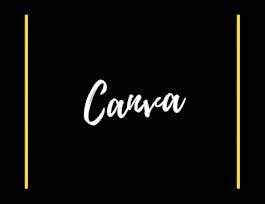
Coursera Project Network
Build a Professional Resume using Canva
Guided Project
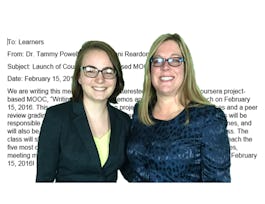
Kennesaw State University
Writing Professional Email and Memos (Project-Centered Course)

The State University of New York
How to Get Skilled: Introduction to Individual Skills Management (Project-Centered Course)
Why people choose coursera for their career.

Learner reviews
Showing 3 of 3828
3,828 reviews
Reviewed on Jul 21, 2021
Before taking this course I didn't know there are some deep insights in making a good resume. This course helped me a lot in learning how you should represent yourself in your resume. Thanks!!
Reviewed on Jul 3, 2020
The course helped me tweak my professional resume. It helped me strengthen my bullet points and provided with a clear understanding of mentioning the relevant information in my resume.
Reviewed on Jul 28, 2020
It was a really good course . I learned a lot about resume writing and understanding the do's and dont's while writing resume. It would really help me make a professional resume
New to Personal Development? Start here.

Open new doors with Coursera Plus
Unlimited access to 7,000+ world-class courses, hands-on projects, and job-ready certificate programs - all included in your subscription
Advance your career with an online degree
Earn a degree from world-class universities - 100% online
Join over 3,400 global companies that choose Coursera for Business
Upskill your employees to excel in the digital economy
Frequently asked questions
When will i have access to the lectures and assignments.
Access to lectures and assignments depends on your type of enrollment. If you take a course in audit mode, you will be able to see most course materials for free. To access graded assignments and to earn a Certificate, you will need to purchase the Certificate experience, during or after your audit. If you don't see the audit option:
The course may not offer an audit option. You can try a Free Trial instead, or apply for Financial Aid.
The course may offer 'Full Course, No Certificate' instead. This option lets you see all course materials, submit required assessments, and get a final grade. This also means that you will not be able to purchase a Certificate experience.
What will I get if I purchase the Certificate?
When you purchase a Certificate you get access to all course materials, including graded assignments. Upon completing the course, your electronic Certificate will be added to your Accomplishments page - from there, you can print your Certificate or add it to your LinkedIn profile. If you only want to read and view the course content, you can audit the course for free.
What is the refund policy?
You will be eligible for a full refund until two weeks after your payment date, or (for courses that have just launched) until two weeks after the first session of the course begins, whichever is later. You cannot receive a refund once you’ve earned a Course Certificate, even if you complete the course within the two-week refund period. See our full refund policy Opens in a new tab .
Is financial aid available?
Yes. In select learning programs, you can apply for financial aid or a scholarship if you can’t afford the enrollment fee. If fin aid or scholarship is available for your learning program selection, you’ll find a link to apply on the description page.
More questions
100 Most Popular Courses For October
Your source for the latest news and trends in online education.
600 Free Google Certifications
Most common
- project management
- machine learning
Popular subjects
- Communication Skills
- Data Analysis
Digital Marketing
Popular courses
Transport Systems: Global Issues and Future Innovations
Greek and Roman Mythology
The Science of Success: What Researchers Know that You Should Know
Class Central
- classcentral.com
- Browse Courses
- Write a Review
- About Class Central
- Best Courses
- Free Certificates
- Best Free Online Courses of All Time
- Most Popular Online Courses of All Time
- Featured Articles
- Online Learning Guides
- Student Voices
Disclosure: Class Central is learner-supported. When you buy through links on our site, we may earn an affiliate commission.
8 Best Resume Writing Courses for 2024: Get that Job!
Make an outstanding first impression and grab that job with the best resume writing online courses for various situations, plus some interview skills.
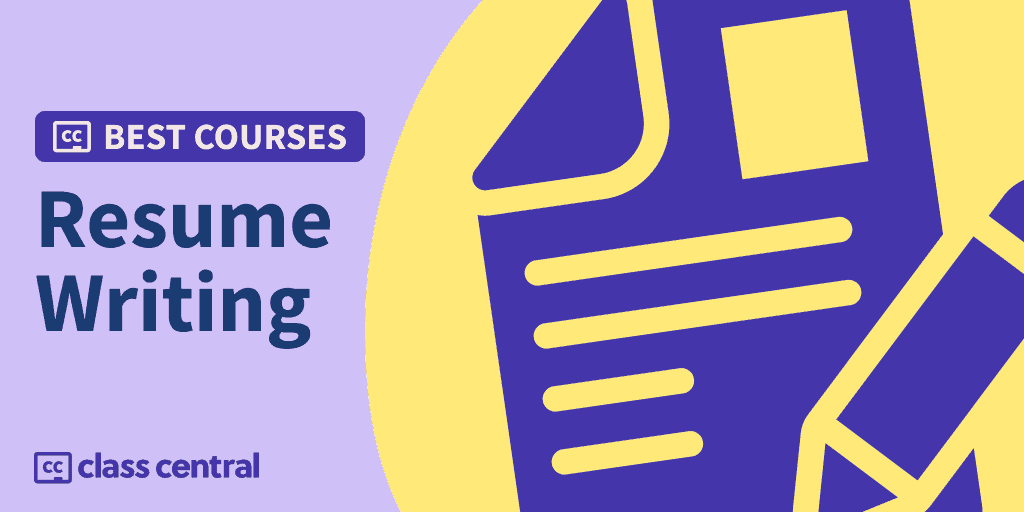
Resumes are pretty much the very first step while applying for almost any job. They give potential employers a first-hand idea of who you are and why you might be a good fit for that job before they even get to meet you. So your resume needs to be top-notch.
In this Best Courses Guide (BCG), I’ve selected the 10 best free and paid resume writing online courses for you from the 50+ resume writing courses in our catalog by following our well-defined methodology that you can find below.
Click on the shortcuts for more details:
What is Resume Writing?
Why you should trust us, how we made our picks and tested them.
Click to jump to course details:
| Course for Resume Writing and Job Search Basics (LinkedIn Learning) | 2-3 hours |
| 13 hours | |
| 2-3 hours | |
| Short Course for Beginners (Professor Heather Austin) | 1-2 hours |
| (Saylor Academy) | 5 hours |
| Course for Data Science Resumes (Great Learning) | <1 hour |
| 12 hours | |
| 6 hours |

Related Guides
- Public Speaking
- Copywriting
- Negotiation
- English Grammar
Recommended Guides
- Dropshipping
- Microsoft Word
- Emotional Intelligence
Trending Guides
- Graphic Design
- American Sign Language (ASL)
A resume is a formal document, typically of one to two pages, that highlights a candidate’s education, experience and skills. Job seekers write resumes while applying for a job so recruiters can evaluate their competency and worth. Employers may collect resumes in person, through a company’s career website, a job search engine, or a professional social media page.
The word “resume” originally comes from the French word ‘ résumé ’, past participle of résumer which means “to summarize”. However, this term is primarily used in America and Canada to represent a document that showcases your skills and work experiences, and not in France and other parts of Europe where a curriculum vitae (or CV) is used instead. In India, Pakistan and Bangladesh, biodata is often used in place of a resume.
Fun fact : Did you know that Leonardo da Vinci was the first recorded person to write a resume in the 15th century (even though it was more of a letter)?
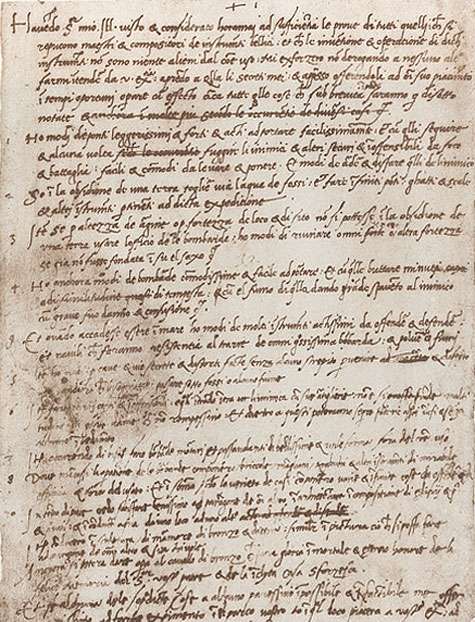
Why are Resume Writing Skills Important?
Resumes create your first impression to potential employers. Indeed notes down a few more reasons why resumes are important:
- Provides an opportunity to market yourself to employers
- Outlines your skills, background and education so employers can easily see how your experience can contribute to the success of a company
- Helps employers eliminate unqualified candidates
- Allows you to demonstrate your written communication skills
- Combined, these courses have accrued over 780K enrollments and views.
- 4 courses are free or free-to-audit and 4 courses are paid .
- The most-represented course providers are Udemy and YouTube, with 2 courses each.
- All 8 courses are in English including 1 with subtitles in Hindi.
- The Resume Writing subject is followed by over 8.6K learners on Class Central.
Best Free Course for Resume Writing and Job Search Basics (LinkedIn Learning)
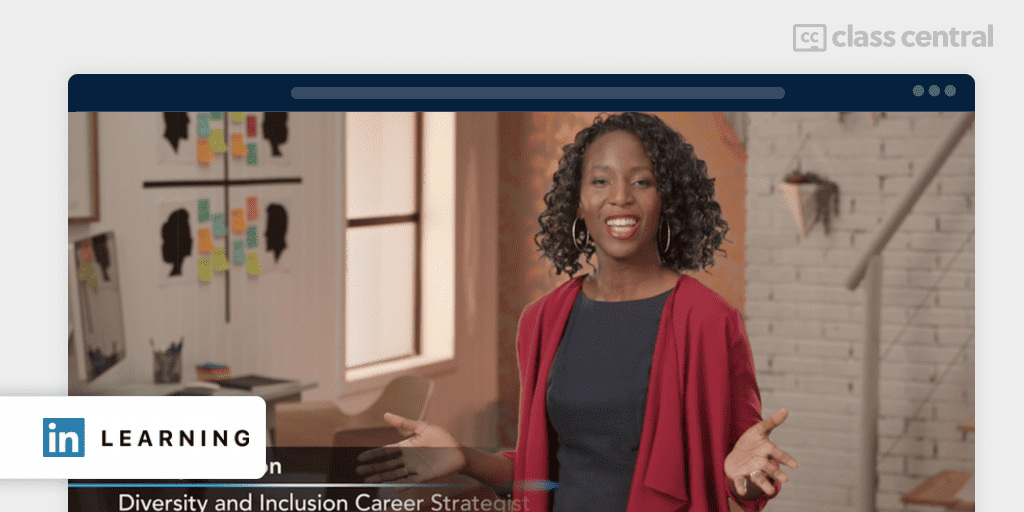
My pick for the best resume writing online course is Writing a Resume , available for free on LinkedIn Learning. In fact, LinkedIn Learning is a great resource for free and paid resume-writing courses, which is no surprise given their focus on networking and career advancement.
In this course, you’ll learn:
- Basic components of Resume Writing : objective statement, skills, work experience, education, and technical skills
- Customization : tailor resume components to match specific job requirements
- Enhancements : upgrade resume with achievements, awards, and publications
- Formatting : choose the right layout and formatting for an effective resume
- Alternative designs : explore different resume designs for various industries and regions
- Handling challenges : address career changes, employment gaps, and long-term unemployment in resumes
- Stand out : use the resume to showcase skills, achievements, and stand out from other applicants
- Job search strategies : conduct a successful job search by focusing on objectives, desired skills, education, and volunteer work
- Best practices : learn how to use resumes in online applications, interviews, networking, and informational interviews
- Proactive job search : identify potential companies, determine fit, and find contacts for a proactive job search.
Stacey Gordon is focused on improving workplace cultures. Her mission is to reduce bias in global talent acquisition and management. She offers diversity, inclusion and career related online courses on LinkedIn Learning. Her book, “ UNBIAS: Addressing Unconscious Bias at Work ”, is an ‘action manual’ for you to remove barriers and ensure equity throughout your organization.
LinkedIn Learning courses on writing specific types of resumes include:
- Writing a Tech Resume (1 hour)
- Resume Makeover (2 hours)
- Designing a Resume for Creatives (1-2 hours)
- Designing a Resume in InDesign (<1 hour)
- Creating a Video Resume (<1 hour)
- Find Your Dream Job: Interview Techniques and Resume Writing (2 hours)
| LinkedIn Learning | |
| Stacey Gordon | |
| Beginner | |
| 2-3 hours | |
| 483K | |
| 4.8/5.0 (5.8K) | |
| Free | |
| Practice exercises, quizzes | |
| Free |
Best Intermediate Course for Business Style Resumes (University of Maryland, College Park)
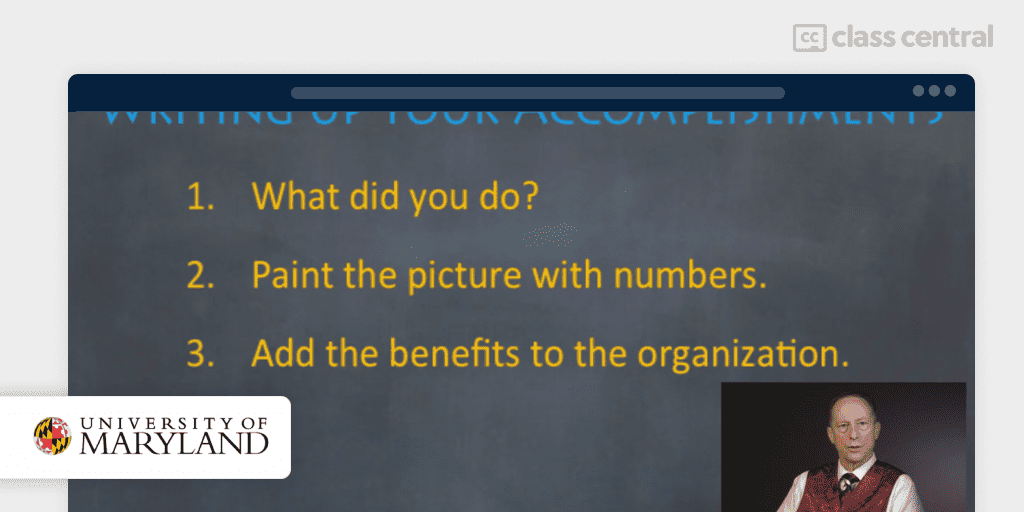
Writing Winning Resumes and Cover Letters is a free-to-audit course for intermediate learners with B2 English skills who want to grab the attention of prospective employers using the language they already speak inside their organization. You’ll get answers to any related questions that you might have, and convert a boring resume into a dynamic asset statement. By the end of this course, you’ll be able to write your resume in a language that employers understand.
You’ll learn to:
- Customize resumes for specific job opportunities
- Rank high in relevance scales used by top organizations
- Craft powerful accomplishment statements
- Summarize experiences in language employers understand
- Choose the best format for career goals
- Prepare for electronic submission
- Write an effective cover letter
- Know what information to exclude from your resume
- How to follow up after an interview
Charles Duquette is a lecturer and Marketing Coordinator at University of Maryland, College Park. He studied Biology at Georgetown University, Finance at University of Maryland, Mechanical Engineering at The Catholic University of America, and Computer Science at Johns Hopkins University.
| University of Maryland, College Park | |
| Coursera | |
| Charles Duquette | |
| Intermediate | |
| 13 hours | |
| 51.5K | |
| 4.6/5.0 (316) | |
| Free audit | |
| Quizzes | |
| Paid |
Best Beginner Course to Design Professional Documents and Build InDesign Skills (Skillshare)
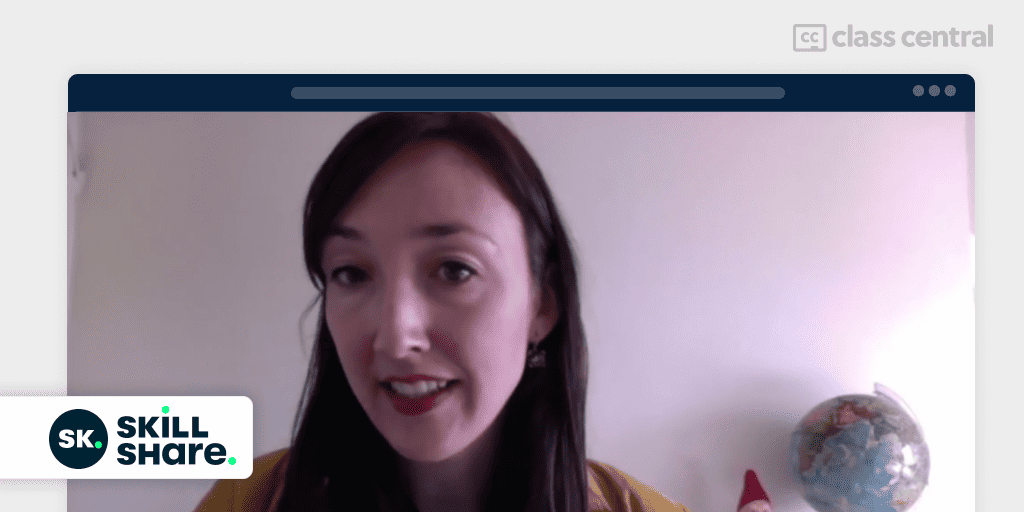
Are you a student, a marketing professional or a freelancer? Redesign Your Resume: Designing Professional Documents will teach you how to design professional documents and use InDesign to enhance communication. Using resumes as the starting point, you’ll explore some great examples by creative professionals. You’ll also build InDesign skills that you can apply to other documents as well.
In this course:
- Take inspiration from resumes, CVs and general documents
- Work on key design concepts, layouts, text boxes, and details in InDesign
- Create master pages, learn design terms and concepts
- Discover tips for working with fonts and type
- Finalize your document.
Anne Ditmeyer is an American designer and creative coach based in Paris, France.
| Skillshare | |
| Anne Ditmeyer | |
| Beginner | |
| 2-3 hours | |
| 6K | |
| 100% | |
| Paid | |
| Projects | |
| Not available |
Best Free Short Course for Beginners (Professor Heather Austin)
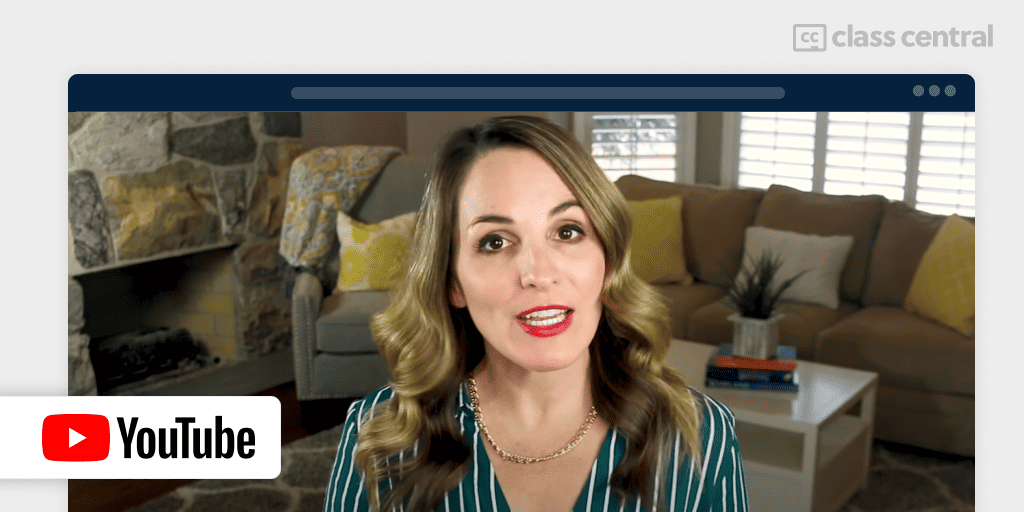
Within just a couple of hours, you’ll have a great resume that will get you noticed, with How To Write A Winning Resume – Top Resume Writing Tips by Professor Heather Austin on YouTube.
This short, free course will guide you through the process, including important resume writing tips and secrets that will put you ahead of the crowd. You’ll explore examples of good resumes and also get to know where to find sample resume templates that you can download and tailor to apply for your next job.
- Start with a template and examples
- Write a resume summary
- Create an ATS-friendly resume
- Craft a resume with little or no work experience
- Increase chances of getting hired
- Format a resume quickly and effectively
- Include achievements in a resume
- Access additional resources for resume writing
Heather Austin is the host of #TheCareerClub on Facebook and the creator of ProfessorAustin.com . She teaches professionals how to navigate the job search process from building a solid social media presence on LinkedIn to nailing those tough interview questions.
| YouTube | |
| Heather Austin | |
| Beginner | |
| 1-2 hours | |
| 17.3K | |
| Free | |
| None – video lectures only | |
| Not available |
Best Course for Resumes and Cover Letters with Free Certificate (Saylor Academy)
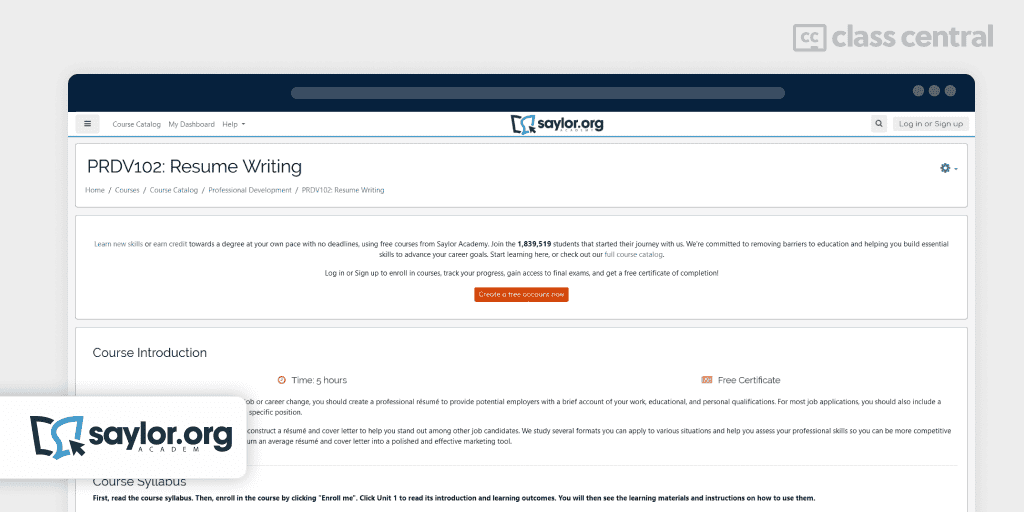
PRDV102: Resume Writing is designed to guide you through the intricacies of crafting a compelling resume and cover letter. It’s comprehensive, covering the basics of resume structure and advanced techniques for making your application stand out. You’ll learn how to effectively communicate your skills and experiences, tailor your application to specific job descriptions, and avoid common pitfalls. This course is accessible to anyone looking to improve their job application with up-to-date advice and practical tips.
What you’ll learn:
- The fundamental structure and essential elements of a resume and cover letter
- How to tailor your resume and cover letter to match job descriptions
- Strategies to enhance the appeal of your resume and cover letter
- Common mistakes in resume and cover letter writing and how to avoid them.
Saylor Academy is a nonprofit organization established in 2008 to offer free and open online courses to all who want to learn.
| Saylor Academy | |
| Beginner/Intermediate | |
| 5 hours | |
| Free | |
| 4.7/5.0 (3) | |
| Quizzes | |
| Free |
Best Free Course for Data Science Resumes (Great Learning)
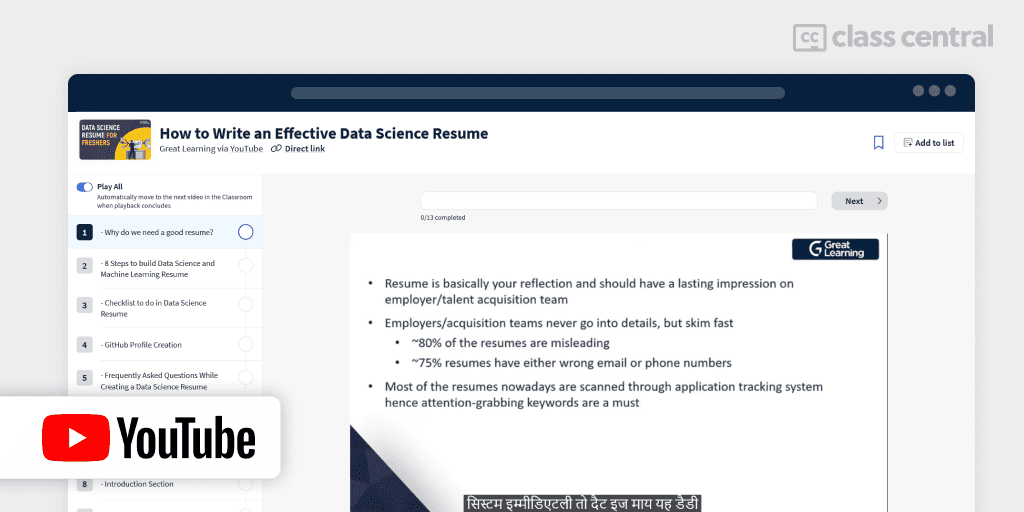
If you want to break into the data science field and secure a job in top companies, this free course is for you. Great Learning offers How to Write an Effective Data Science Resume designed to guide freshers on crafting an effective Data Science resume. It emphasizes the importance of a well-constructed resume, highlighting that it is often the first step to getting noticed by recruiters and hiring managers. The course covers why a good resume is crucial, provides an 8-step process to build a Data Science and Machine Learning resume and offers a checklist for resume creation. This course focuses on the specific needs of the data science industry and is particularly beneficial for those with no prior experience in resume writing for this field.
What you will gain from this course:
- Understand the significance of a well-crafted resume in the data science job market
- A step-by-step guide to creating a Data Science and Machine Learning resume, including layout, format, and cover letter
- How to craft a professional summary, detail technical skills and expertise, and present work experience effectively
- Tips on showcasing academic or personal projects, education, and other relevant details
- Guidance on creating a GitHub profile to enhance your resume
- Answers to frequently asked questions about Data Science resume creation.
Great Learning aims to make quality education accessible to anyone who wants to learn.
| YouTube | |
| Great Learning | |
| Beginner/Intermediate | |
| <1 hour | |
| English with subtitles in Hindi | |
| 2.8K | |
| 90 thumbs-up | |
| Free | |
| Examples | |
| Not available |
Best Course for InterviewIng, Resume/LinkedIn, and Networking Skills (Udemy)
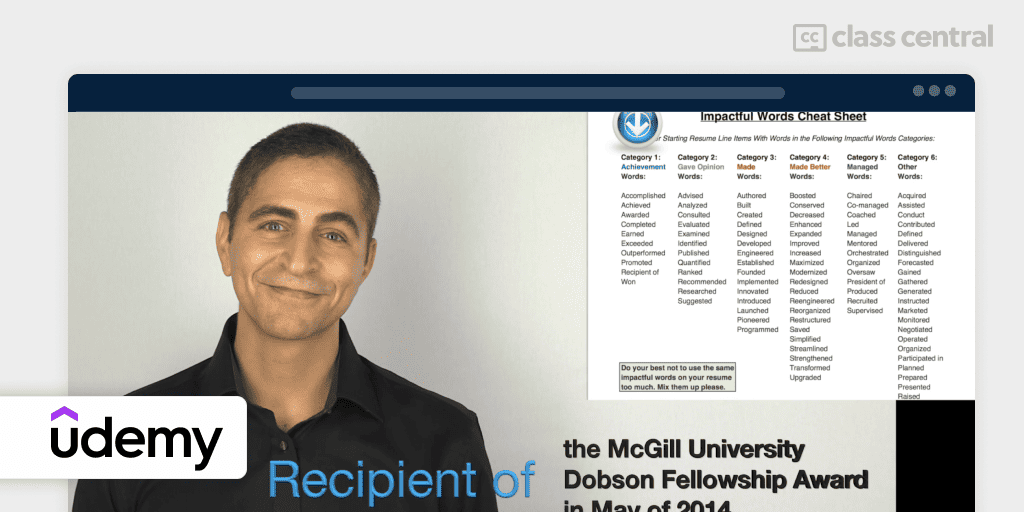
The Complete Resume, LinkedIn & Get Your Dream Job Course! is a 3-part course that teaches you the three most important topics for getting a job: interviewing, resume/LinkedIn and networking skills. No matter at what stage of your career you’re at, this course will help you get the job you want.
- Build the perfect resume
- Interview better than others
- Make the best LinkedIn profile
- Network better than anyone else
- Get your dream job.
Chris Haroun is the founder and CEO of the online Haroun MBA Degree Program and the founder and CEO of Haroun Education Ventures. He’s also the author of a book, “ 101 Crucial Lessons They Don’t Teach You in Business School ”.
| Udemy | |
| Chris Haroun | |
| Beginner | |
| 12 hours | |
| 117K | |
| 4.6/5.0 (6.7K) | |
| Paid | |
| Downloadable resources | |
| Paid |
Also Great Course for Resume and Cover Letters, Interview and Networking Skills (Udemy)
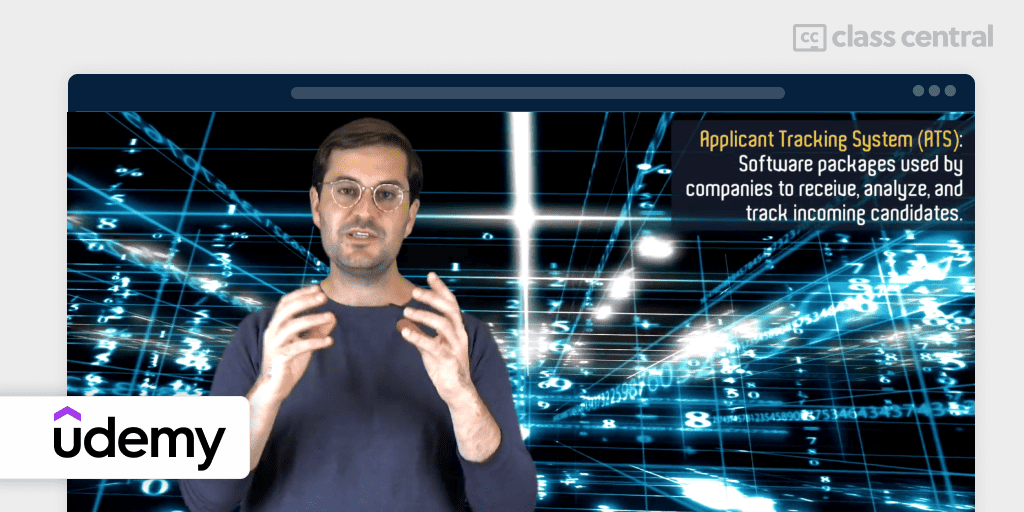
No matter what stage you are in your career, you’ll learn resume writing, LinkedIn profiles, cover letters, interviewing and networking skills in Career Hacking: The Ultimate Job Search Course (Now w/ AI!) . These skills are necessary to get the job of your dreams, and this course makes it all possible.
- Prepare a keyword-rich, targeted resume
- Present yourself powerfully on LinkedIn
- Interview competently and persuasively
- Create career opportunities using traditional and non-traditional methods
- Build relevant professional networks
- Set the stage for a rewarding career
- Now with AI prompts for ChatGPT & Claude.
Davis and Ludell Jones are, respectively, Chief Learning Officer and COO of Eazl courseware, that launched in 2013. Today, Eazl courseware helps teams at many leading organizations make faster progress on their goals.
| Udemy | |
| Davis Jones, Ludell Jones, Emma Jeffers | |
| Beginner | |
| 6 hours | |
| 80K | |
| 4.5/5.0 (9.2K) | |
| Paid | |
| Quizzes, downloadable resources | |
| Paid |
Class Central , a Tripadvisor for online education, has helped 60 million learners find their next course. We’ve been combing through online education for more than a decade to aggregate a catalog of 200,000 online courses and 200,000 reviews written by our users. And we’re online learners ourselves: combined, the Class Central team has completed over 400 online courses, including online degrees.
I (Archisha) am a Guided Project Instructor and a Beta Tester at Coursera, having tested many courses before they’re officially launched. I have taken over 50 online courses in various subjects. Throughout school and college, I was taught to write good resumes as part of my curriculum. I scored high and landed a pretty decent job!
My experience as an online learner and teacher has given me some perspective on what to look for in an online course. I used my experience to evaluate the courses in this list.
I built this guide following the now tried-and-tested methodology I used previously ( you can find them all here ). It involves a three-step process:
- Research: I started by leveraging Class Central’s database. Then, I made a preliminary selection of resume writing courses by rating, reviews, and bookmarks
- Evaluate: I read through reviews on Class Central, Reddit, and course providers to understand what other learners thought about each course and combined it with my own experience as a learner
- Select: Well-made courses were picked if they presented valuable and engaging content and fit a set of criteria: comprehensive curriculum, release date, affordability, ratings and enrollments.
The end result is a unique selection of courses that combines a decade of Class Central data and my own experience as an online learner. I’m confident these recommendations will be a reliable way to learn how to write a quality resume.
Pat revised the research and the latest version of this article.
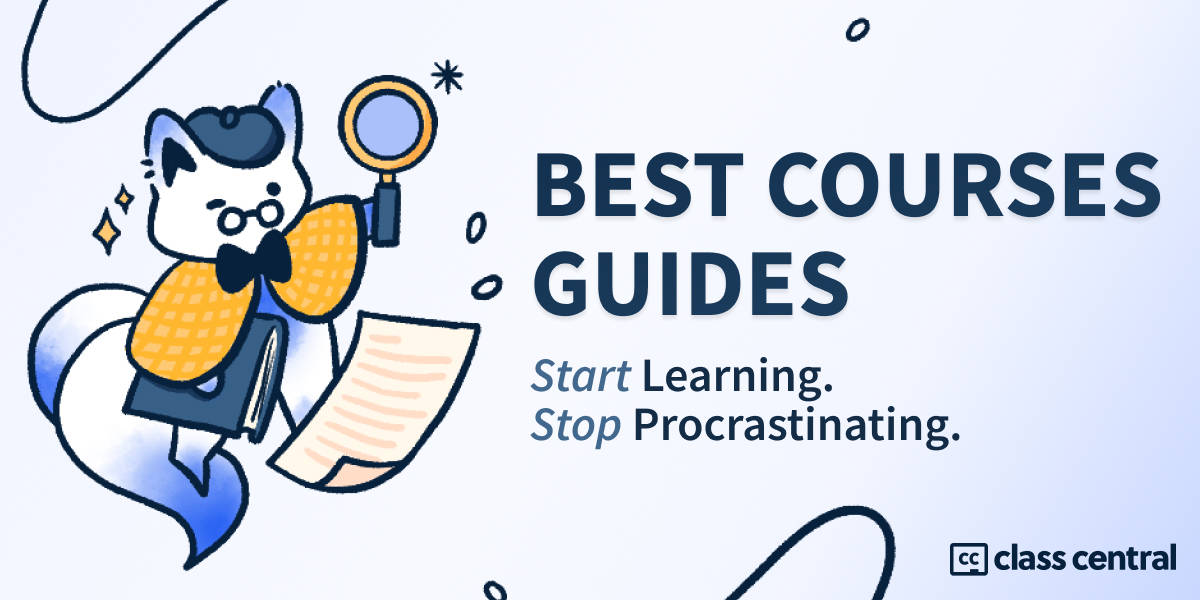
Archisha Bhar
Leave a reply.
This site uses Akismet to reduce spam. Learn how your comment data is processed .
Browse our catalog
Discover thousands of free online courses from top universities around the world like MIT, Stanford, and Harvard.
Computer Science 38,828 courses
- Artificial Intelligence
- Algorithms and Data Structures
- Internet of Things
- Information Technology
- Computer Networking
- Machine Learning
- Deep Learning
- Cryptography
- Quantum Computing
- Human-Computer Interaction (HCI)
- Distributed Systems
- Blockchain Development
- Operating Systems
- Computer Graphics
- Automata Theory
- Digital Image Processing
Business 29,454 courses
- Management & Leadership
- Entrepreneurship
- Strategic Management
- Industry Specific
- Business Intelligence
- Human Resources
- Project Management
- Design Thinking
- Business Software
- Customer Service
- Nonprofit Management
- Operations Management
- Corporate Governance
- Business Plan
- Business Proposal
Humanities 10,171 courses
- Language Learning
- Grammar & Writing
- Linguistics
- Library Science
- Crisis Management
- Emergency Management
- Performing Arts
- Religious Studies
Data Science 8,610 courses
- Bioinformatics
- Data Mining
- Data Visualization
- Jupyter Notebooks
- Process Mining
- Text Mining
- Social Network Analysis
- Computational Analysis
- Data Collection
- Information Retrieval
- Data Processing
- Data Wrangling
- Data Extraction
- Data Manipulation
- Monte Carlo Simulation
- Network Analysis
- Data Preparation
Personal Development 11,435 courses
- Career Development
- Self Improvement
- Presentation Skills
- Self-Control
- Growth Mindset
- Self-Assessment
- Survival Skills
- Sleep Improvement
- Career Planning
- Empowerment
- Personal Growth
- Social Skills
- Dog Training
Art & Design 33,054 courses
- Digital Media
- Visual Arts
- Design & Creativity
- Art Therapy
- Art Composition
- Character Design
- Fashion Design
- Inspiration
- Golden Ratio
- Pattern Design
- Geometric Patterns
- Copic Markers
- Jewelry Design
- Botanical Drawing
- Animal Illustration
- Anime Drawing
- Observational Drawing
- Clay Modeling

IMAGES
VIDEO
COMMENTS
In this module, you will learn how to construct powerful accomplishment statements, how to write effective summary sections and job objectives, how to select action words to present you as a doer and achiever, and how to use two web resources that can help you find powerful language for your resume.
Learn the ins and outs of writing the perfect resume with our complete guide! Check out expert tips, real-life examples, and more!
Learn how to identify important resume keywords, format your resume, and write each section in this comprehensive guide. Your resume is a document that encompasses your entire professional journey, showing where you currently are in your career, how you got there, and where you hope to go next.
Create a resume that impresses hiring managers and speaks to your personal and professional strengths. Learn about the nuts and bolts of resume formatting, layout, and word choice.
In this project-centered course*, you will craft an essential cornerstone of the modern-day job or internship search: the resume. You’ll review resume best practices and explore current trends with guidance from a professional career counselor and recruiter, and you’ll exchange structured feedback with your peers as you work to polish your ...
The fundamental structure and essential elements of a resume and cover letter. How to tailor your resume and cover letter to match job descriptions. Strategies to enhance the appeal of your resume and cover letter. Common mistakes in resume and cover letter writing and how to avoid them.